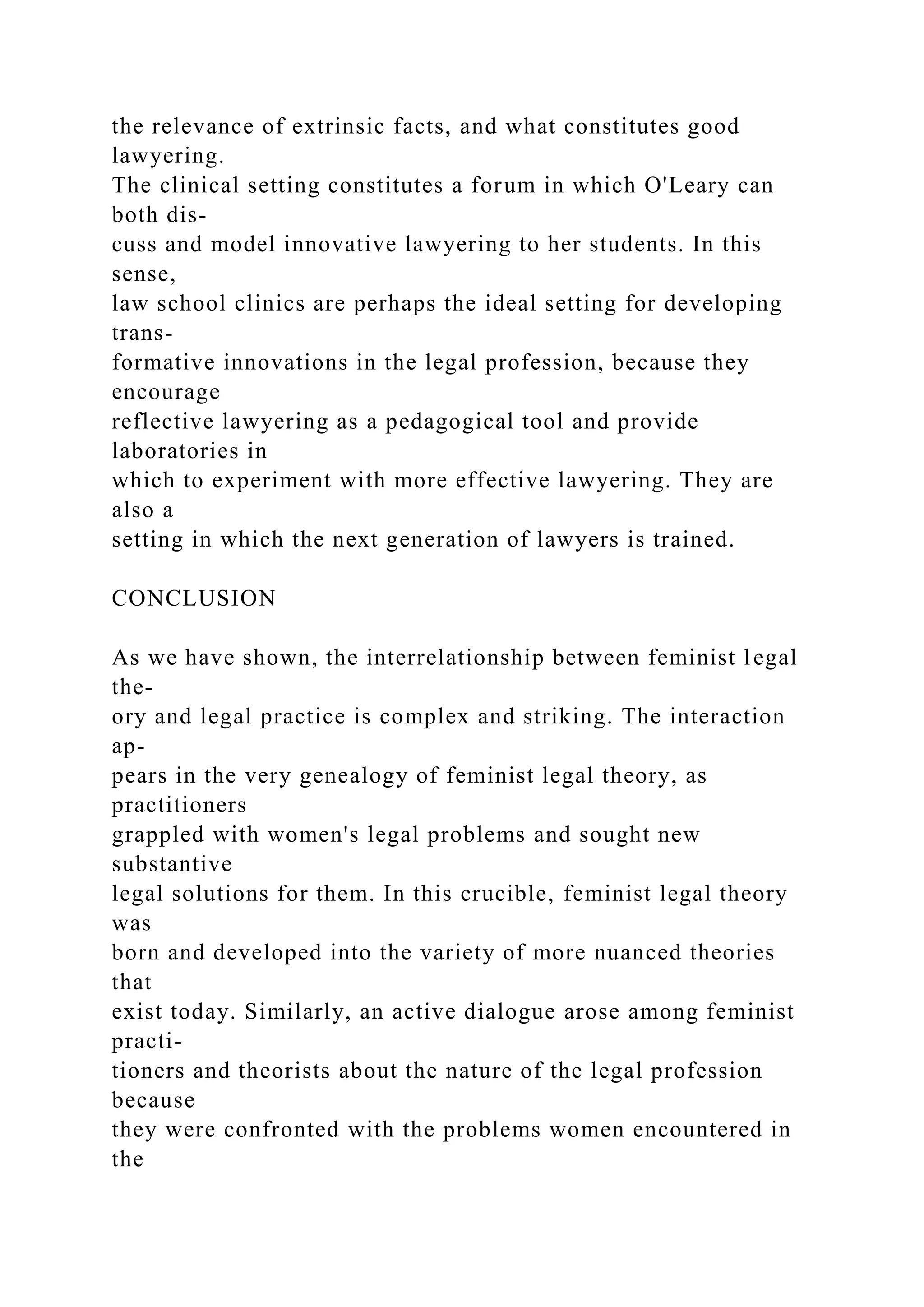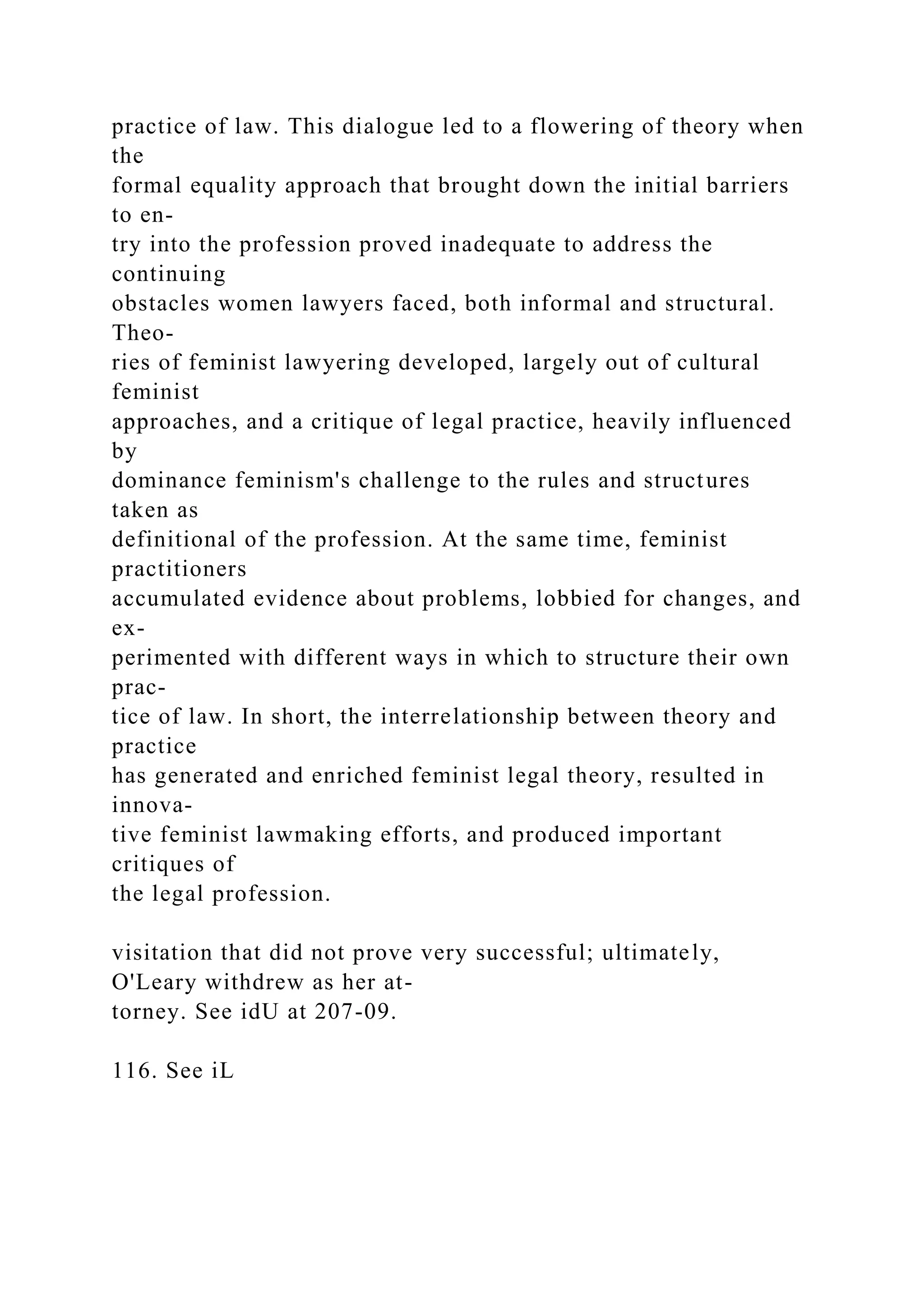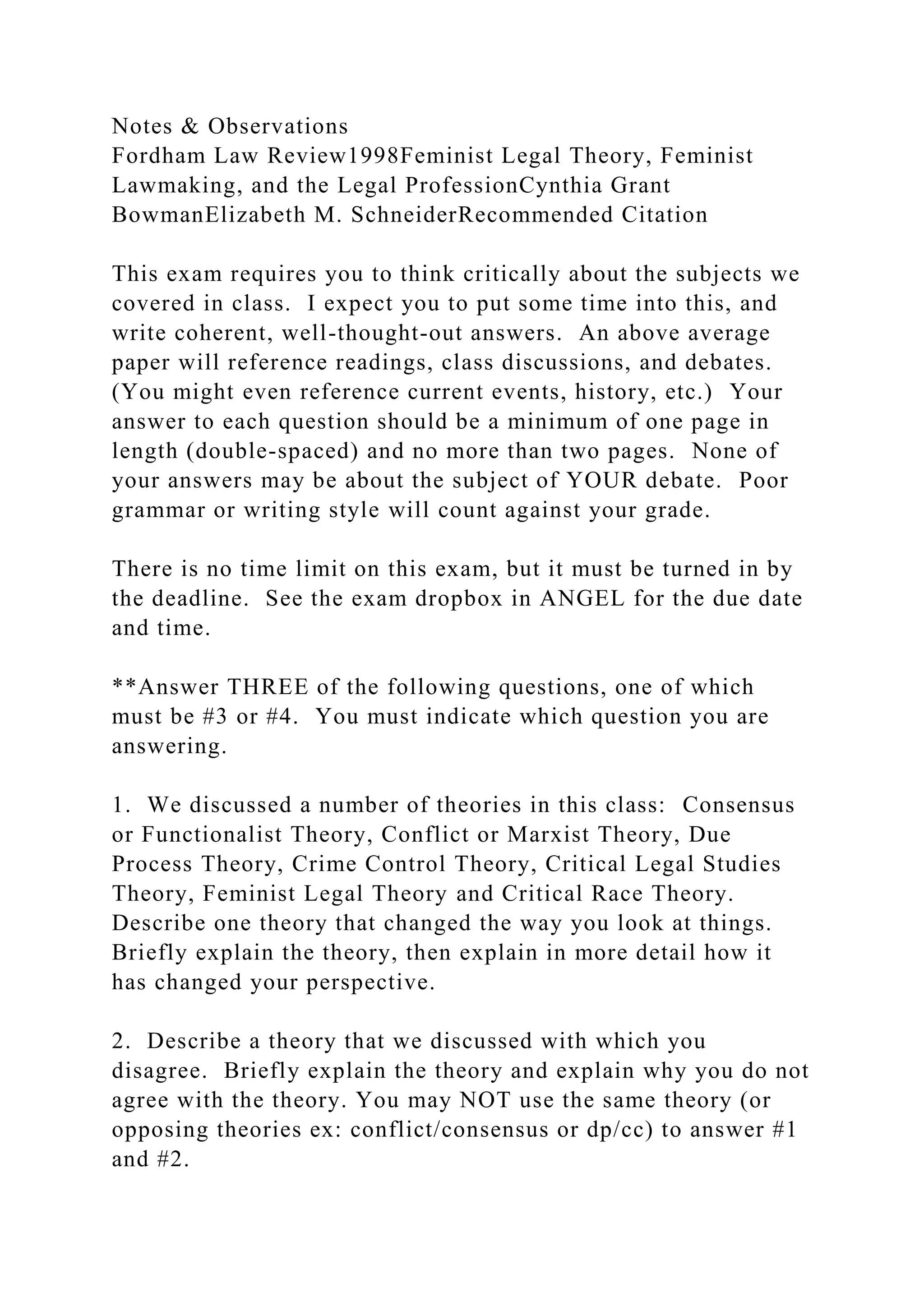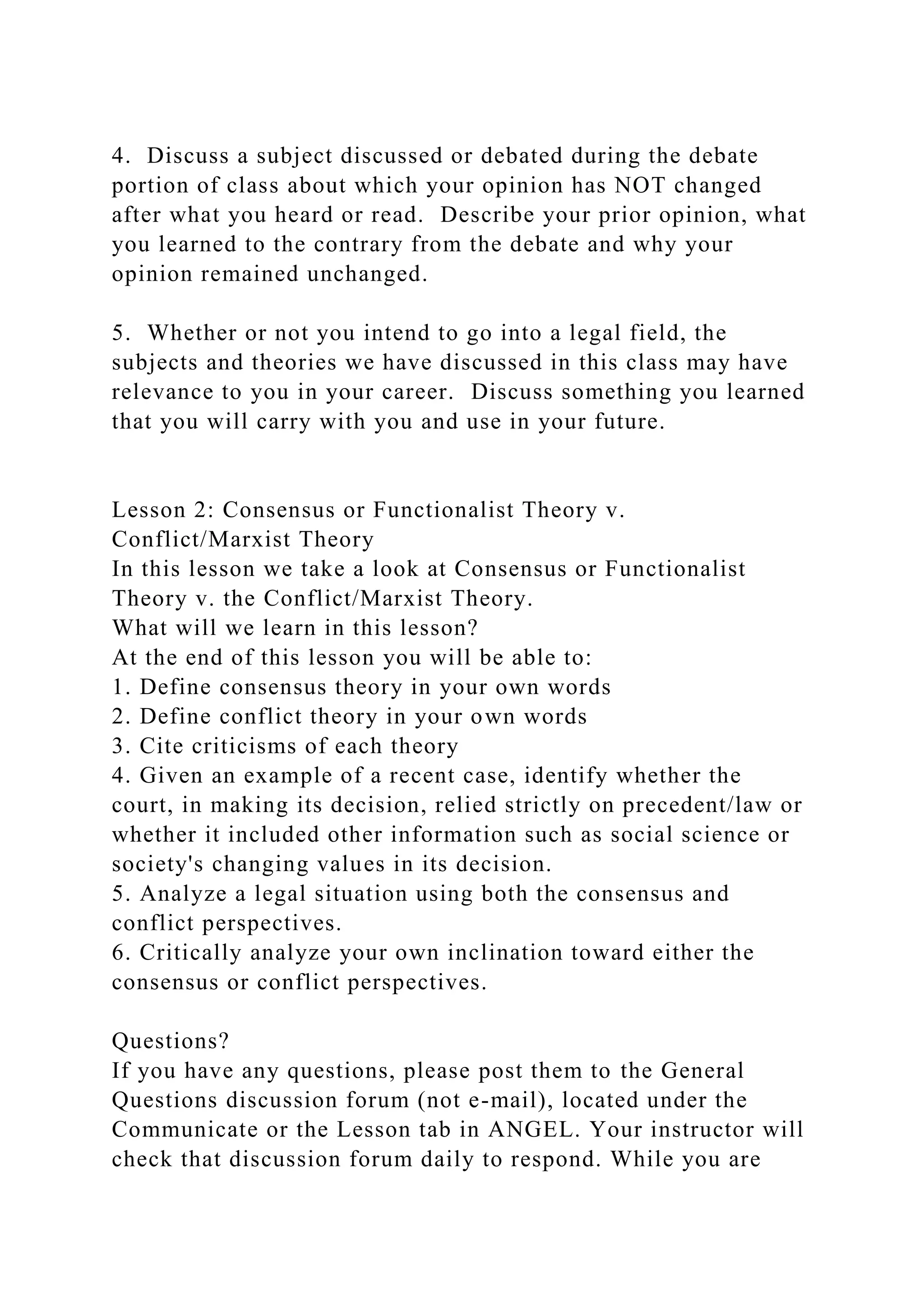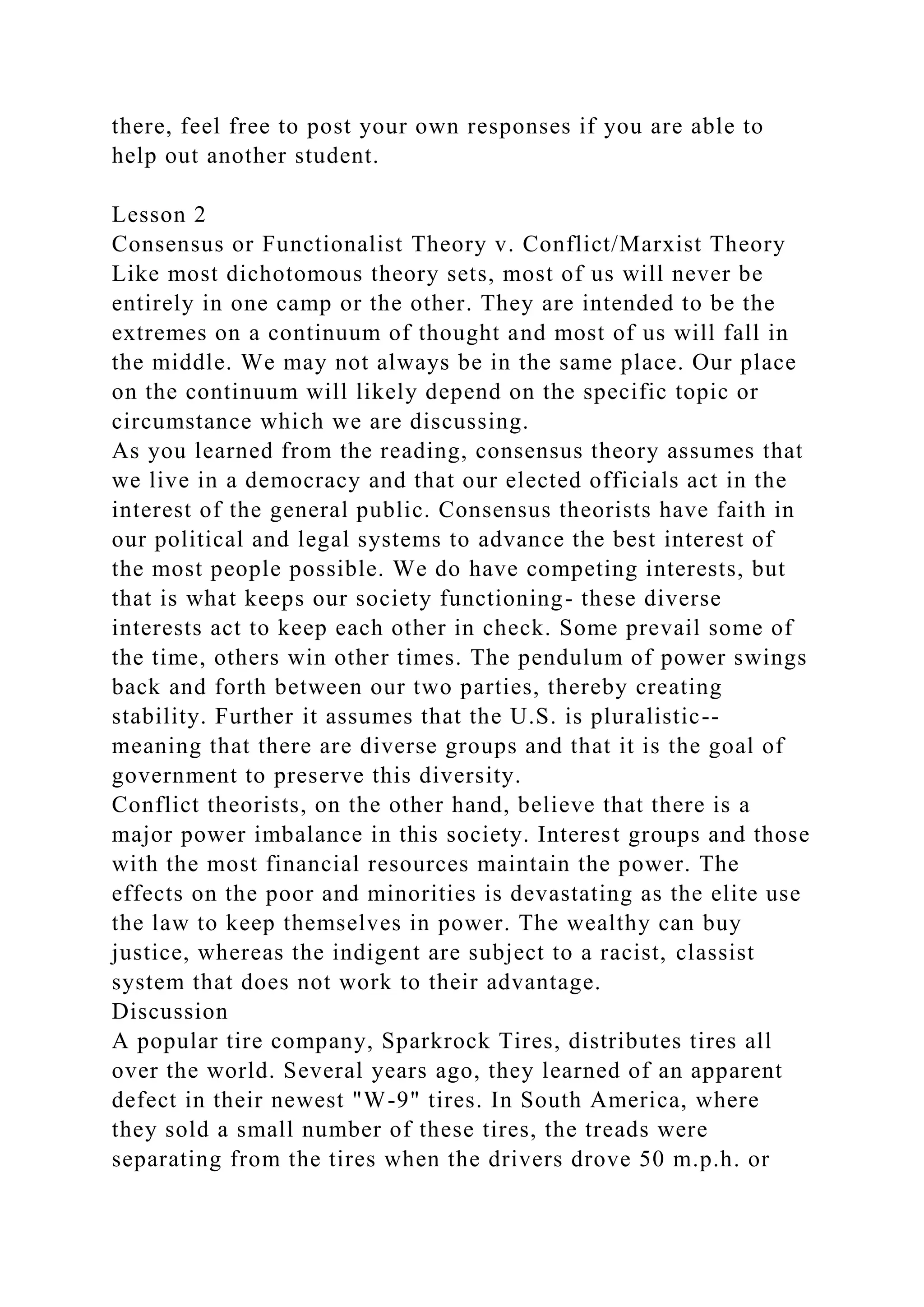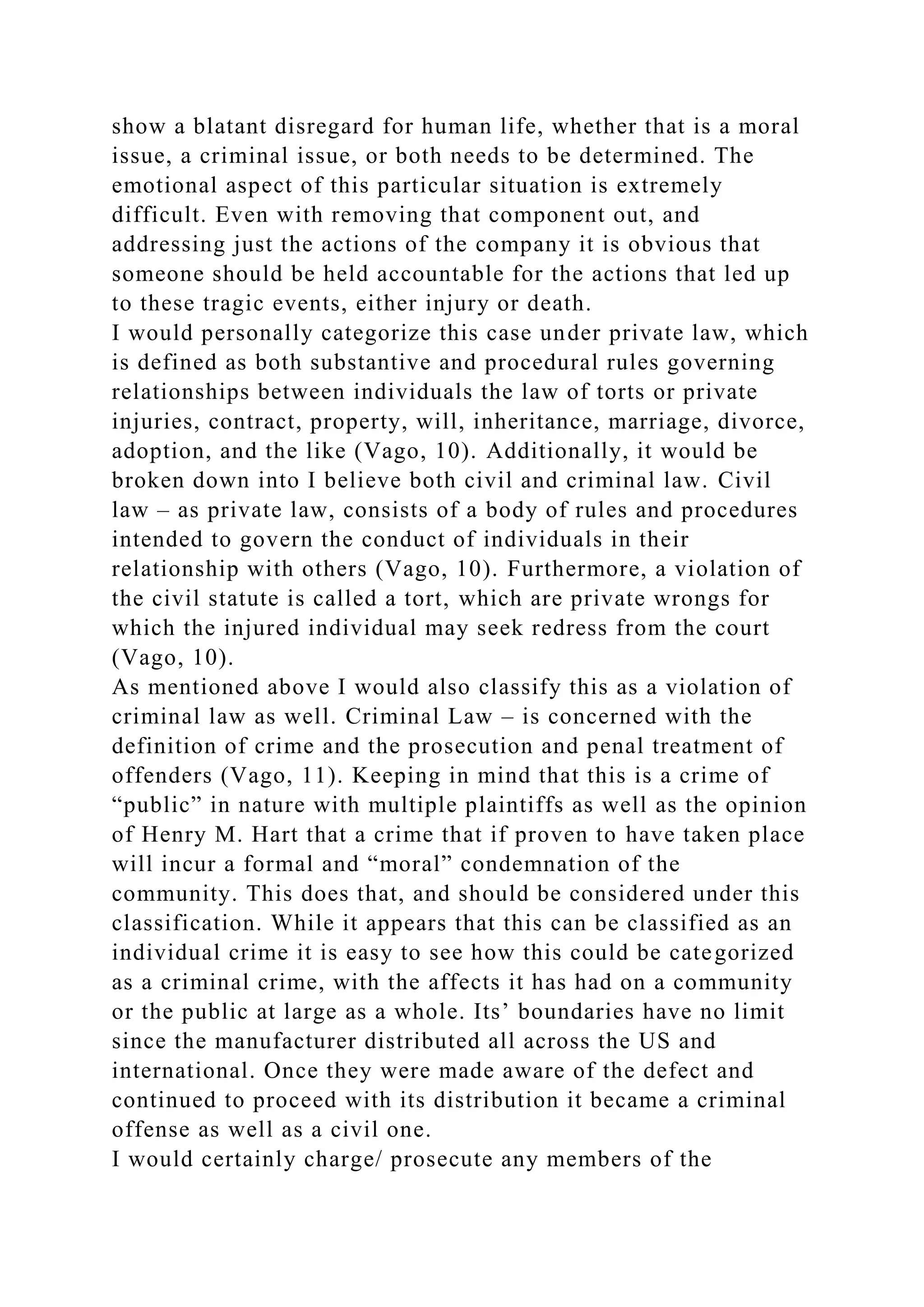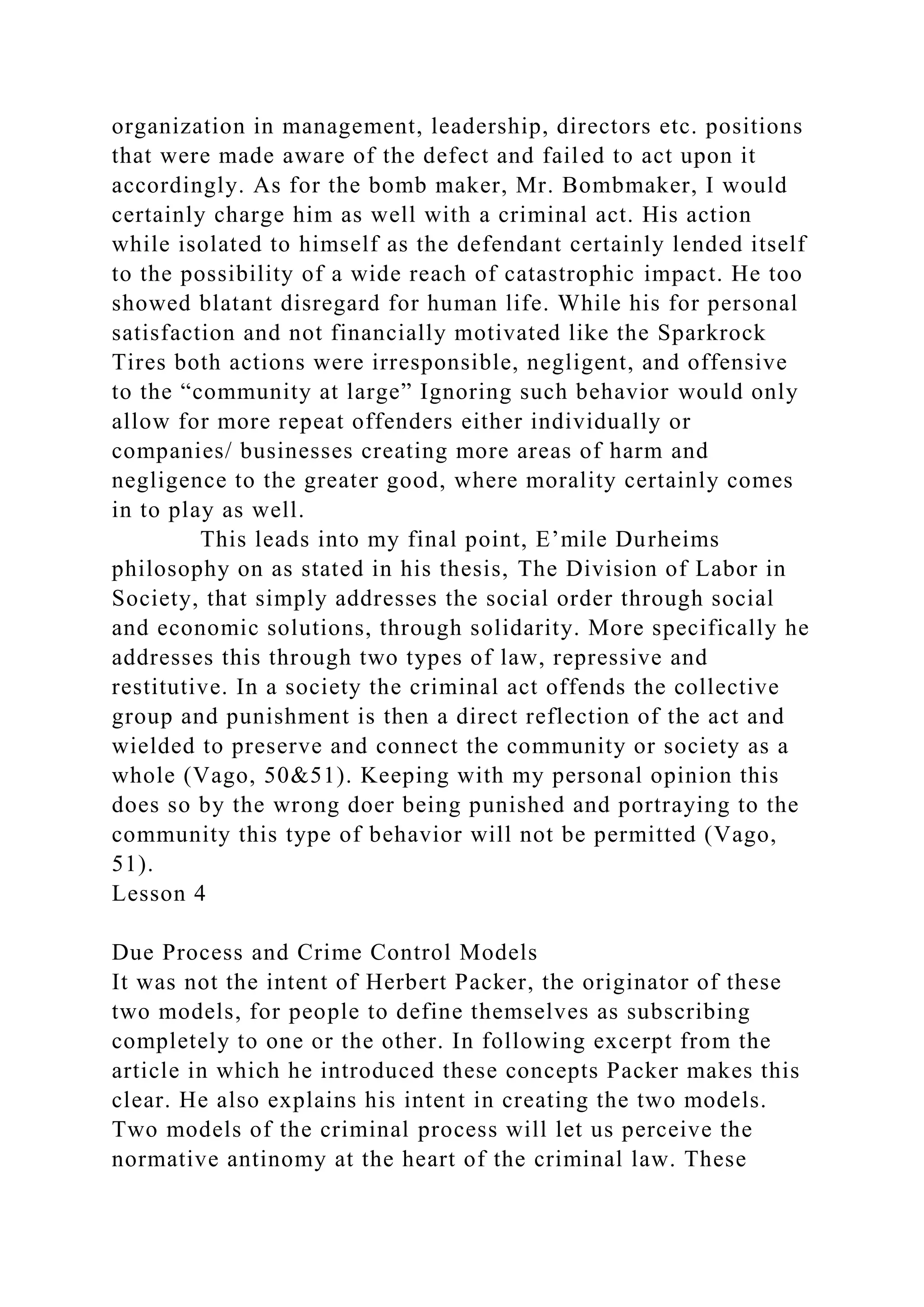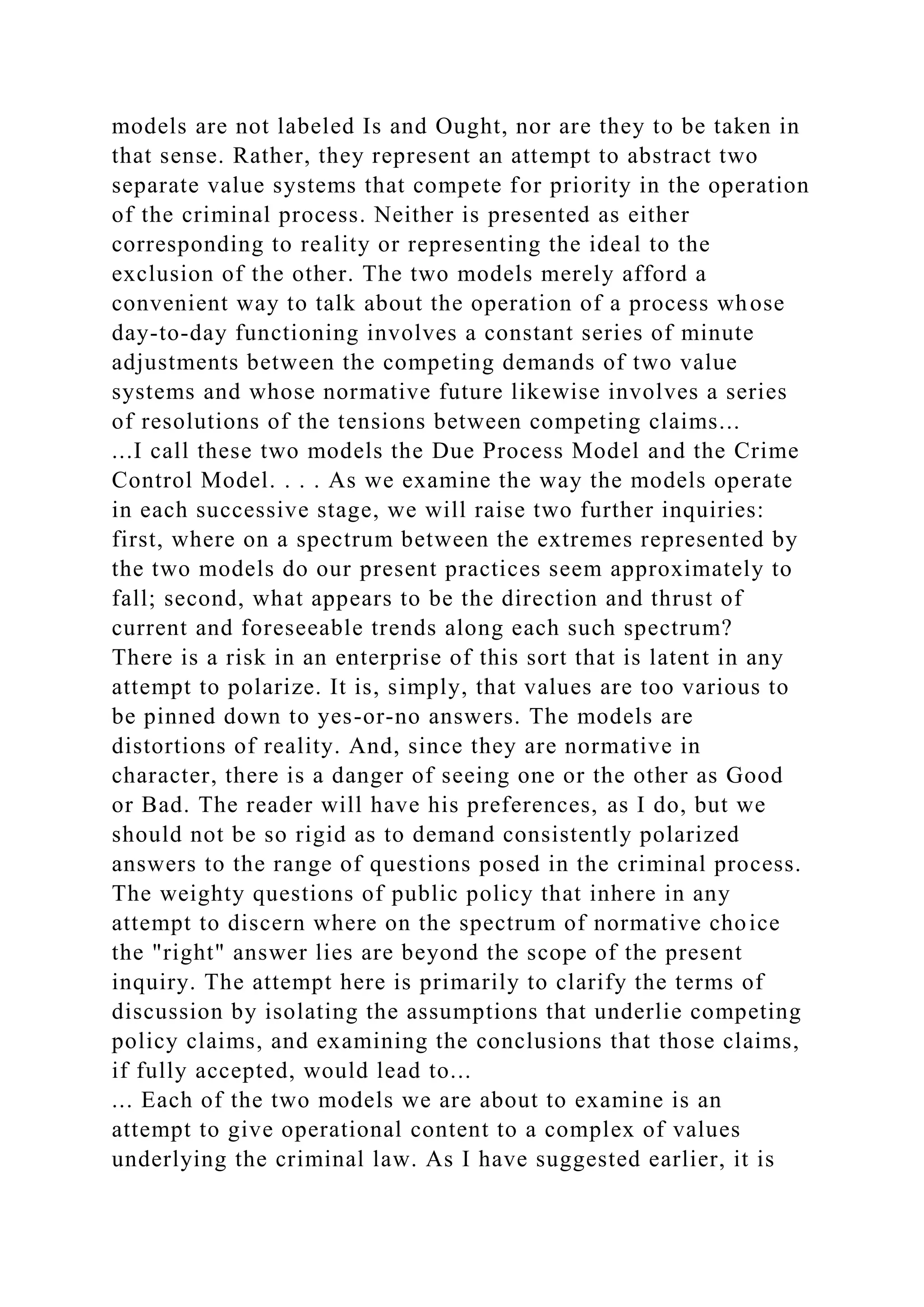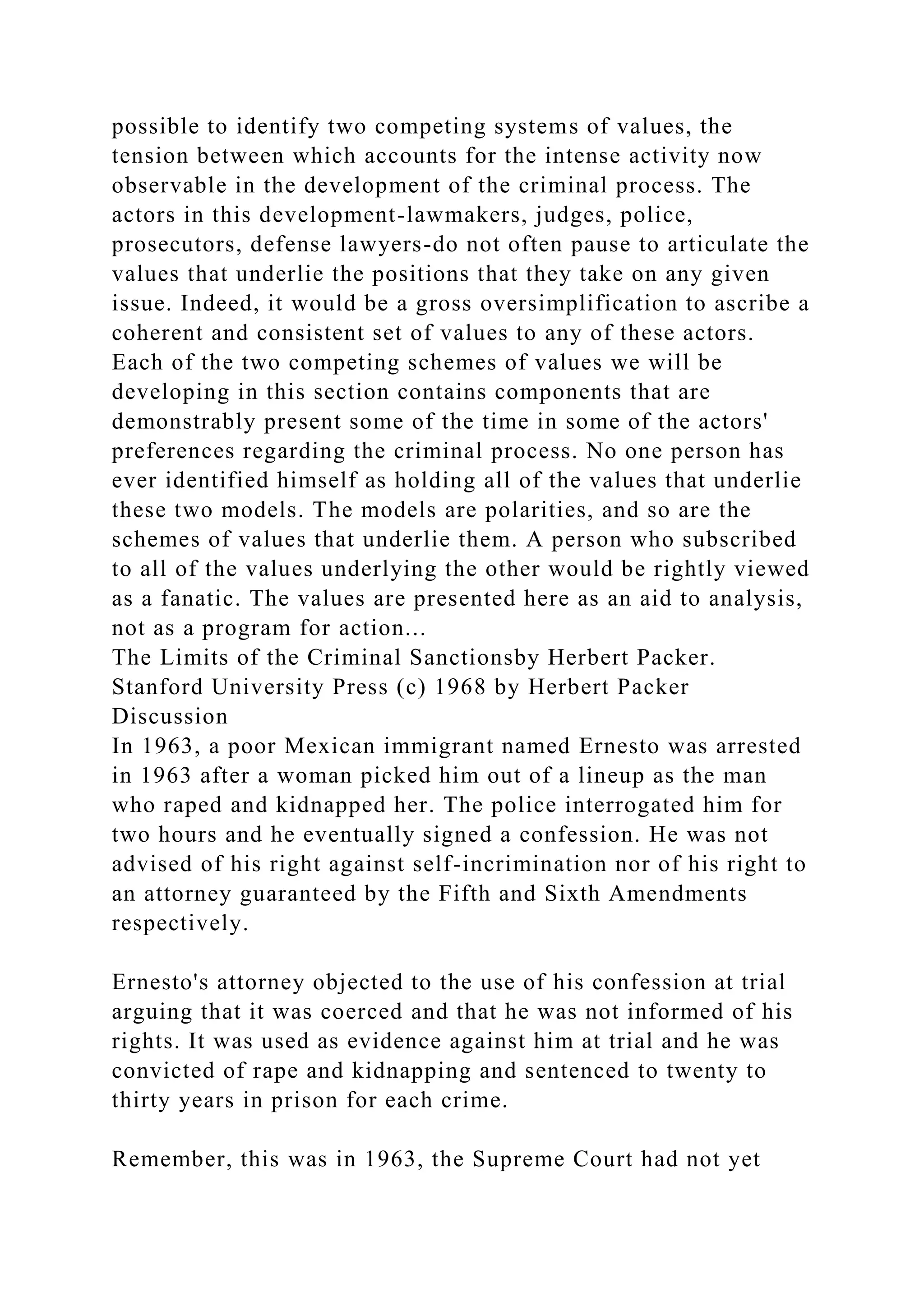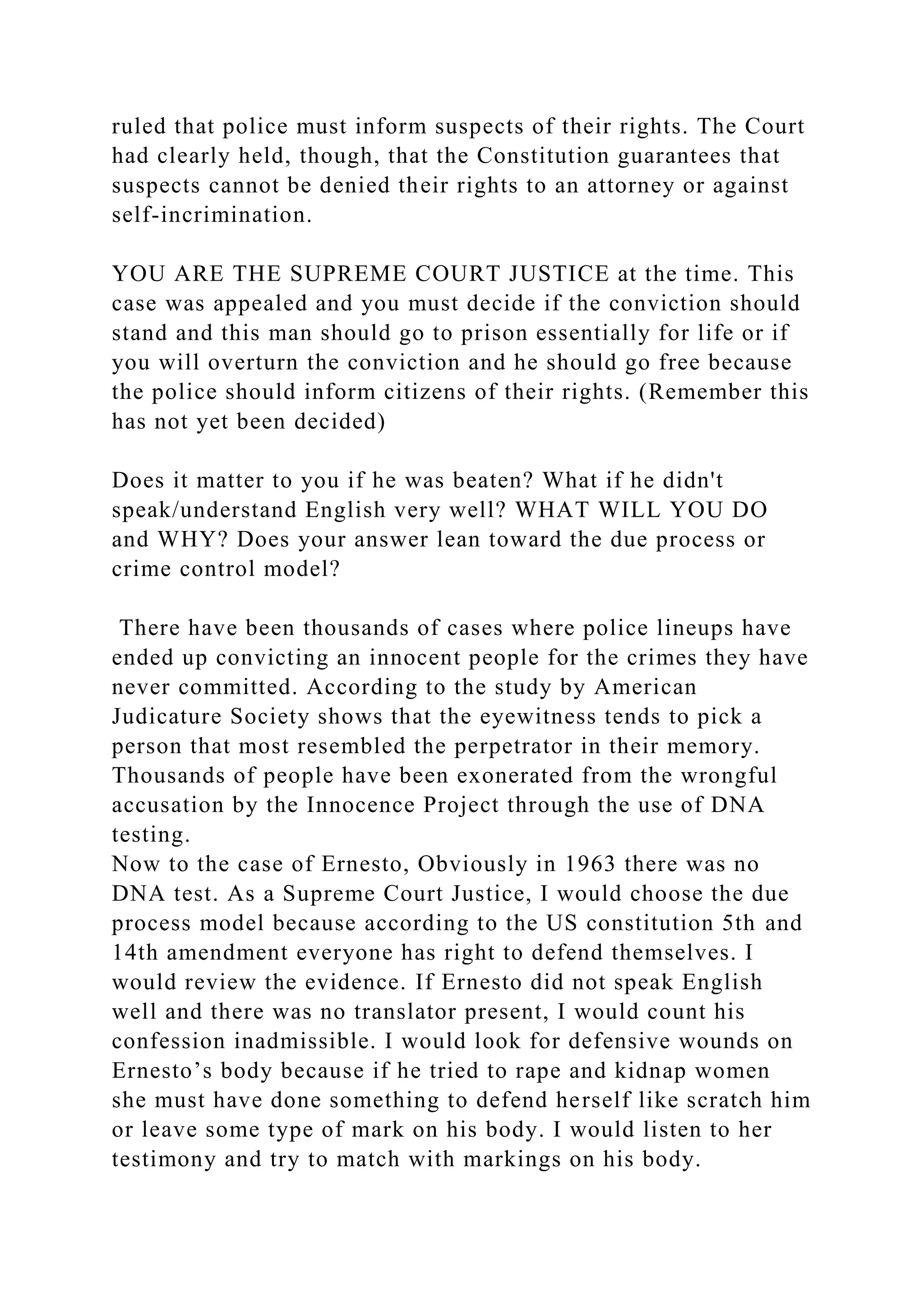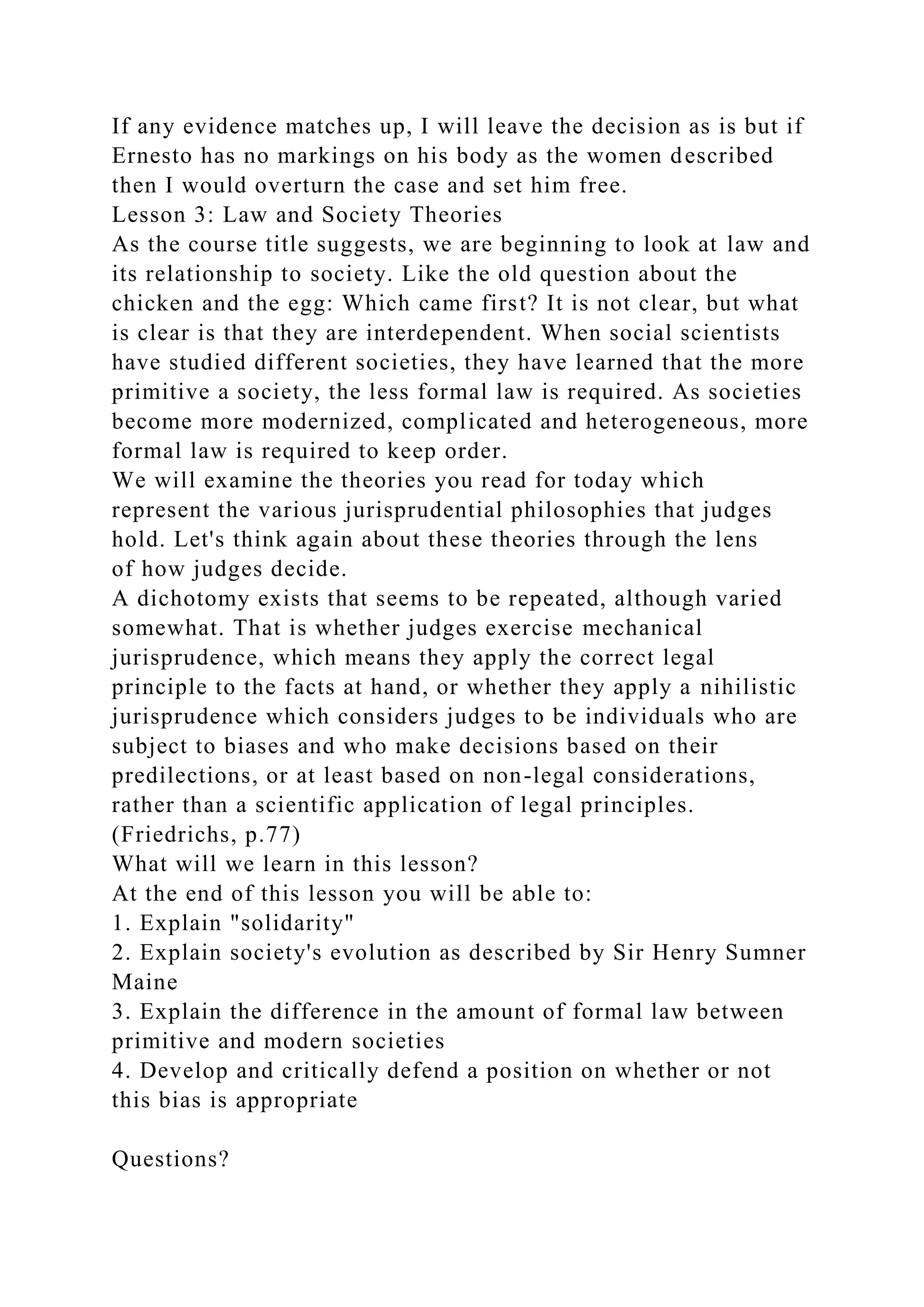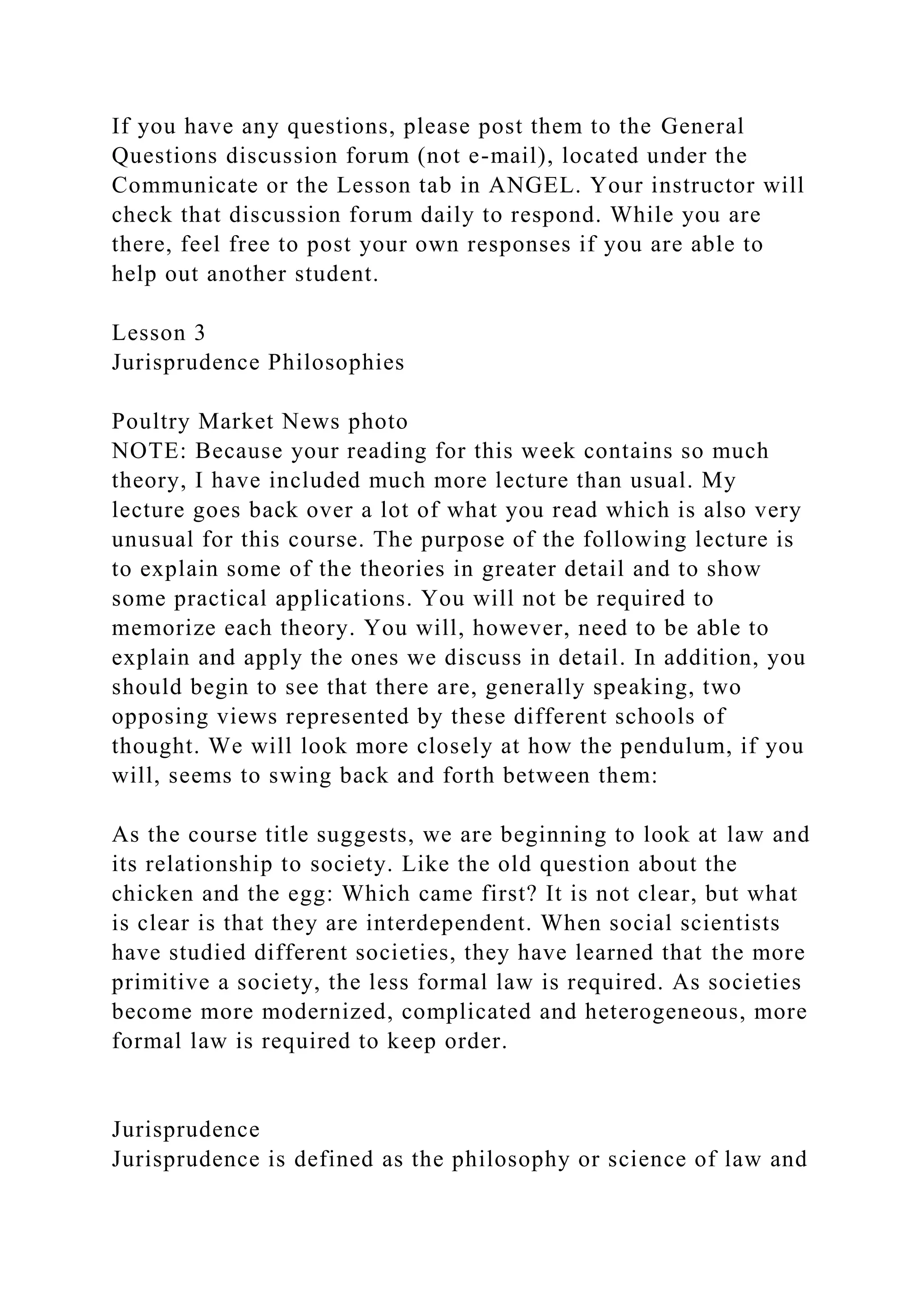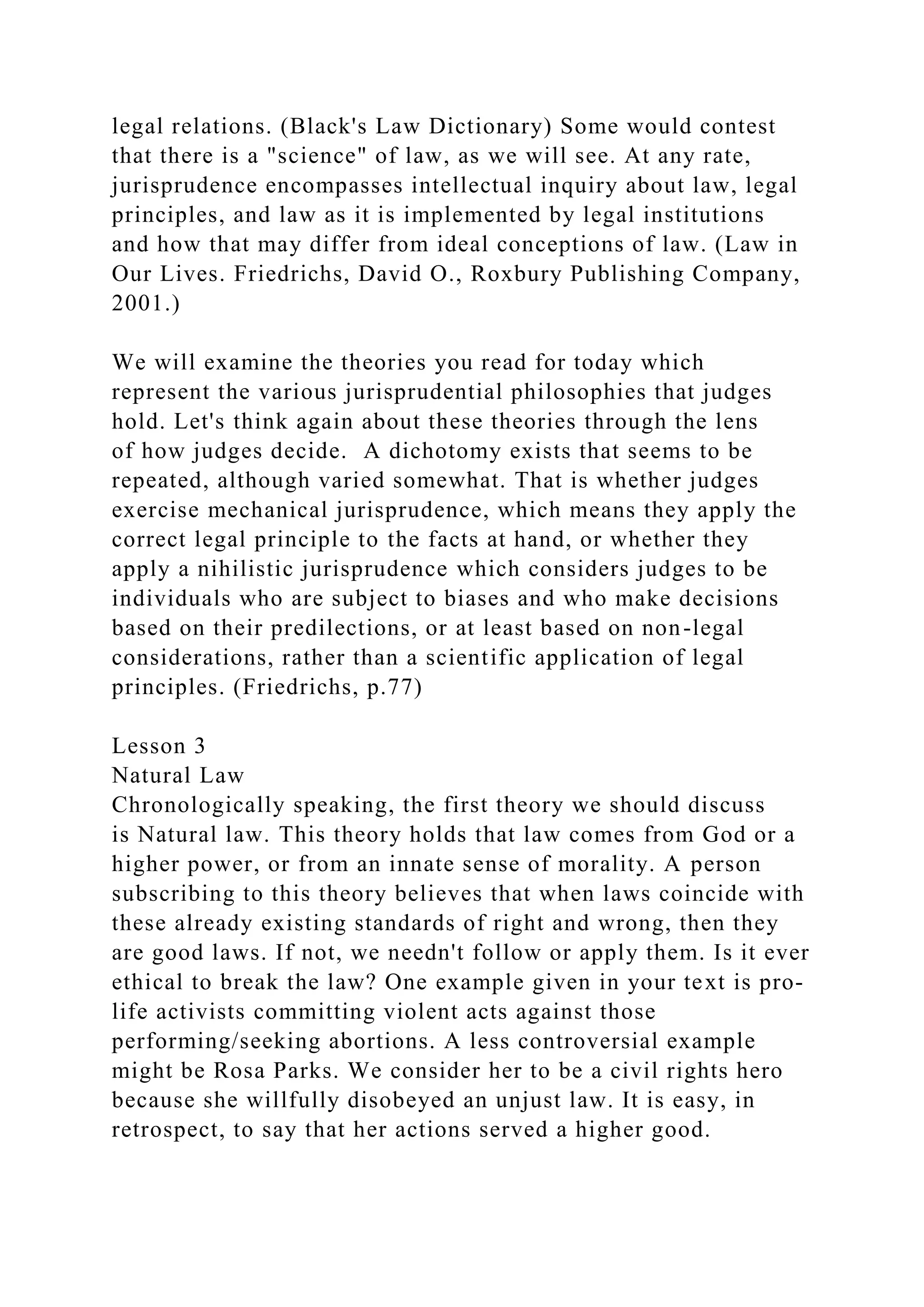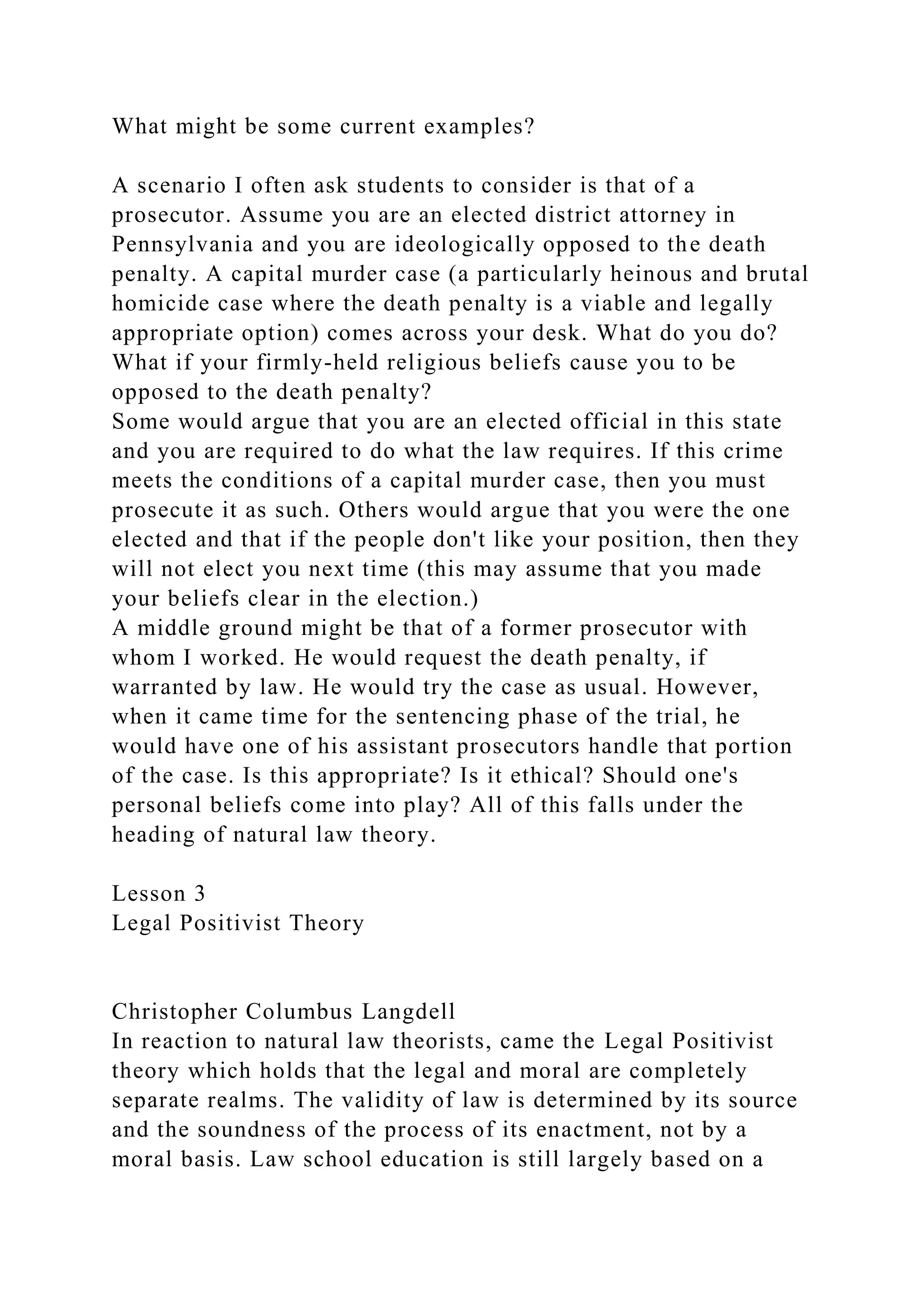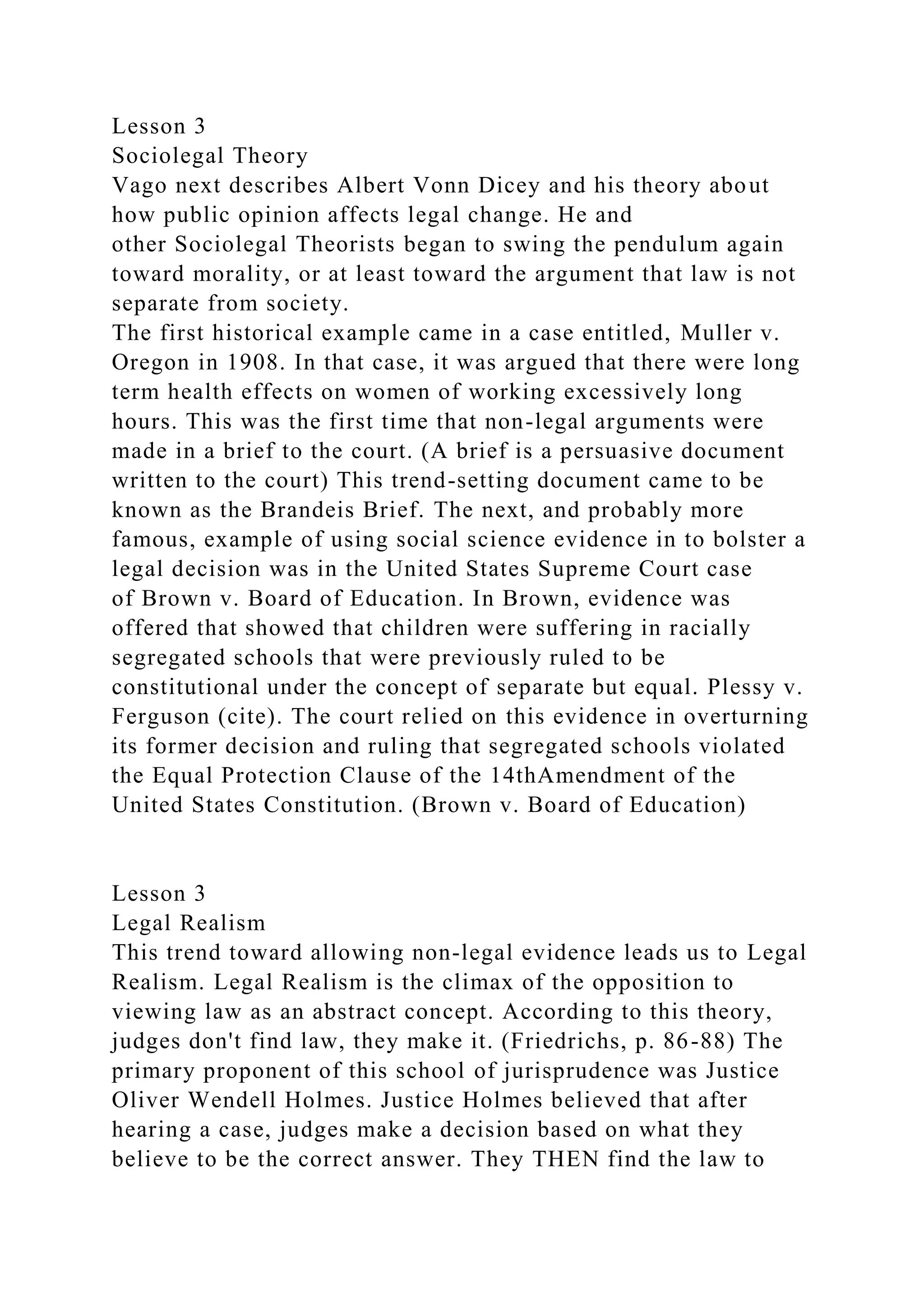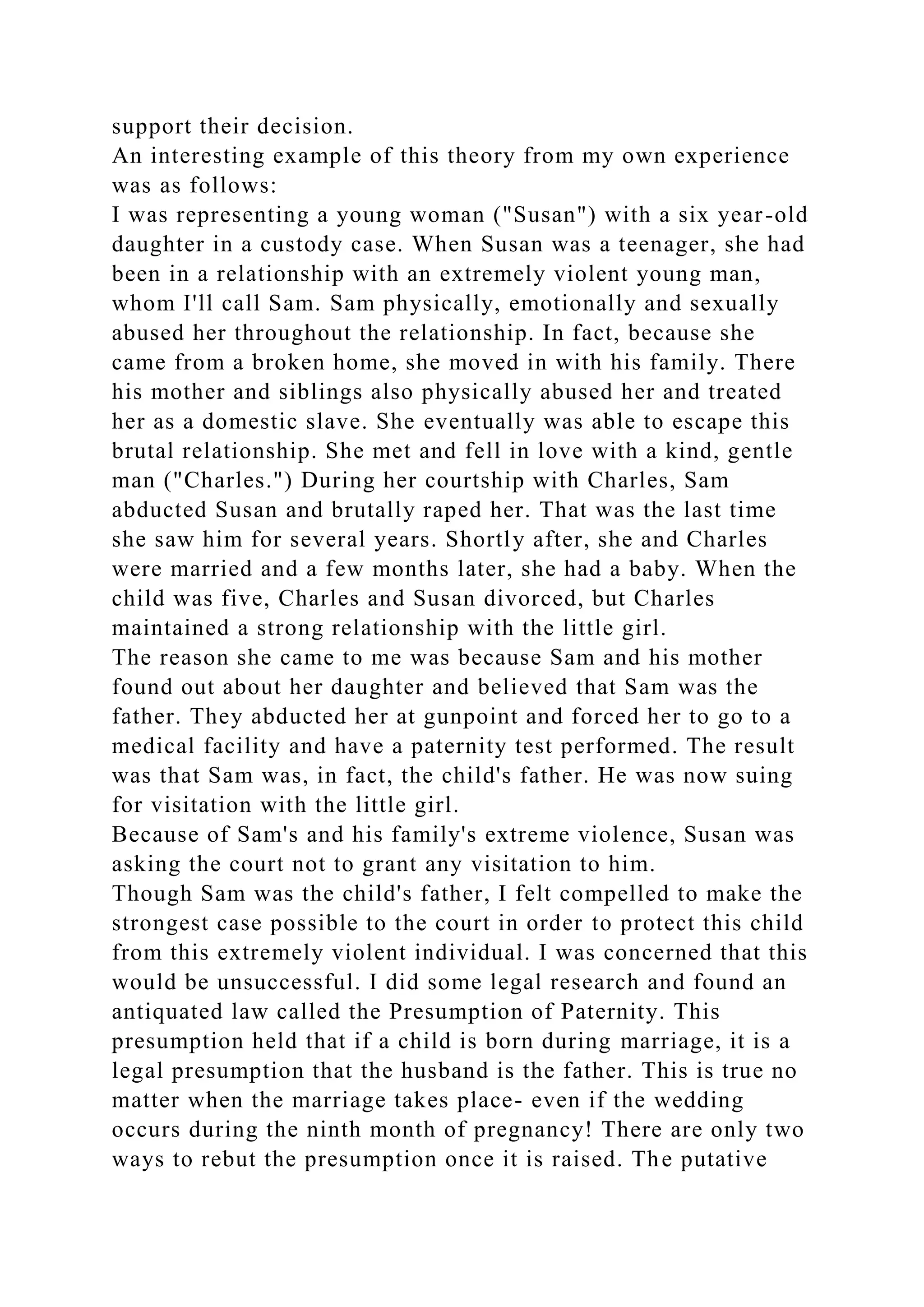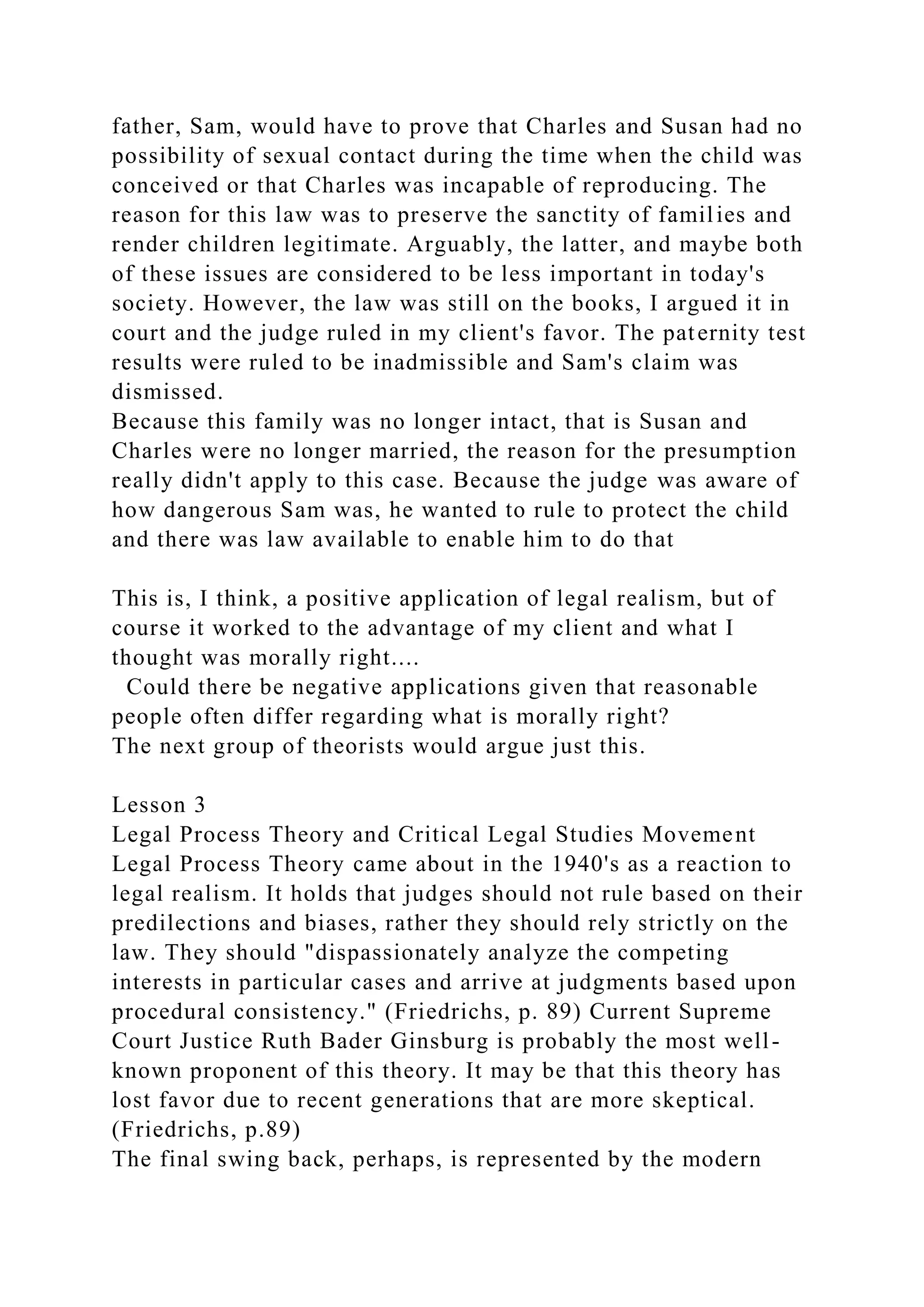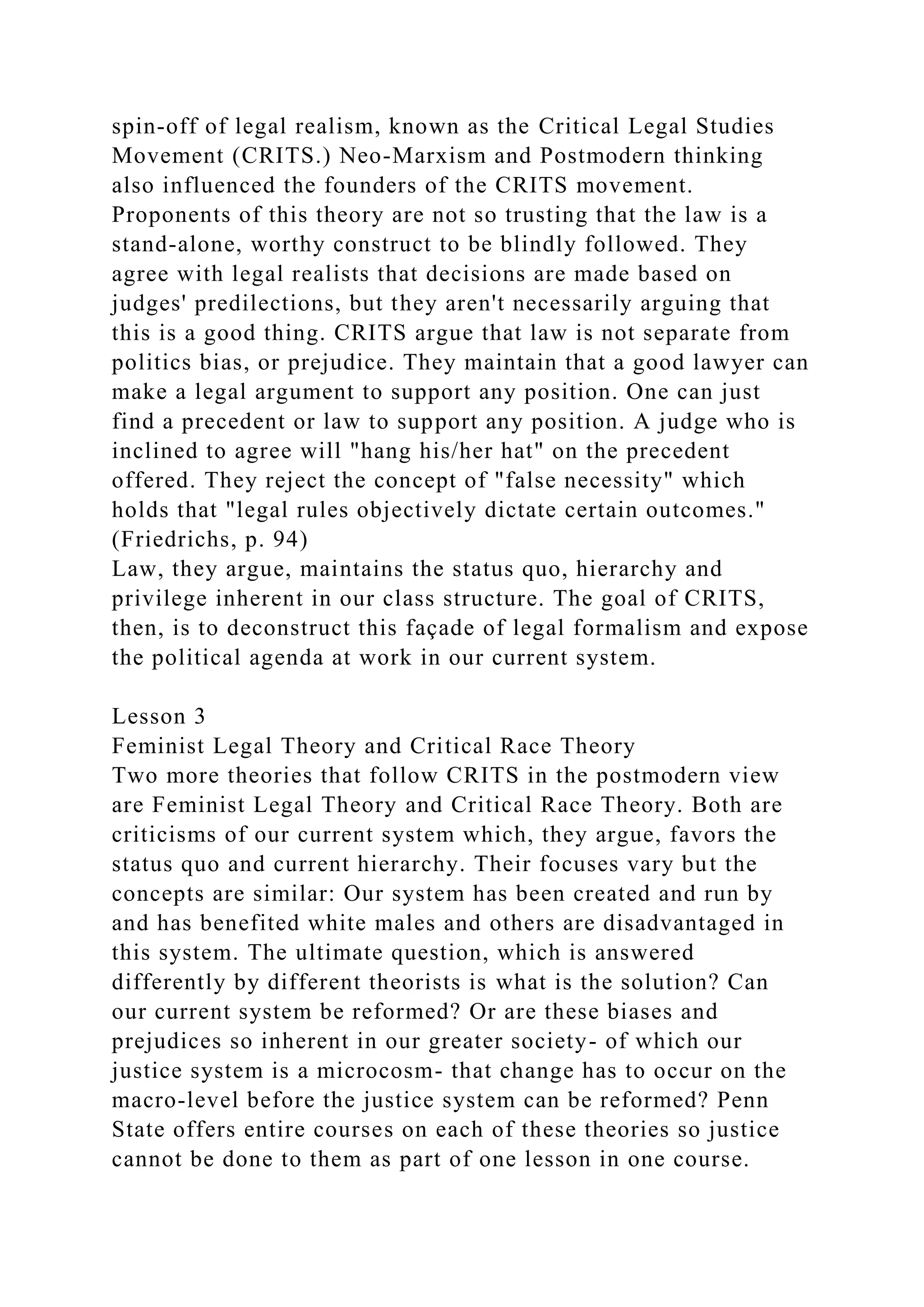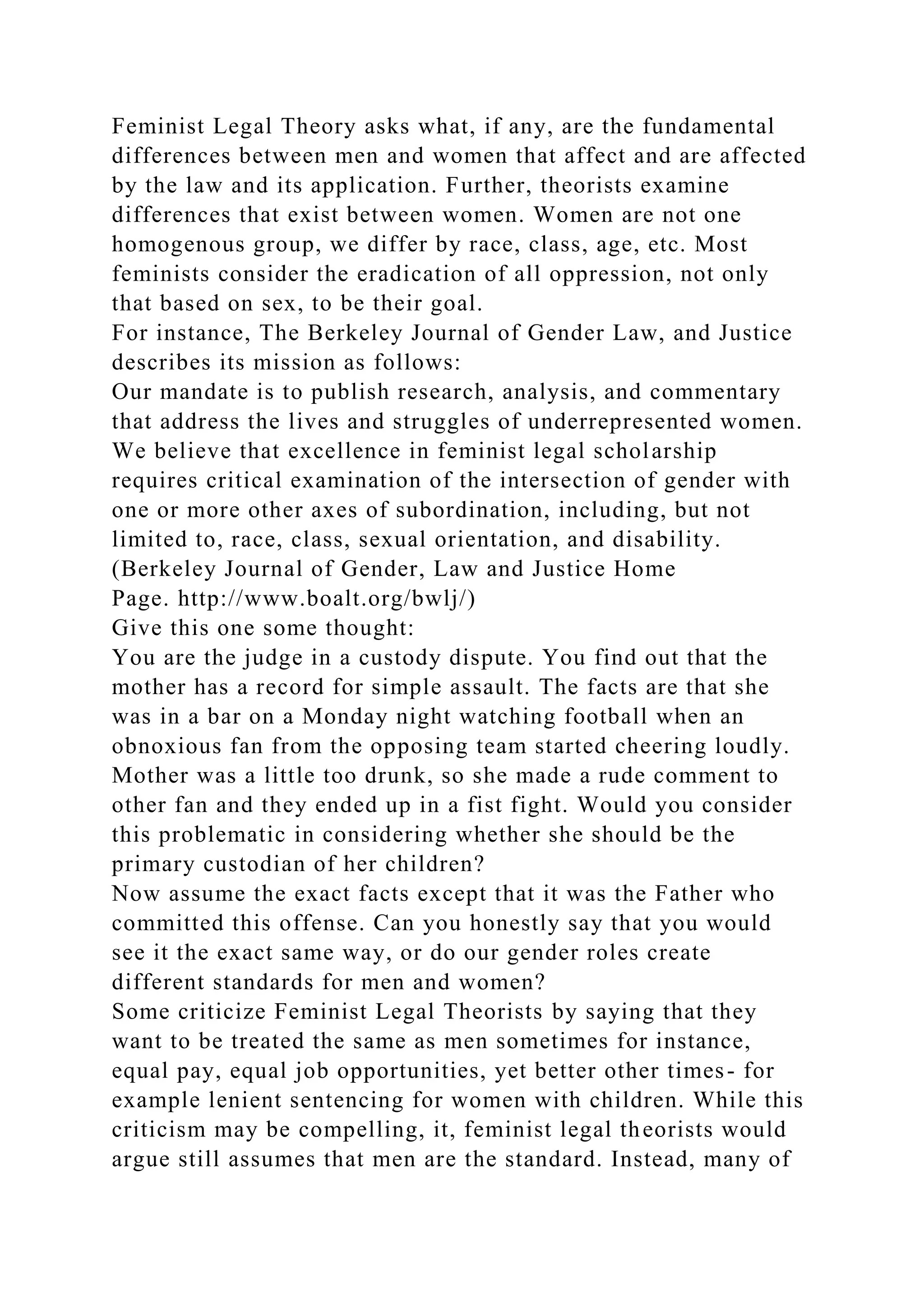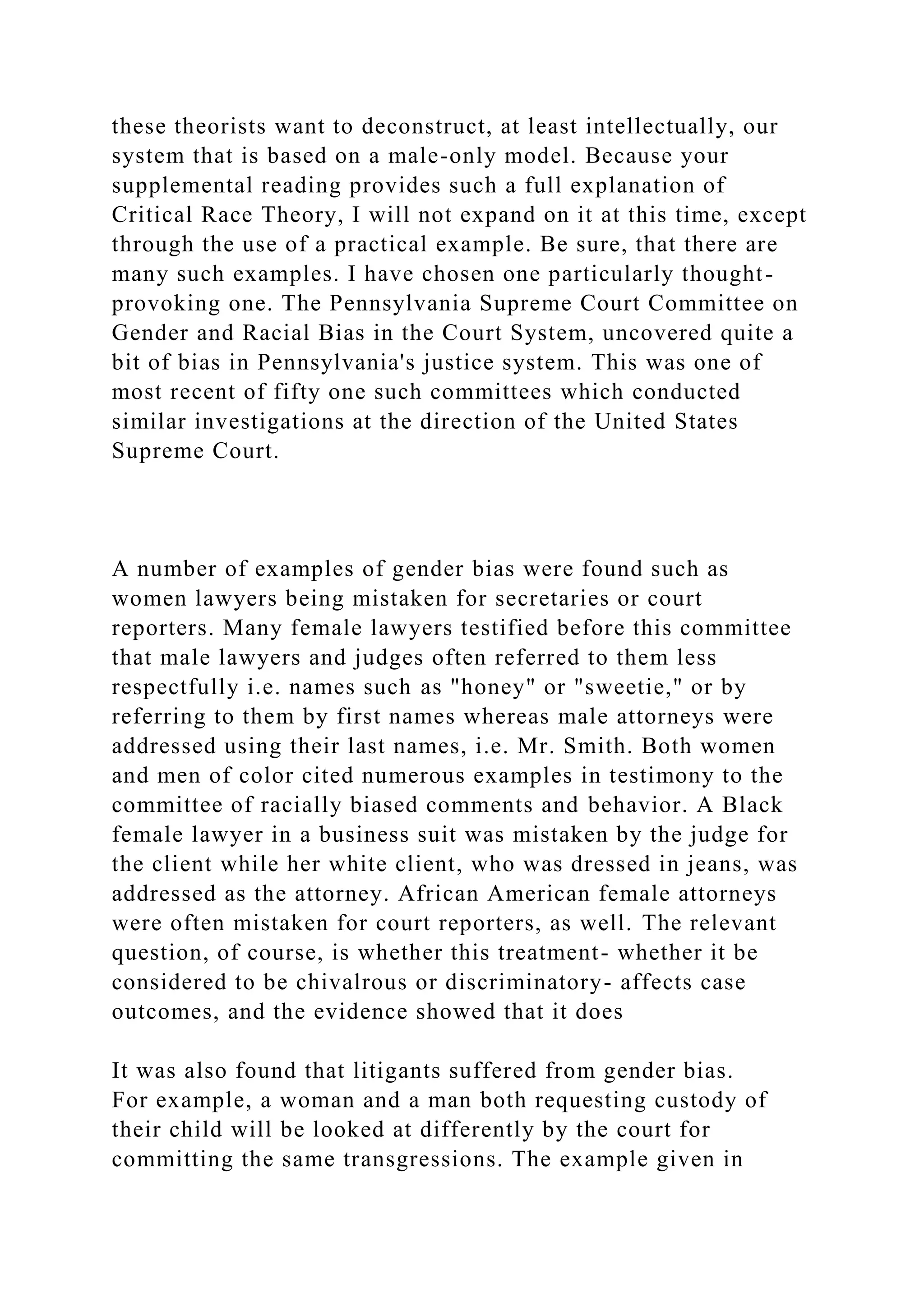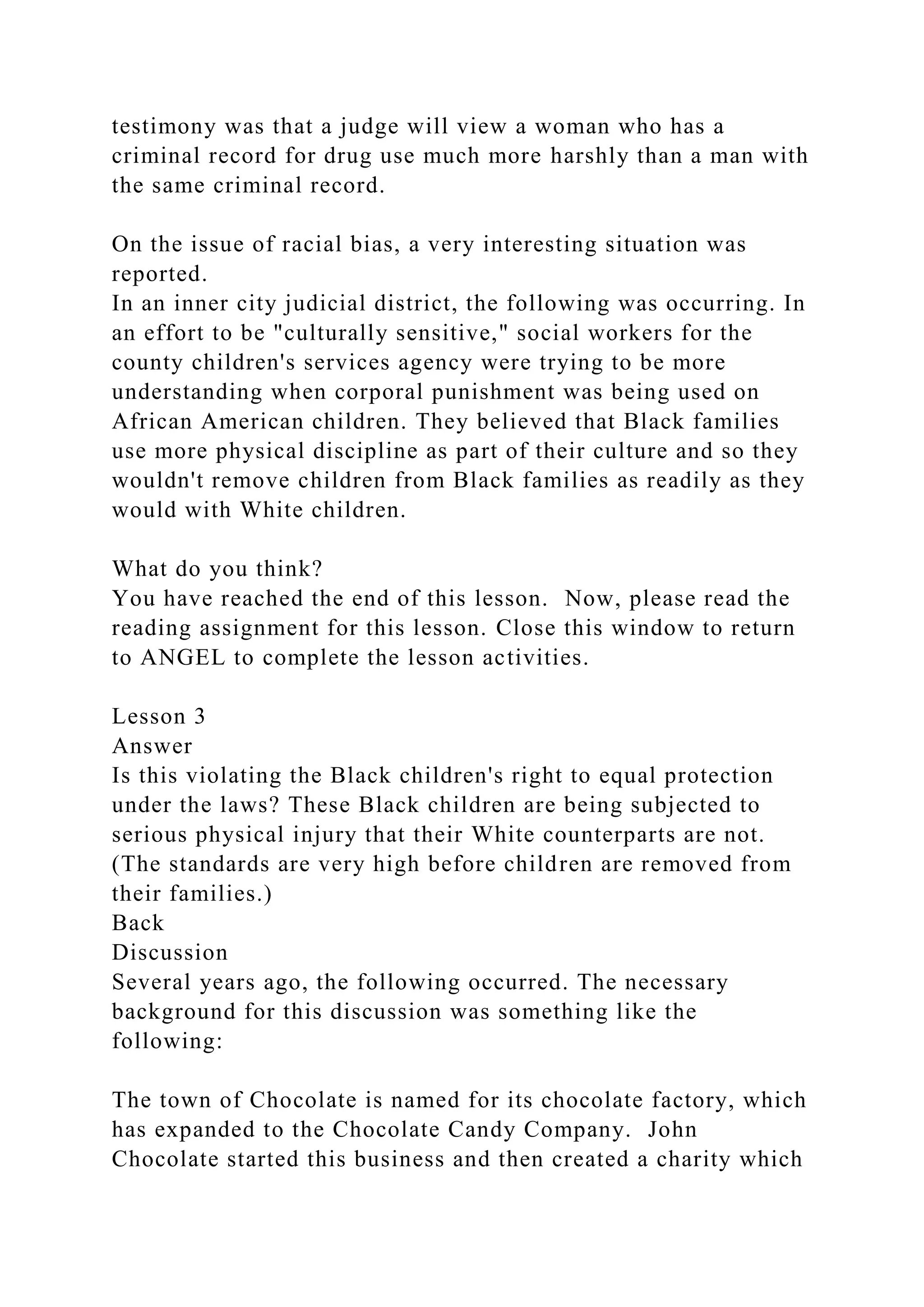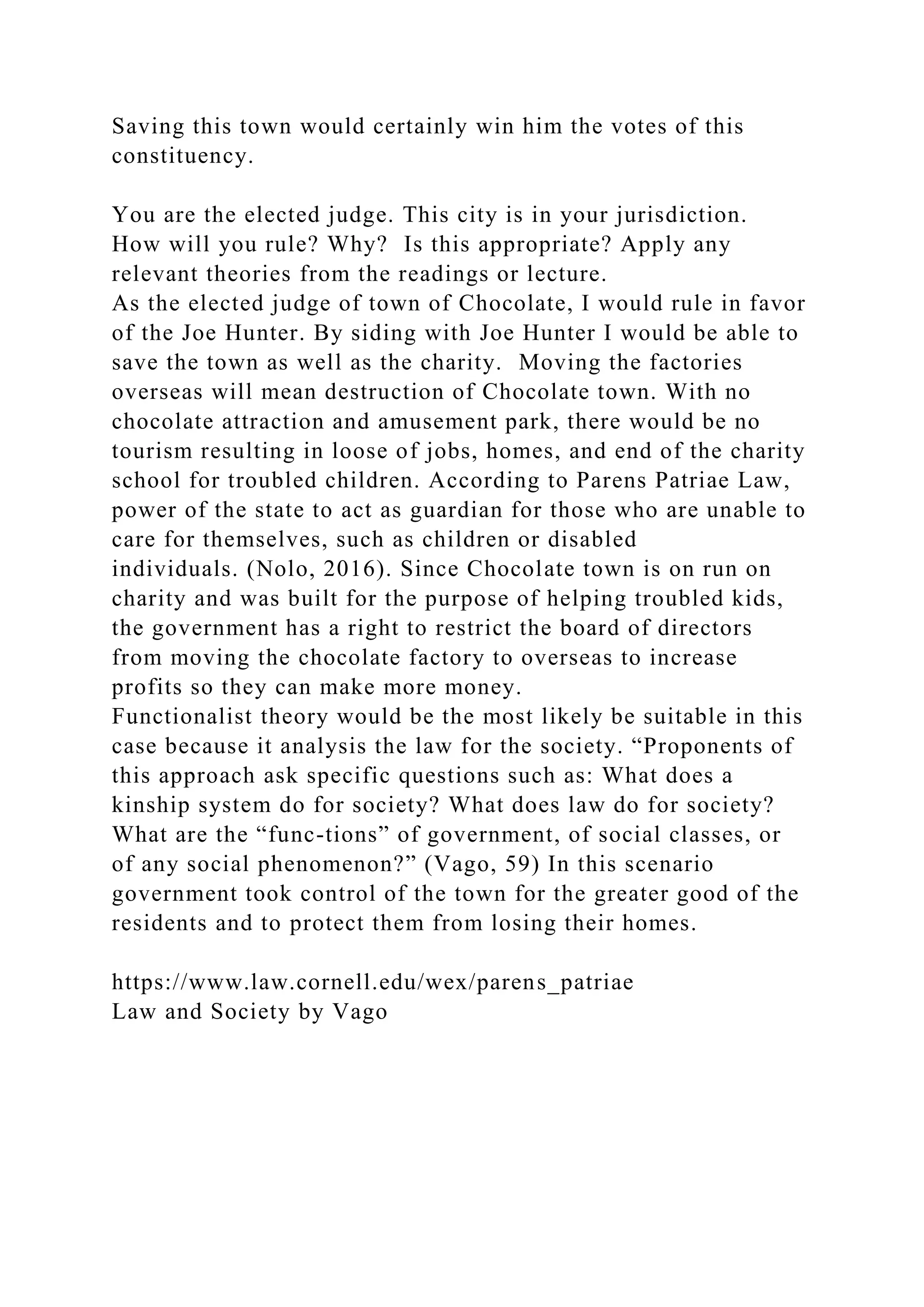Herbert L. Packer discusses two contrasting models of the criminal process: the due process model, which emphasizes individual rights, and the crime control model, which prioritizes the regulation of criminal conduct. He examines these models to reveal underlying normative tensions in the criminal justice system, highlighting their operational implications within the context of American society. While neither model fully captures reality, they serve as frameworks for analyzing competing values and assumptions that shape criminal law and policy.

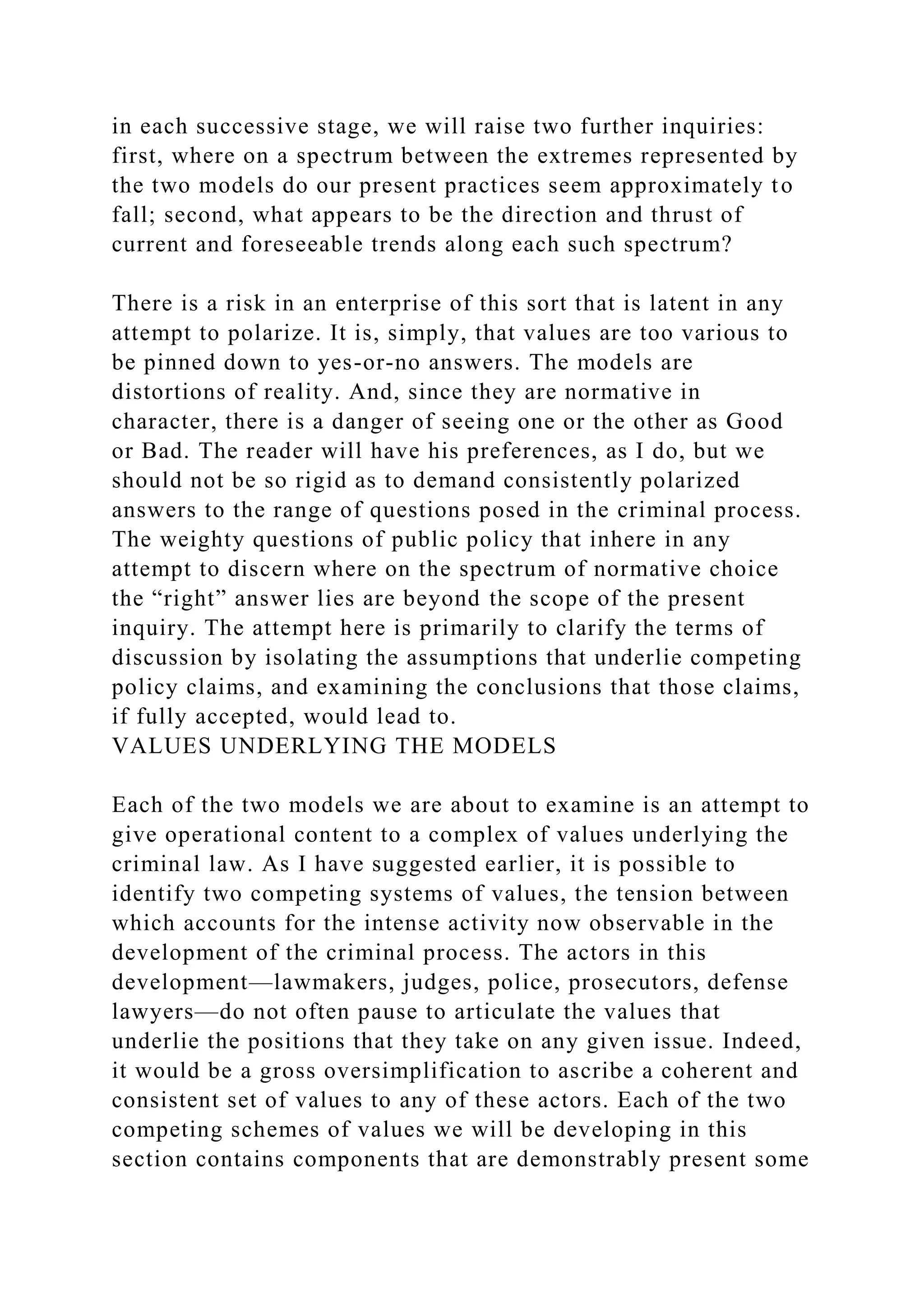
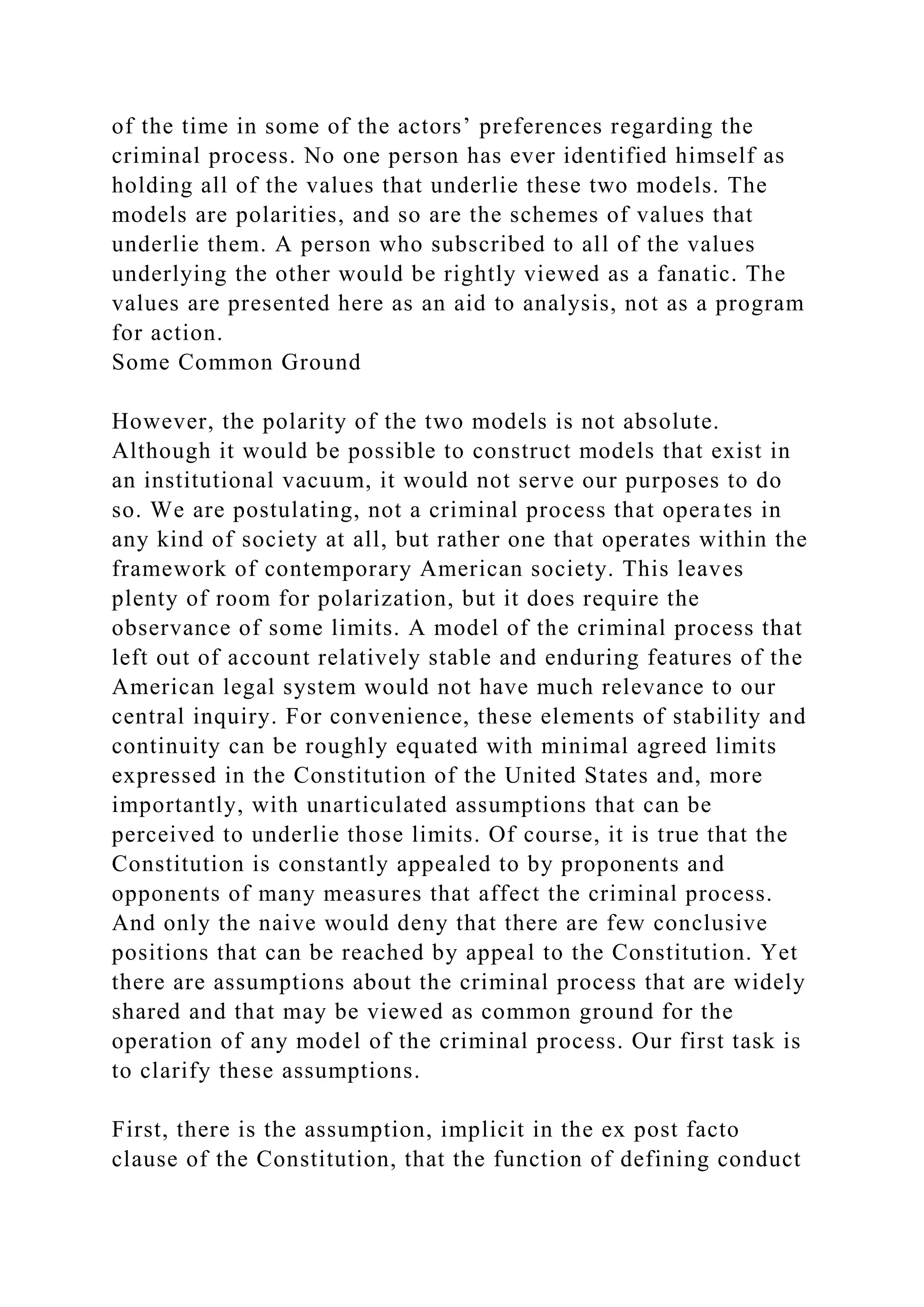
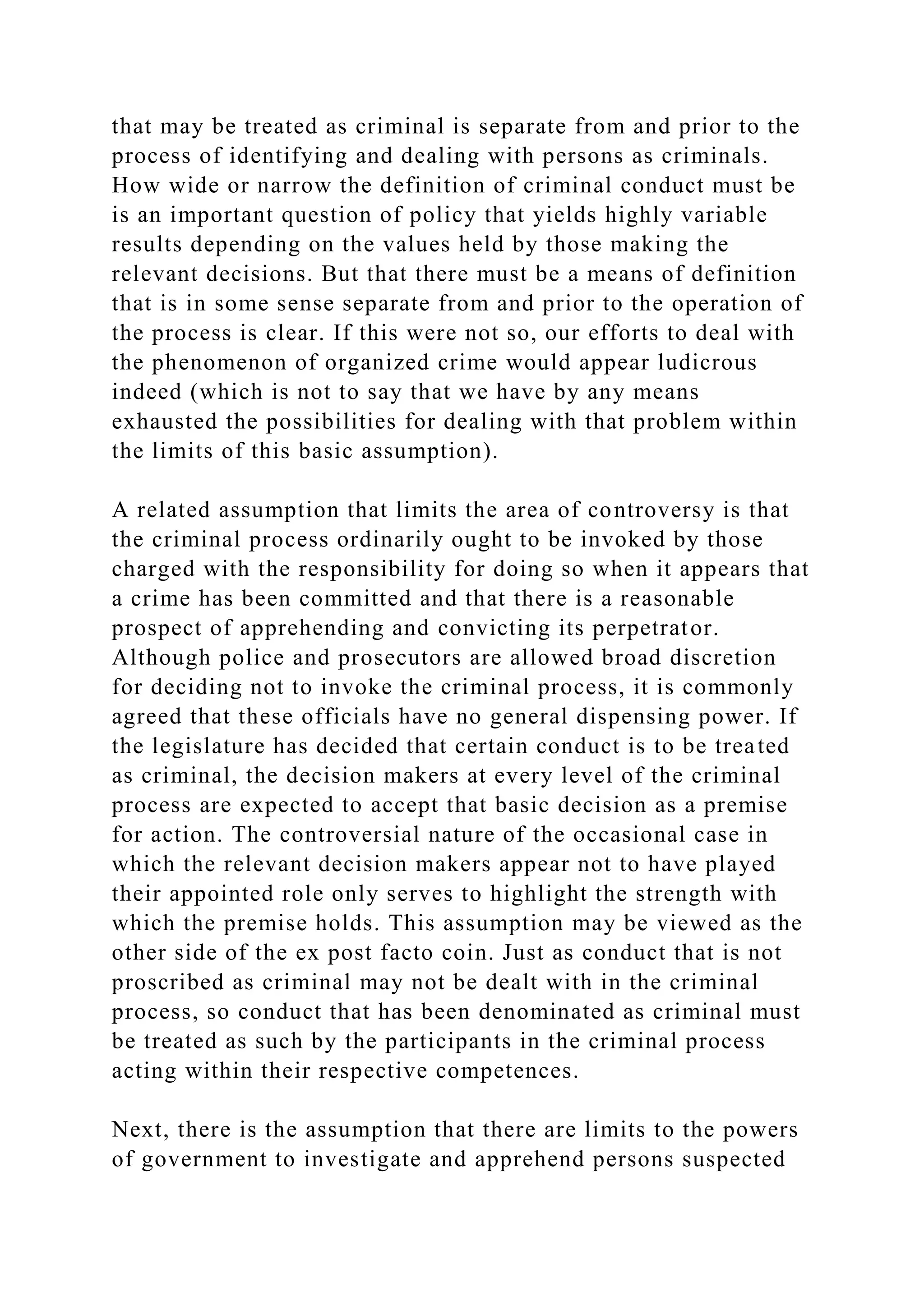
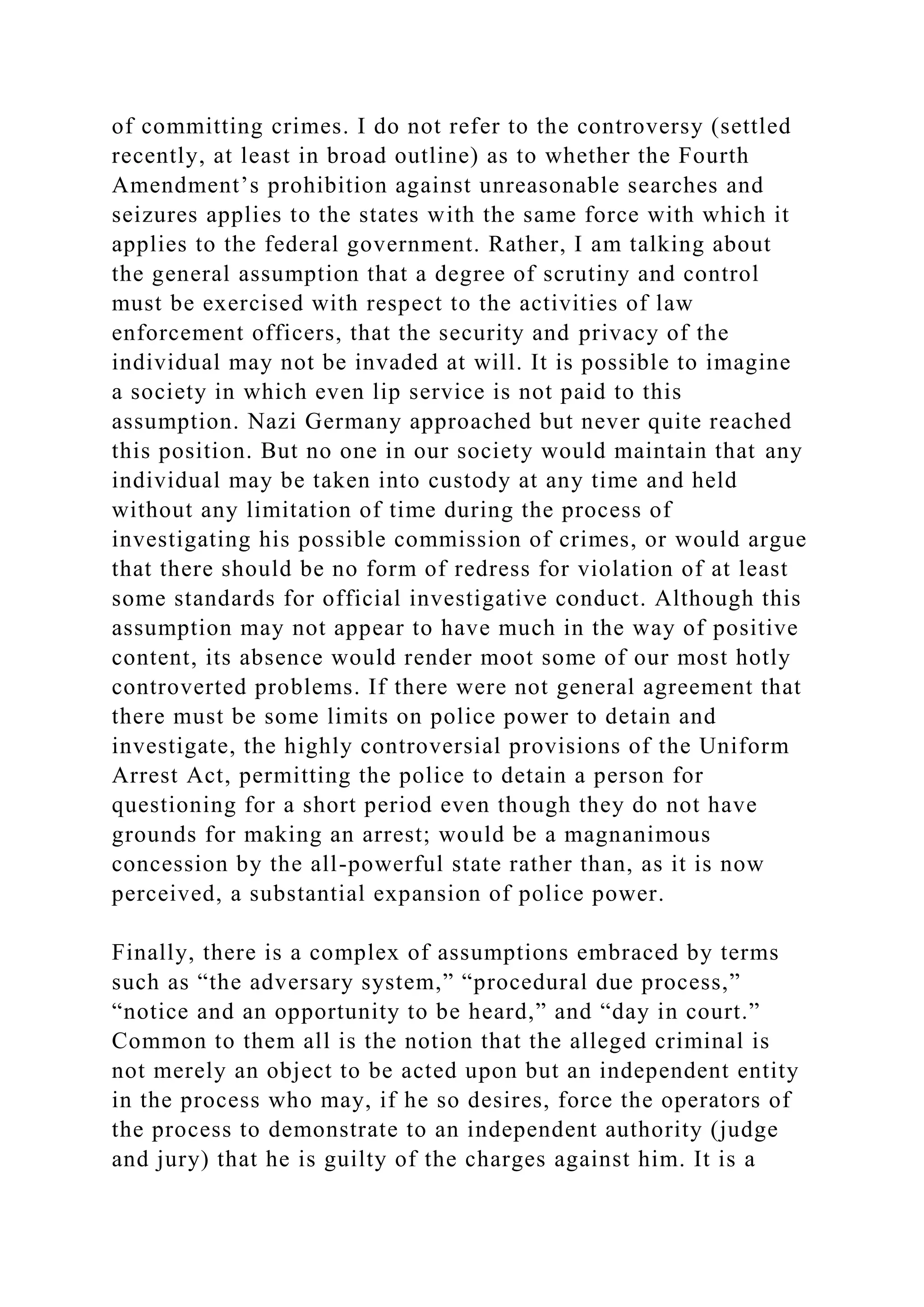
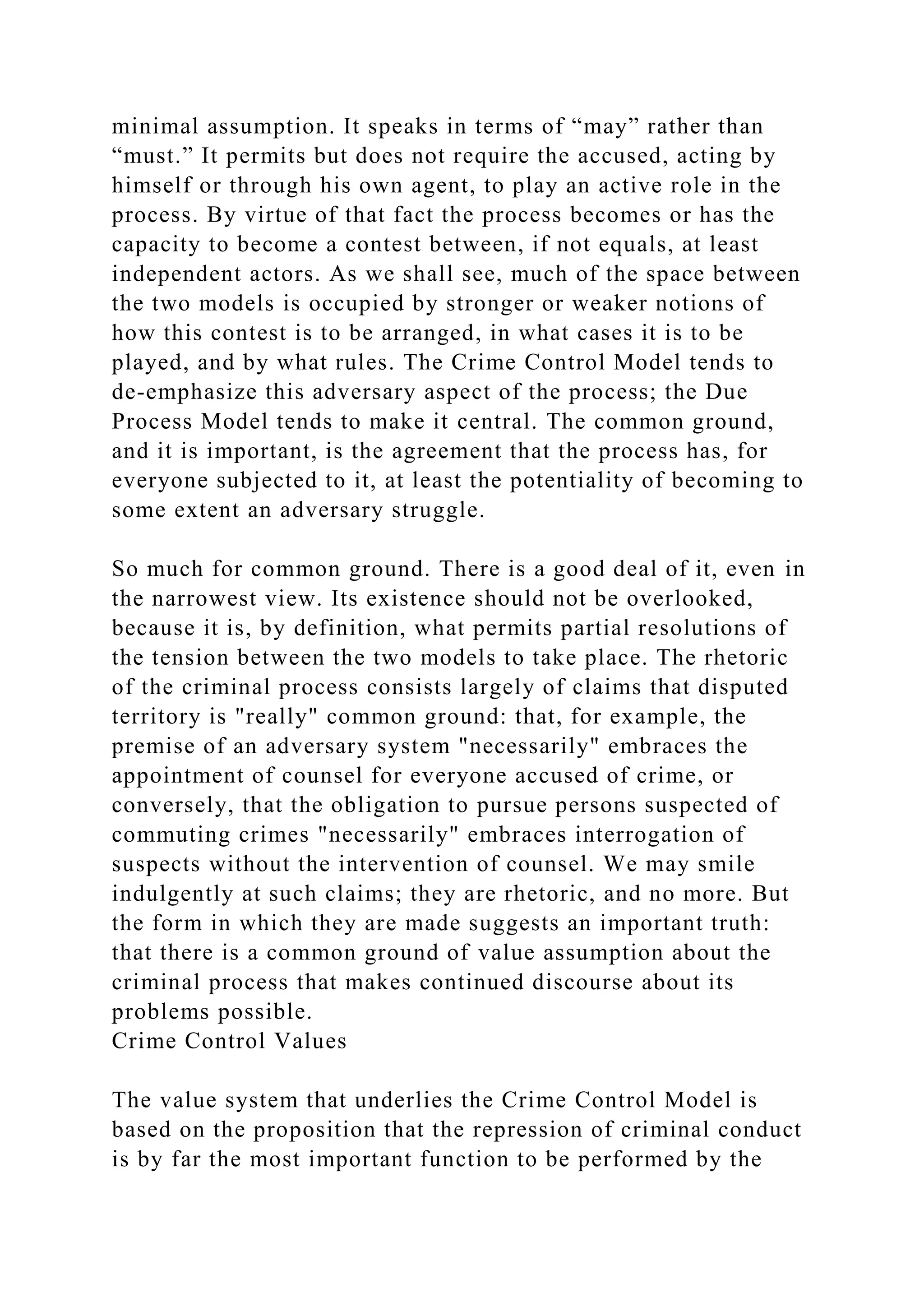
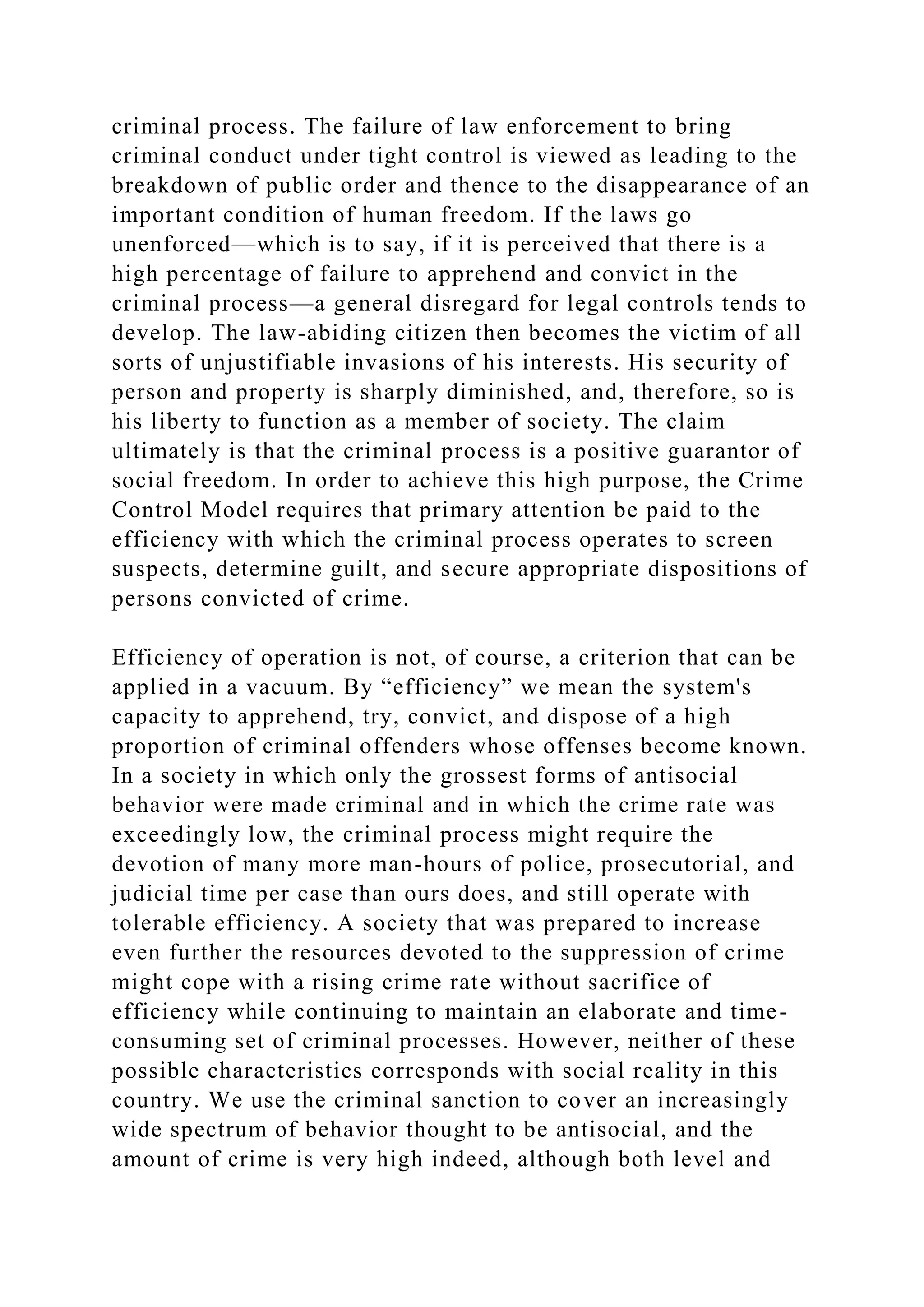
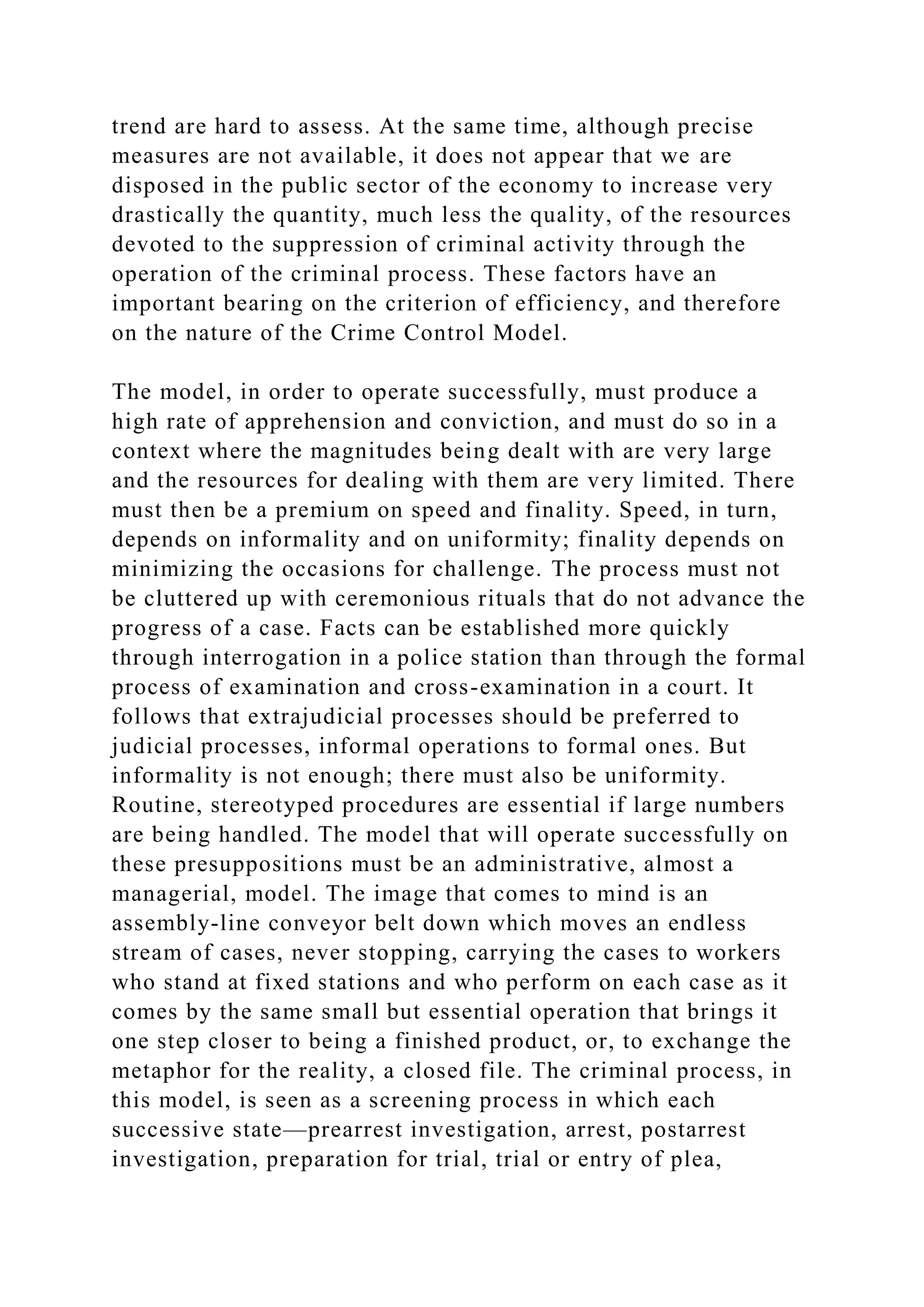

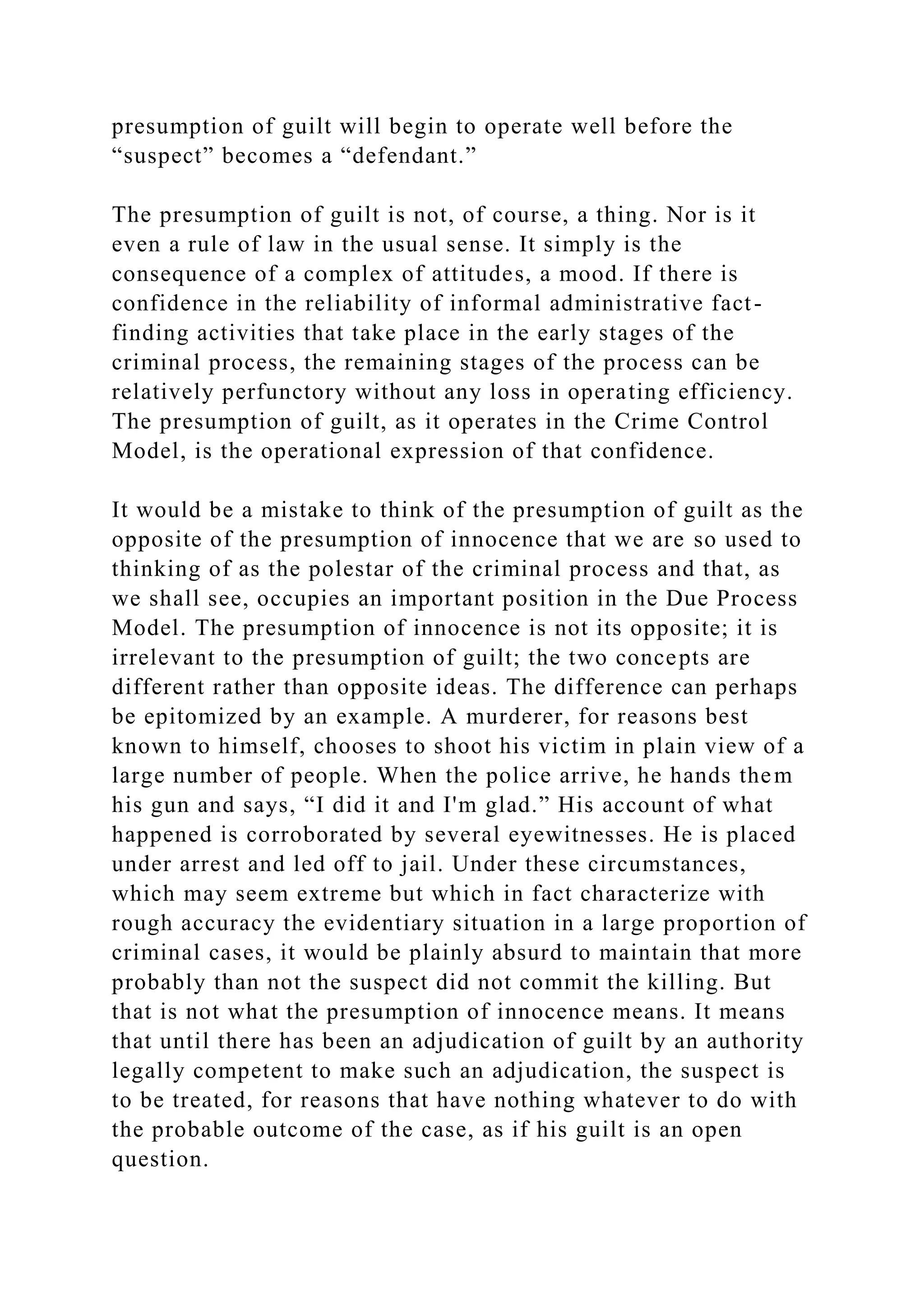
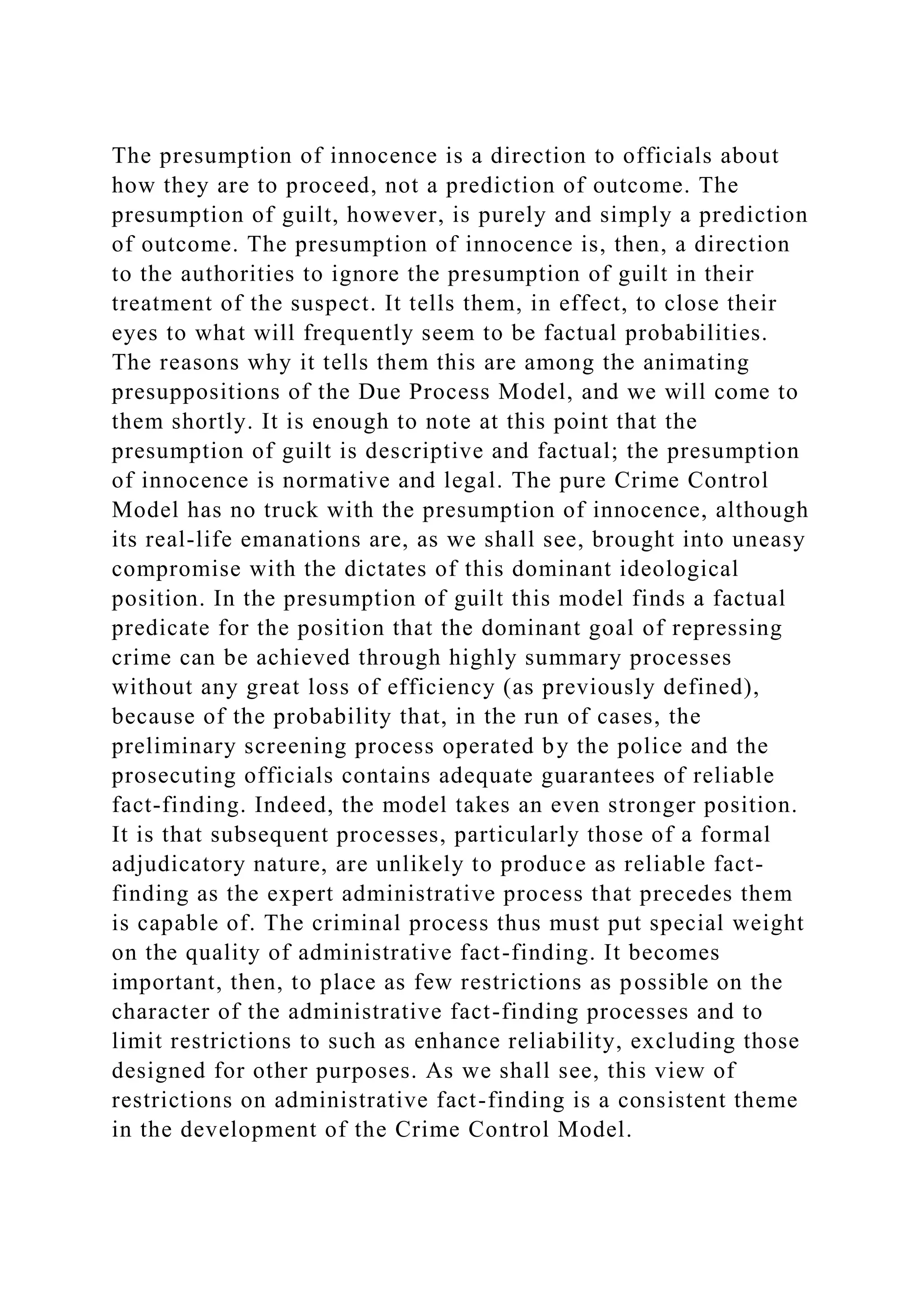
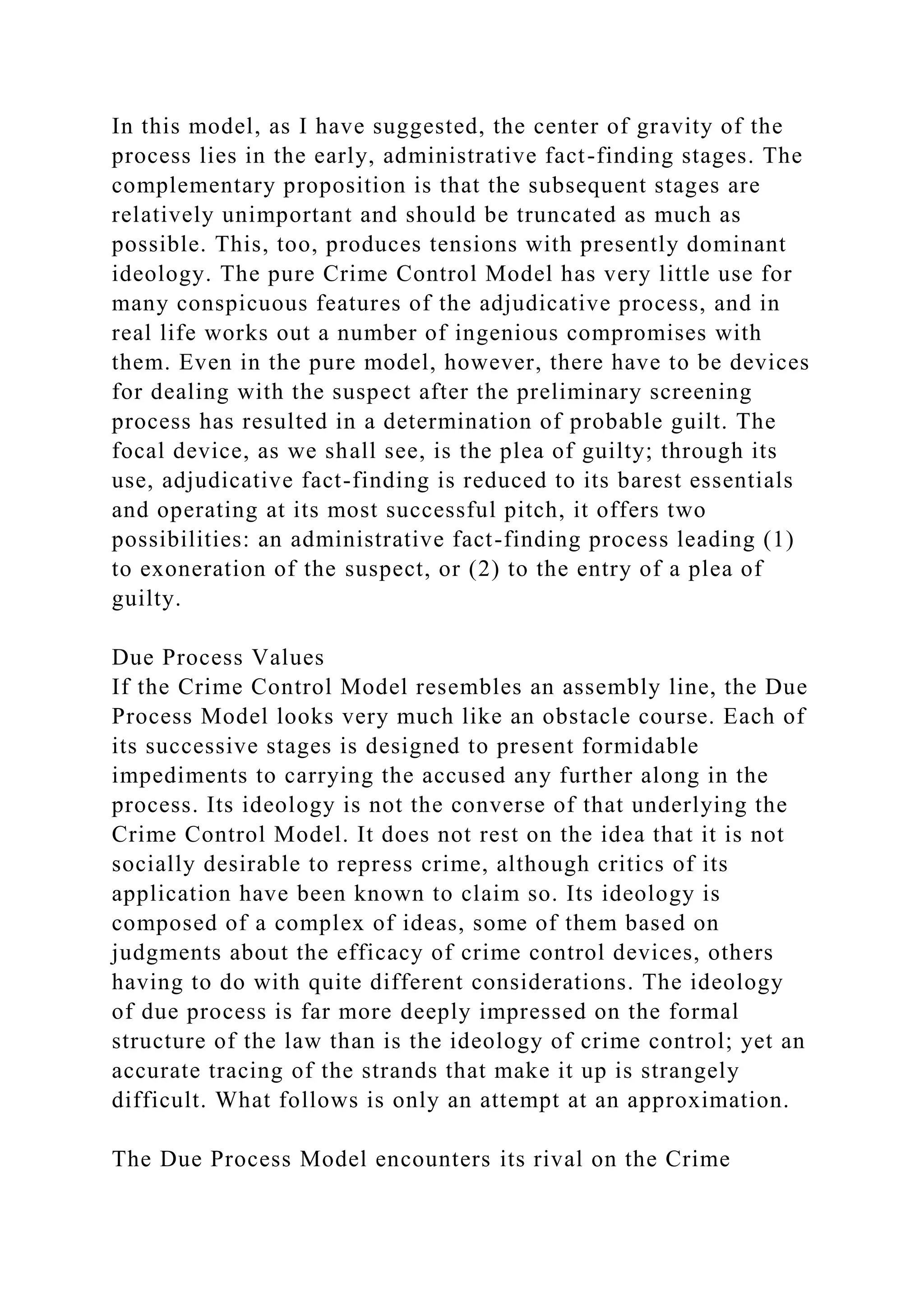
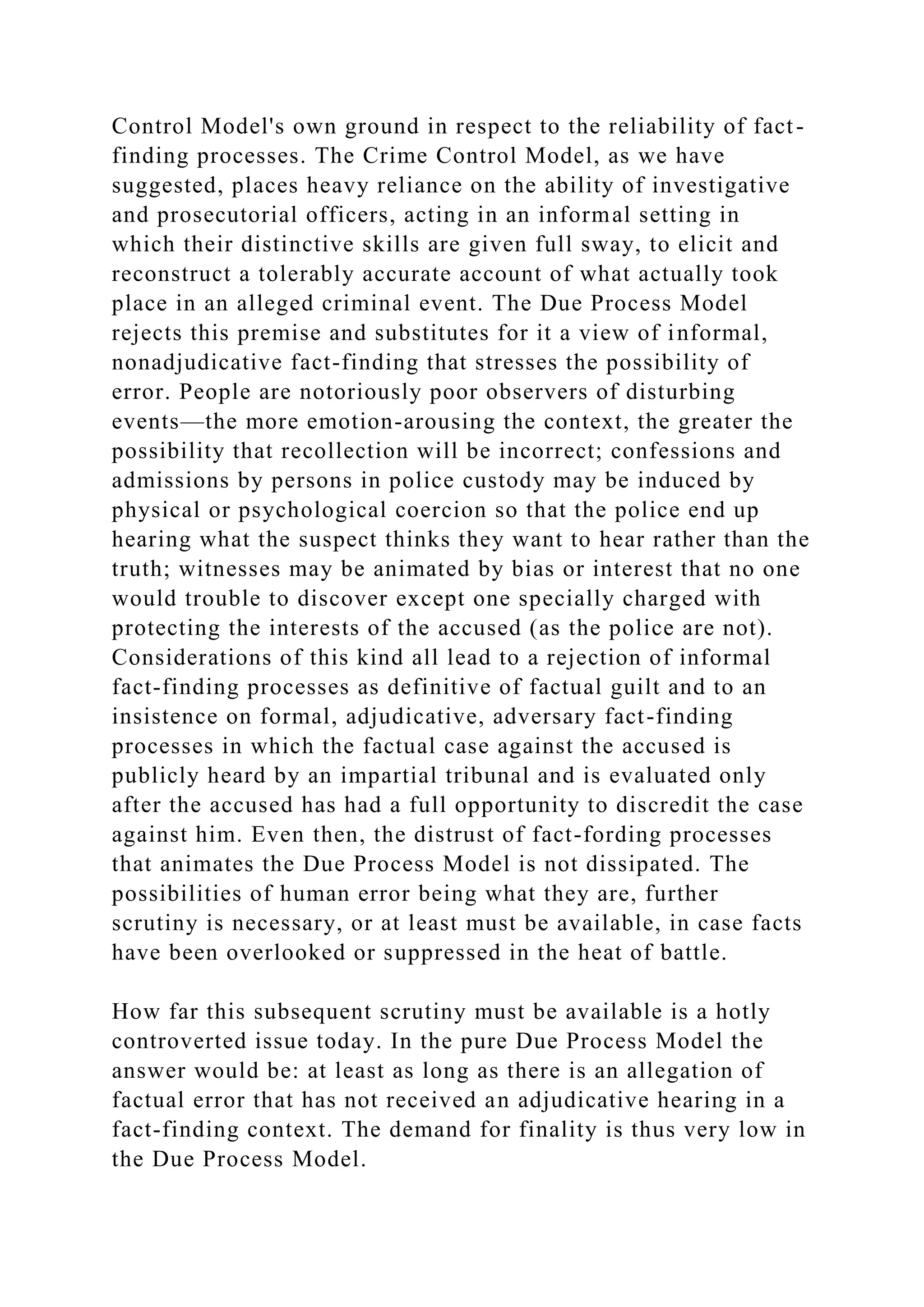
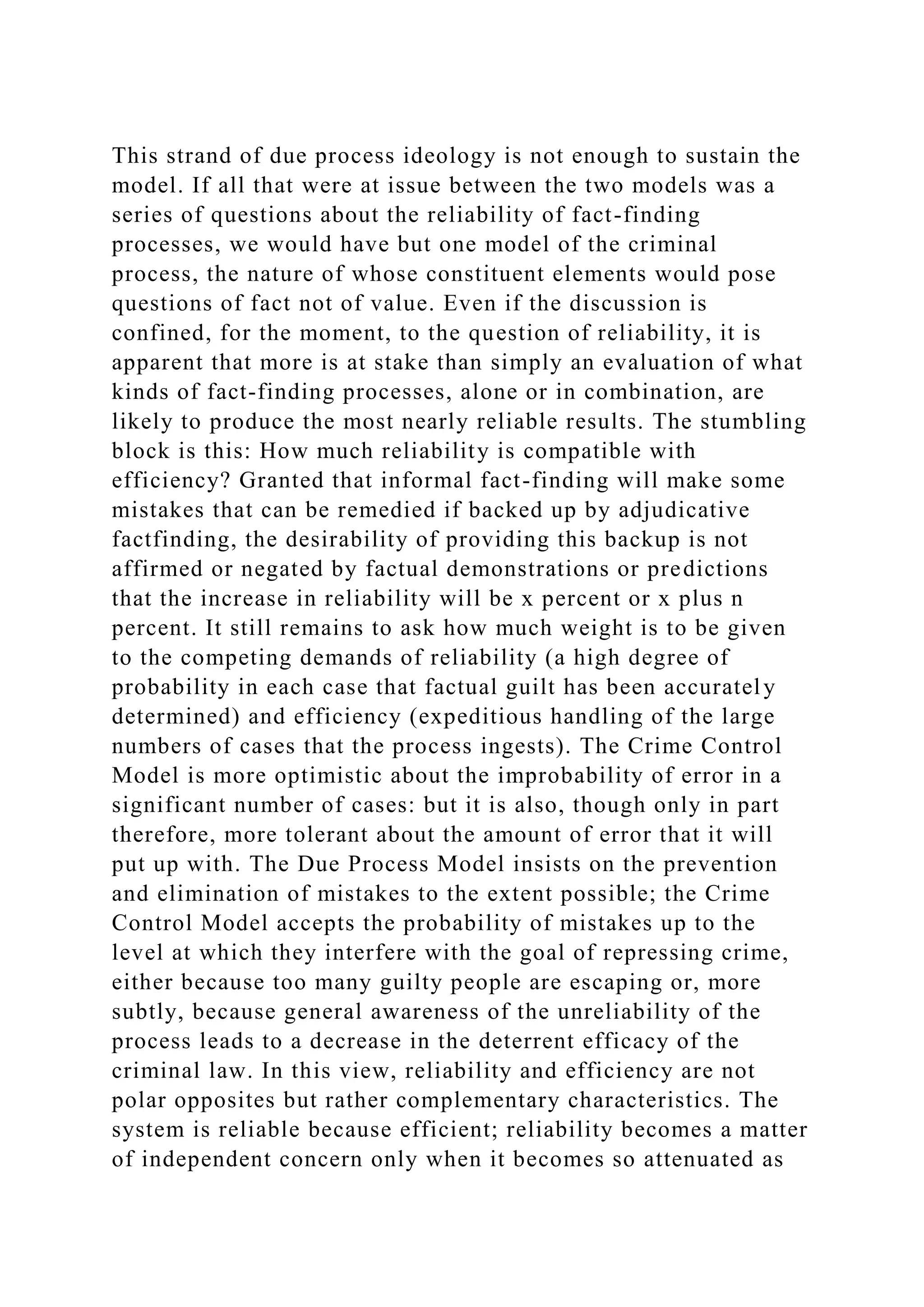
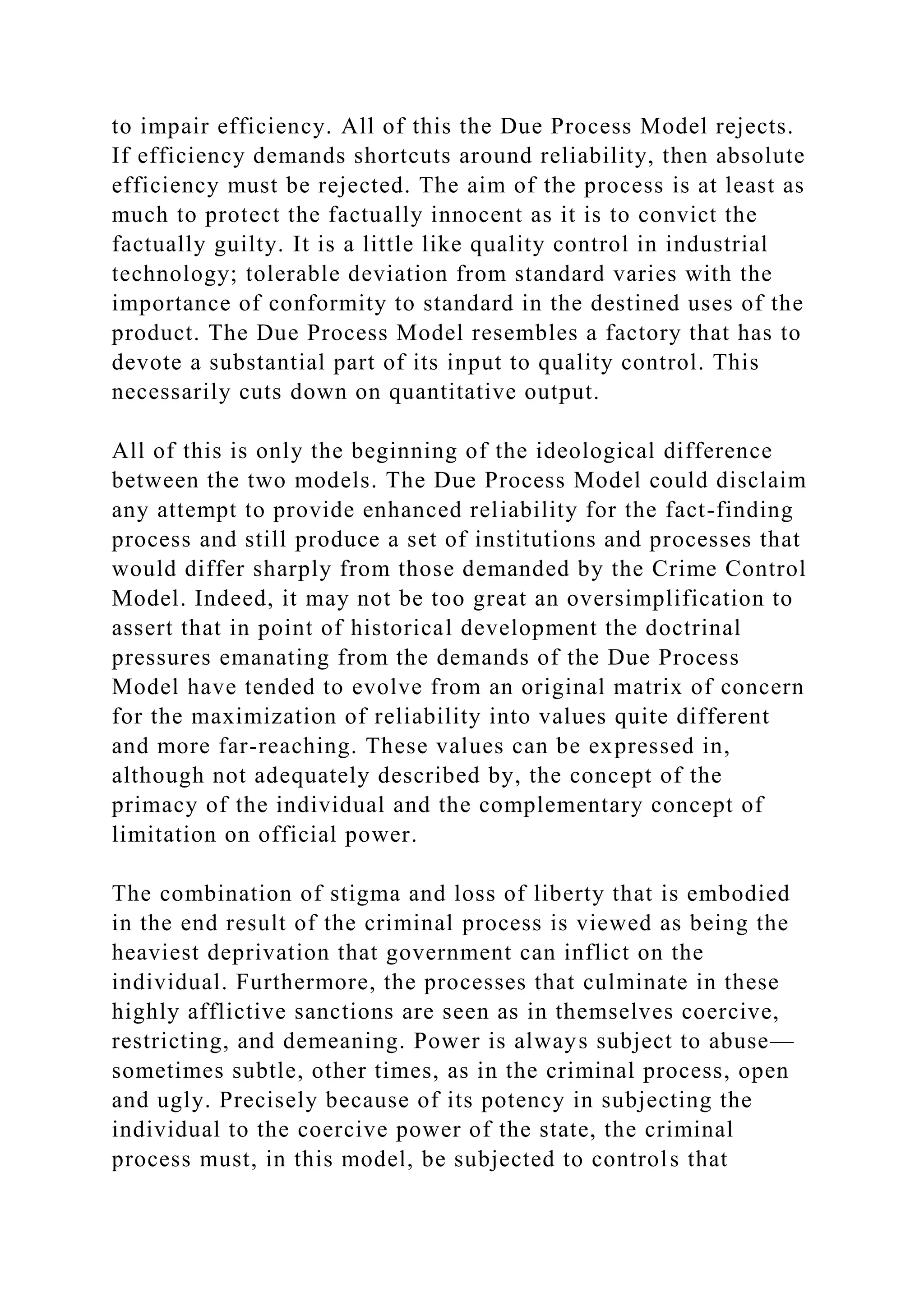
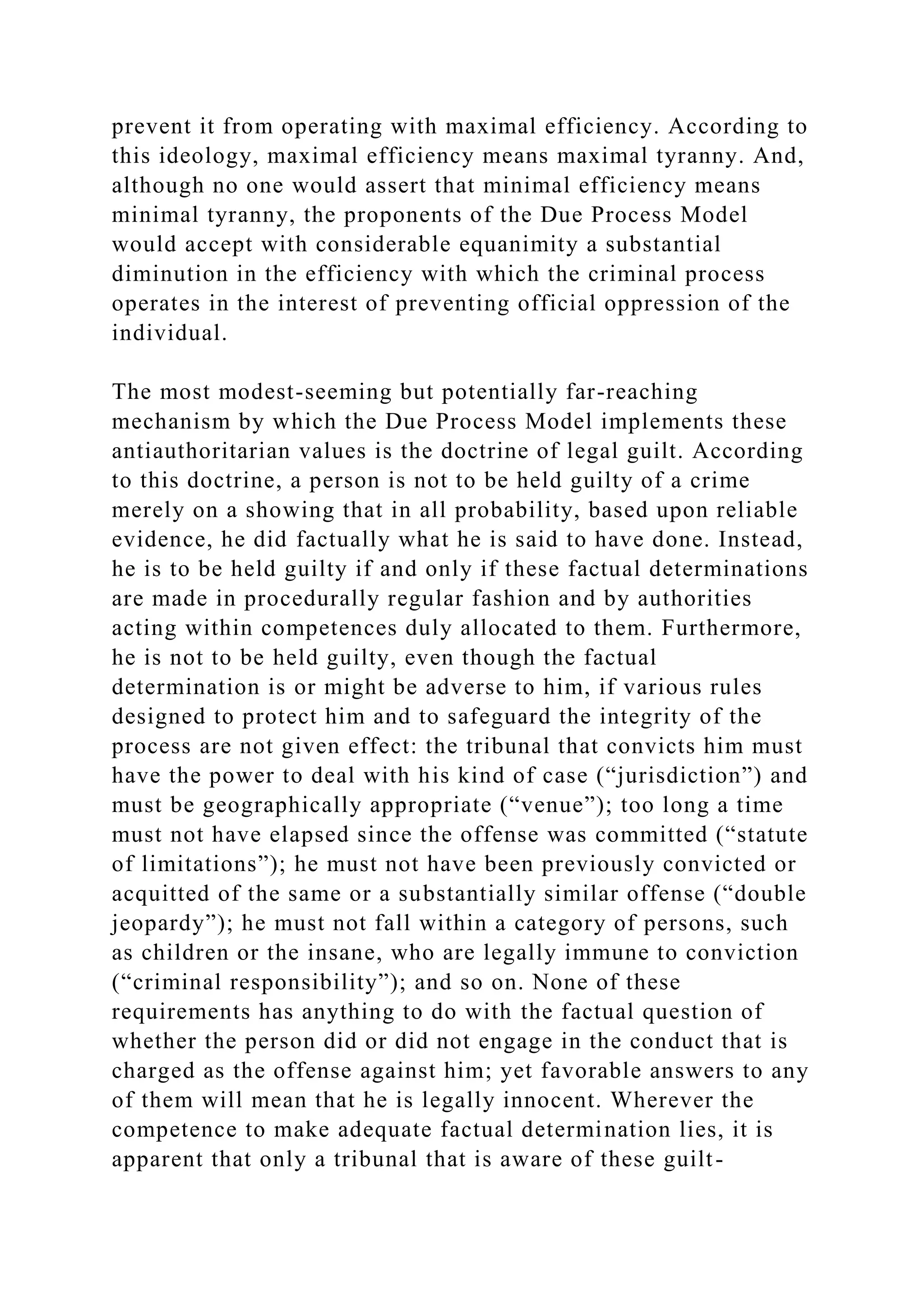
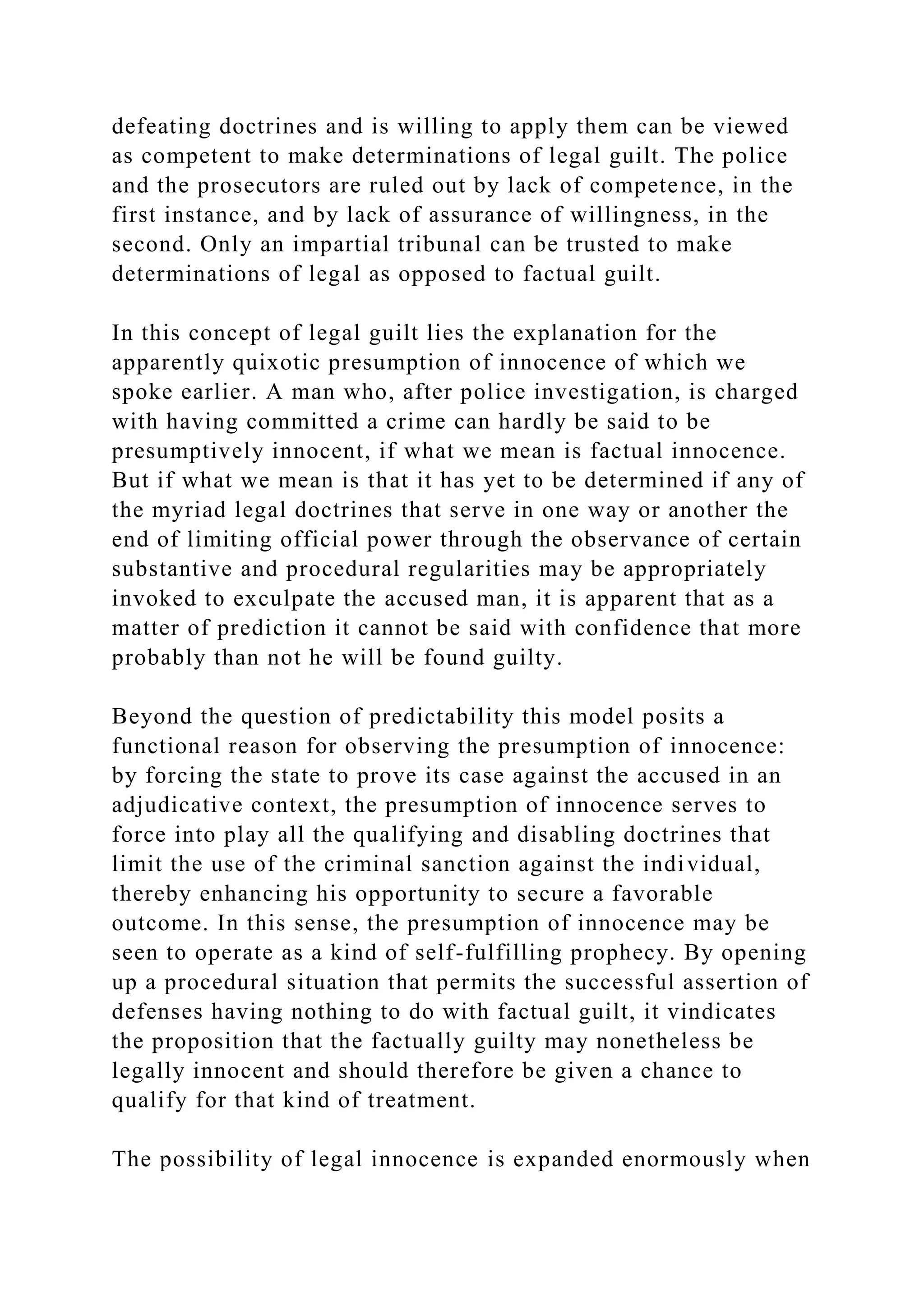
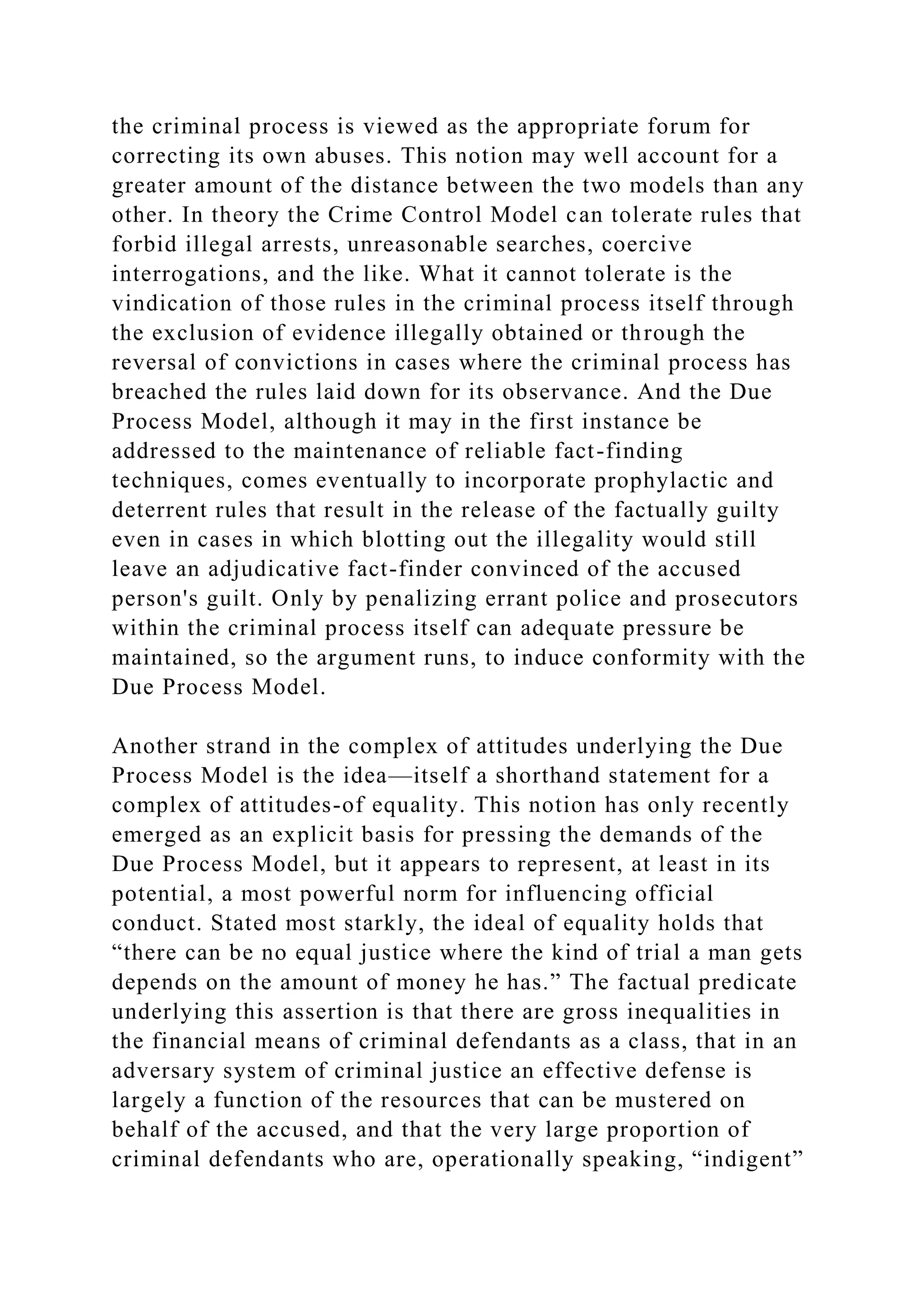
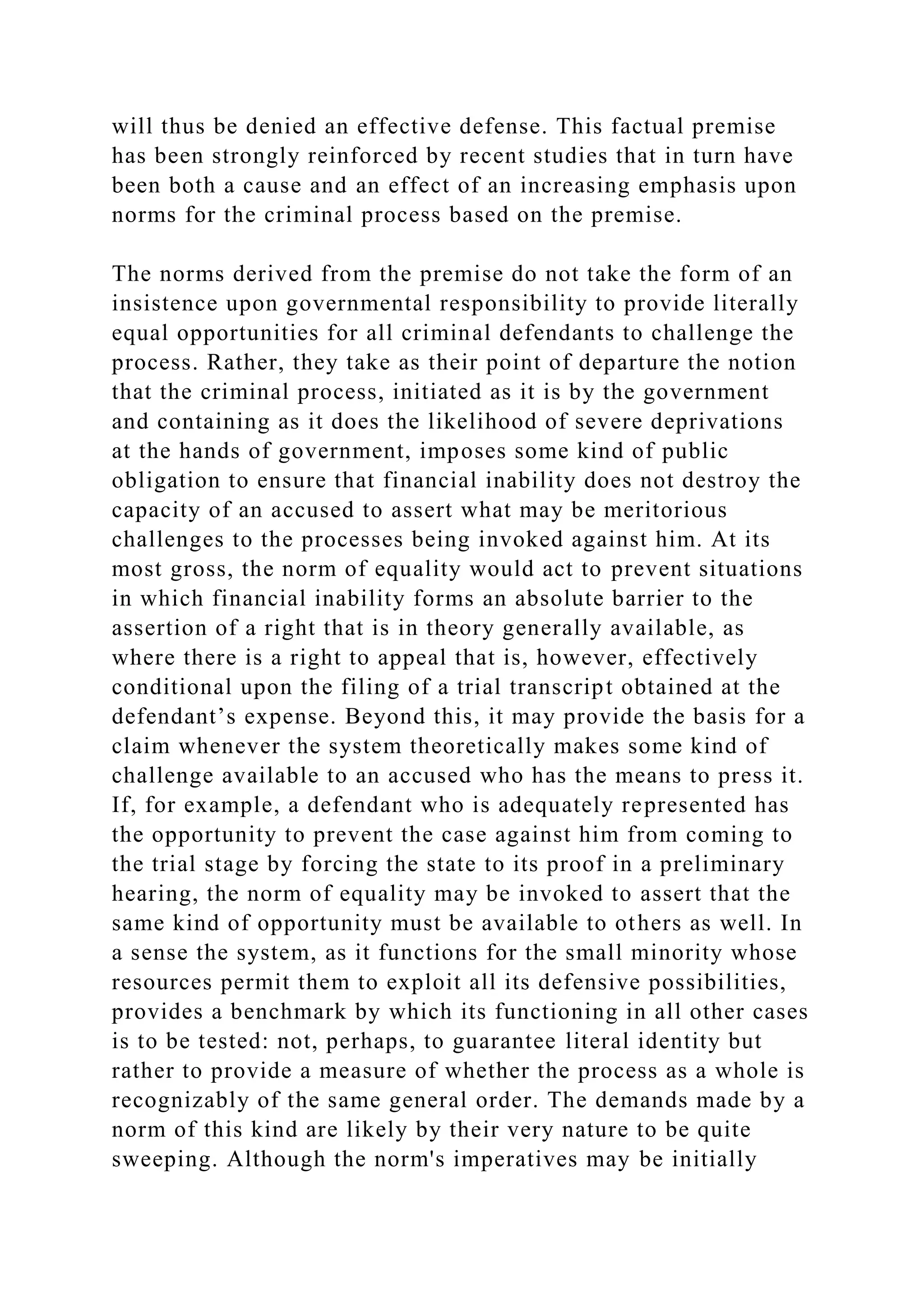
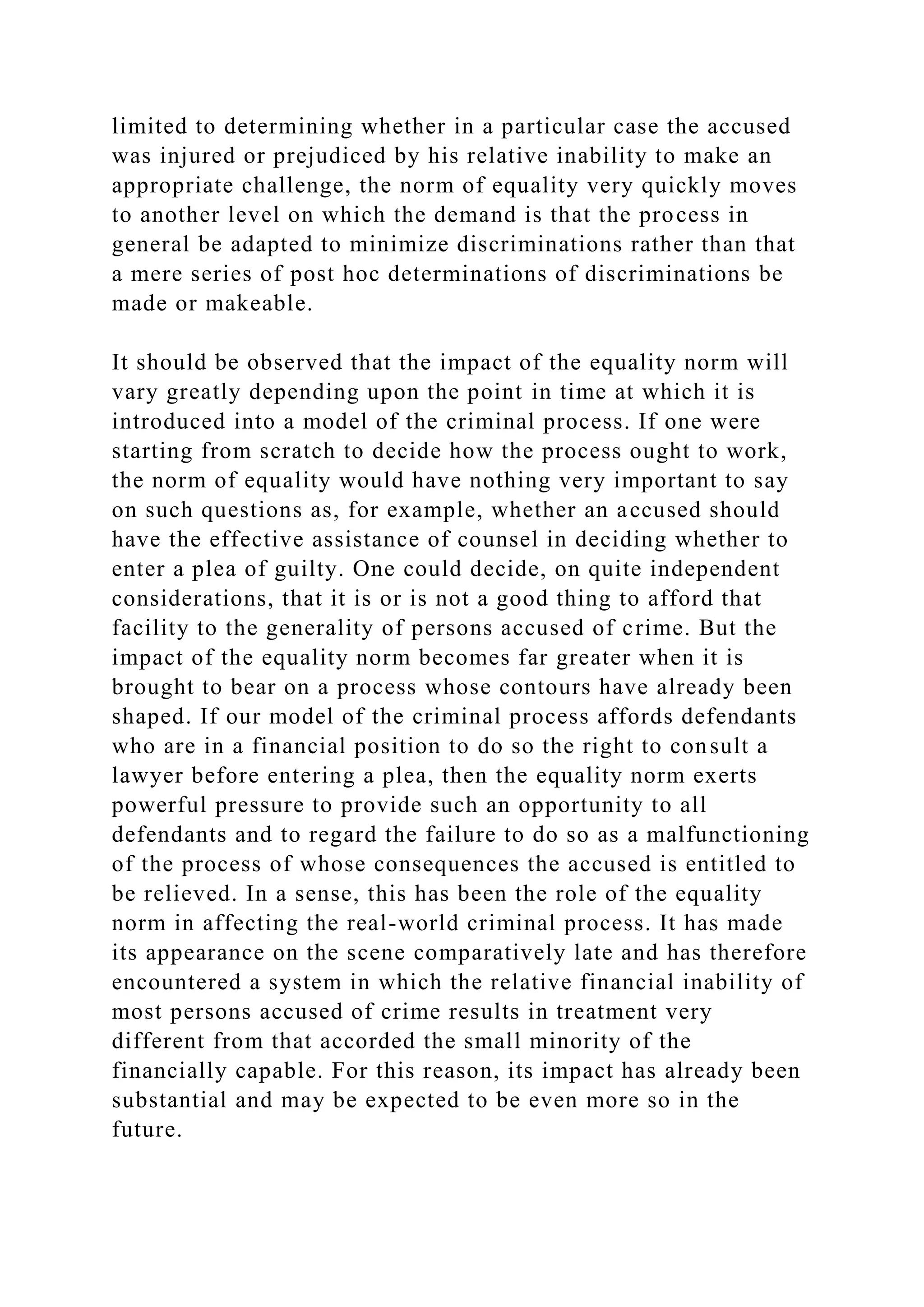
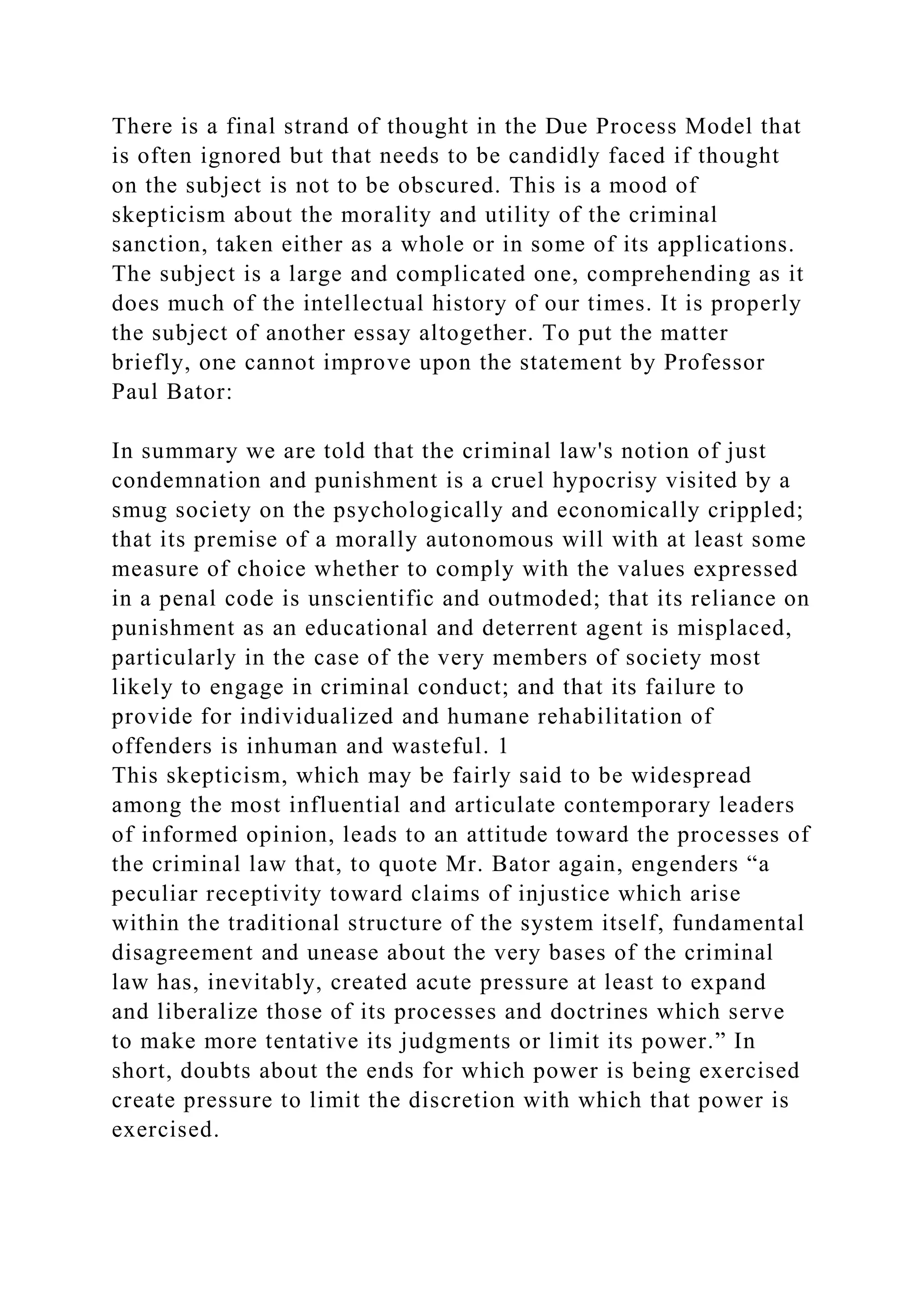
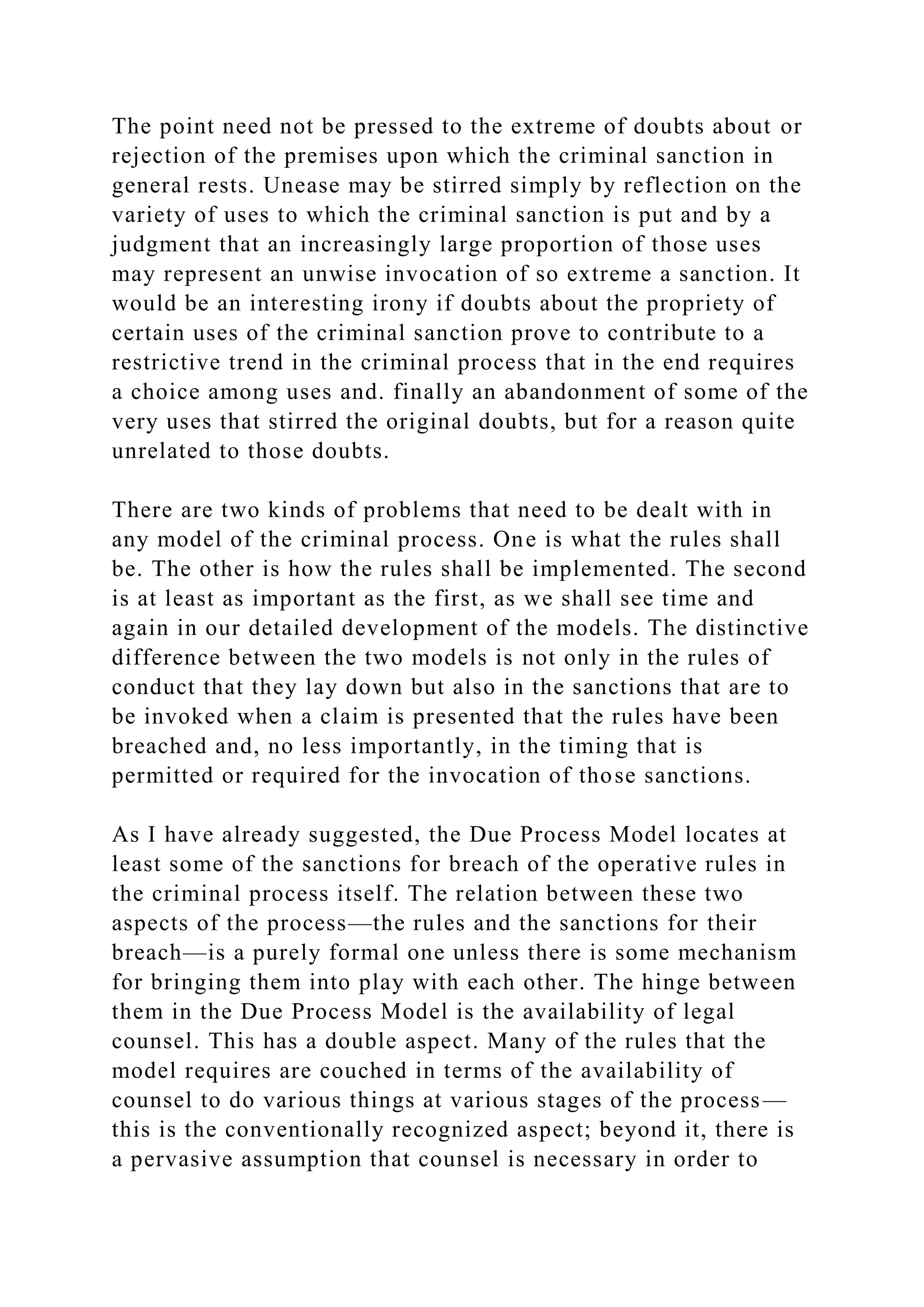
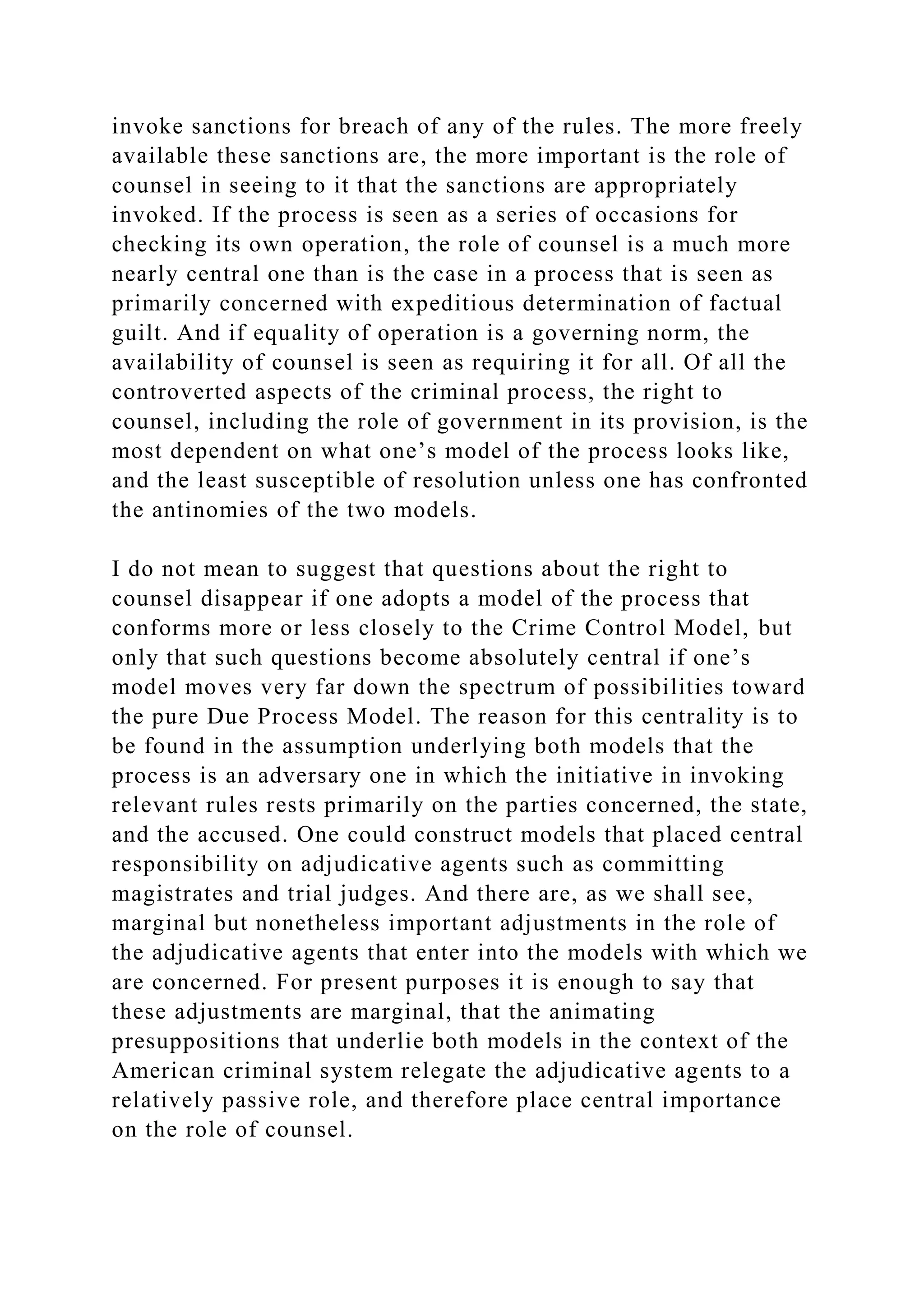
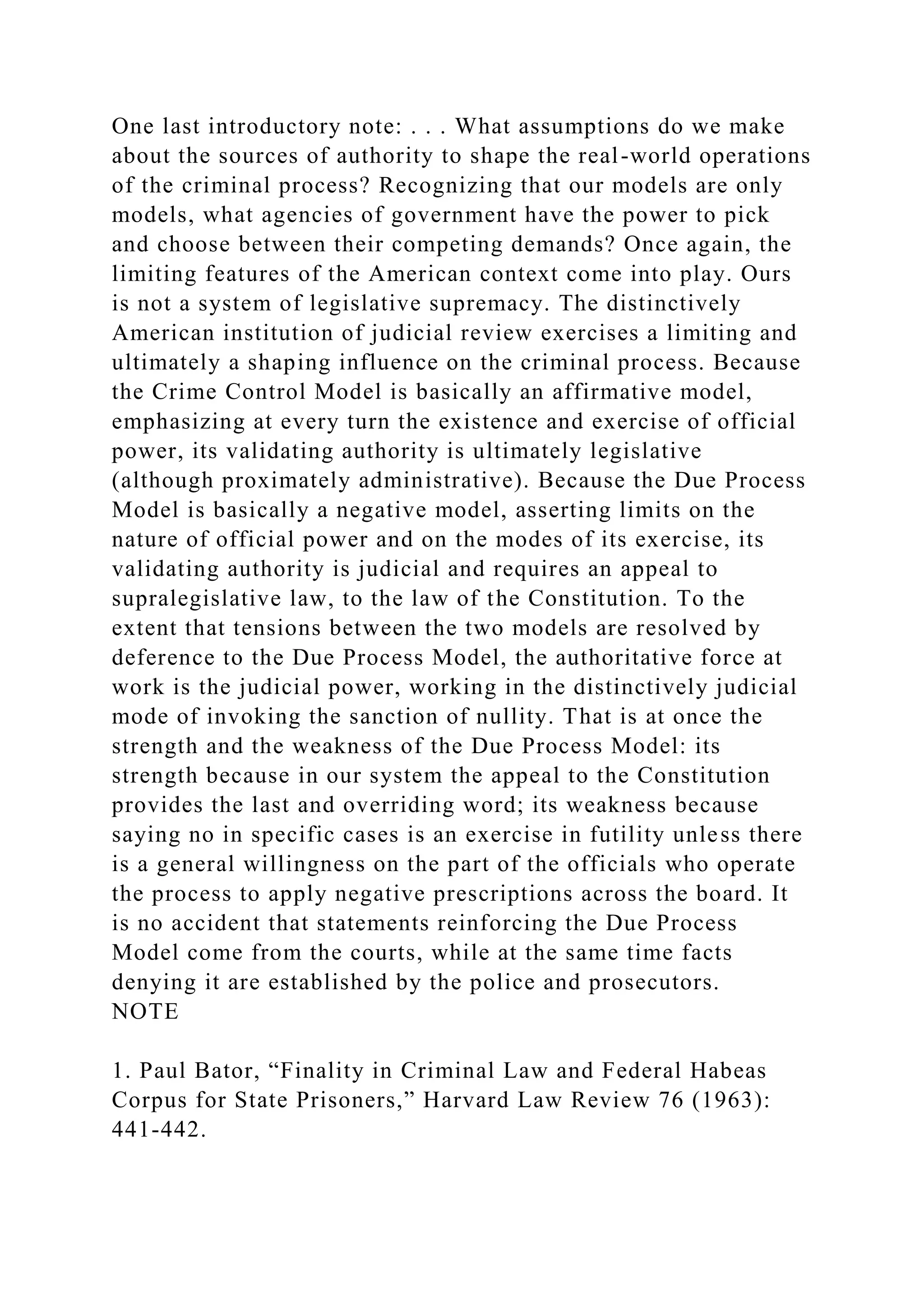
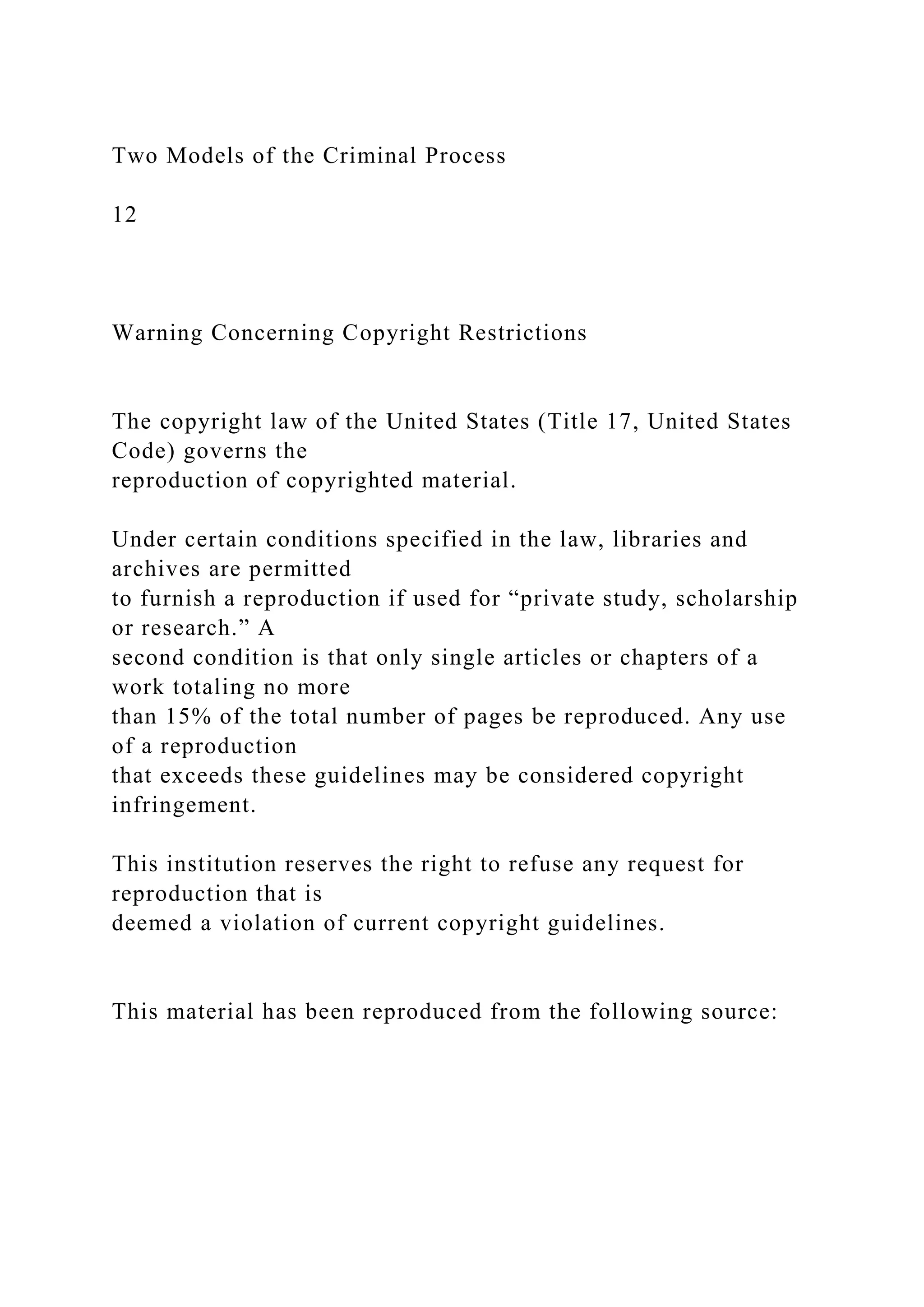
![Date prepared:
This material is presented for use solely by authorized faculty
and students of the
Pennsylvania State University. Further reproduction or
distribution of this material
is expressly prohibited.
This material may be made available in alternative media upon
request. Please
contact Course Reserves Services at [email protected] or by
phone at
(814) 863-0324.
If you are experiencing problems viewing or printing this
document, please visit
http://www.libraries.psu.edu/tas/reserve/useelectronicreserves.h
tm for
troubleshooting information. If further assistance is required,
please send a
description of the problem to [email protected] that includes the
course and instructor for which the material is on reserve, as
well as the title of
the material.
ADM135
Eskridge, Chris W. Justice and the American justice network. In
Criminal justice:
concepts and issues: an anthology. Los Angeles. Roxbury. 1999.](https://image.slidesharecdn.com/twomodelsofthecriminalprocessherbertl-221102051712-61a17231/75/Two-Models-of-the-Criminal-ProcessHERBERT-L-PACKERSource-R-docx-26-2048.jpg)
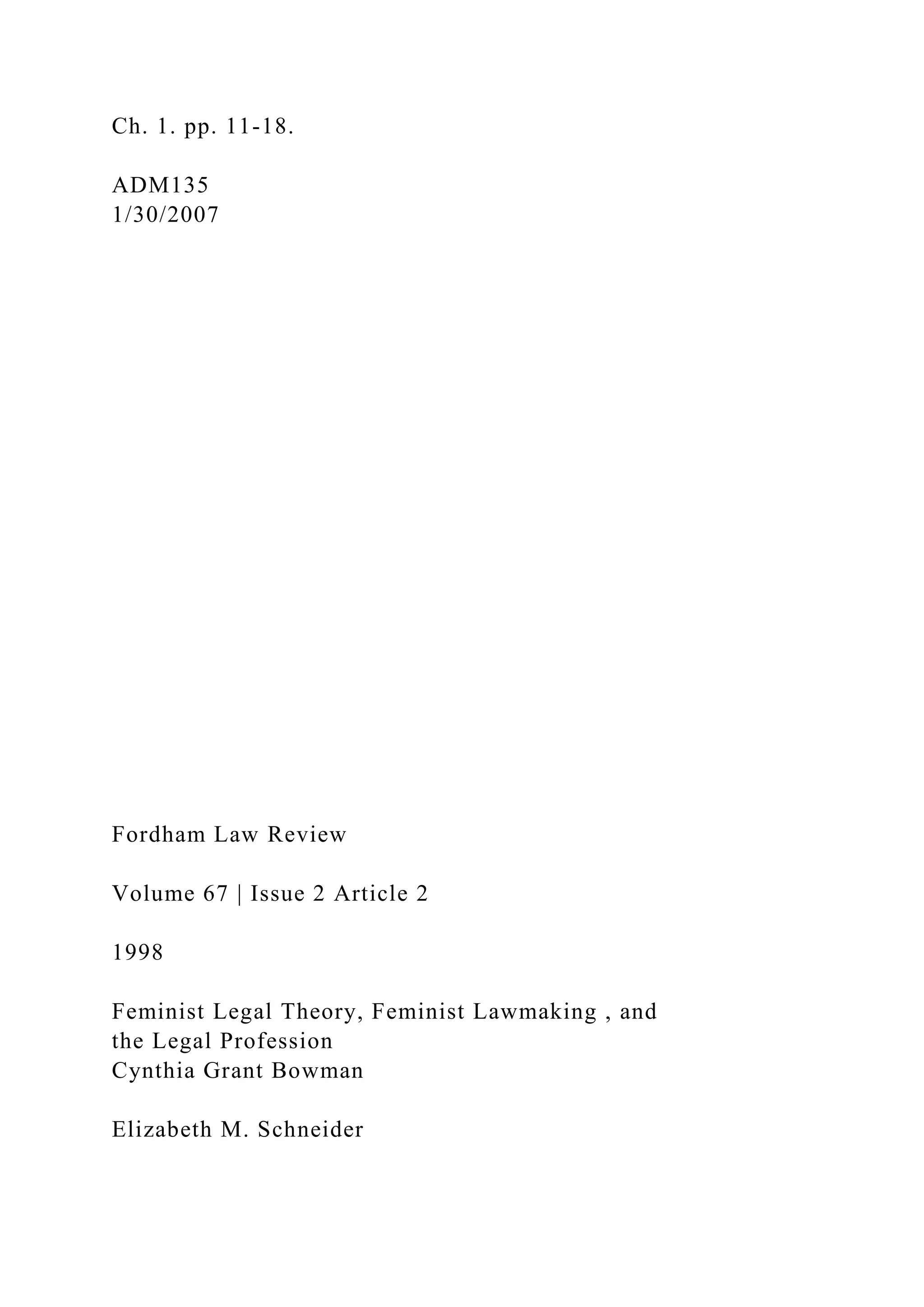
![This Article is brought to you for free and open access by
FLASH: The Fordham Law Archive of Scholarship and History.
It has been accepted for
inclusion in Fordham Law Review by an authorized
administrator of FLASH: The Fordham Law Archive of
Scholarship and History. For more
information, please contact [email protected]
Recommended Citation
Cynthia Grant Bowman and Elizabeth M. Schneider, Feminist
Legal Theory, Feminist Lawmaking , and the Legal Profession,
67 Fordham
L. Rev. 249 (1998).
Available at: http://ir.lawnet.fordham.edu/flr/vol67/iss2/2
http://ir.lawnet.fordham.edu/flr
http://ir.lawnet.fordham.edu/flr/vol67
http://ir.lawnet.fordham.edu/flr/vol67/iss2
http://ir.lawnet.fordham.edu/flr/vol67/iss2/2
mailto:[email protected]
ARTICLES
FEMINIST LEGAL THEORY, FEMINIST
LAWMAKING, AND THE LEGAL
PROFESSION
Cynthia Grant Boivman* and Elizabeth Al. Schneider*
INTRODUcTION
T HIS essay addresses the interrelationship among feminist
legal
_ theory, feminist lawmaking,' and the legal profession. We de-](https://image.slidesharecdn.com/twomodelsofthecriminalprocessherbertl-221102051712-61a17231/75/Two-Models-of-the-Criminal-ProcessHERBERT-L-PACKERSource-R-docx-28-2048.jpg)
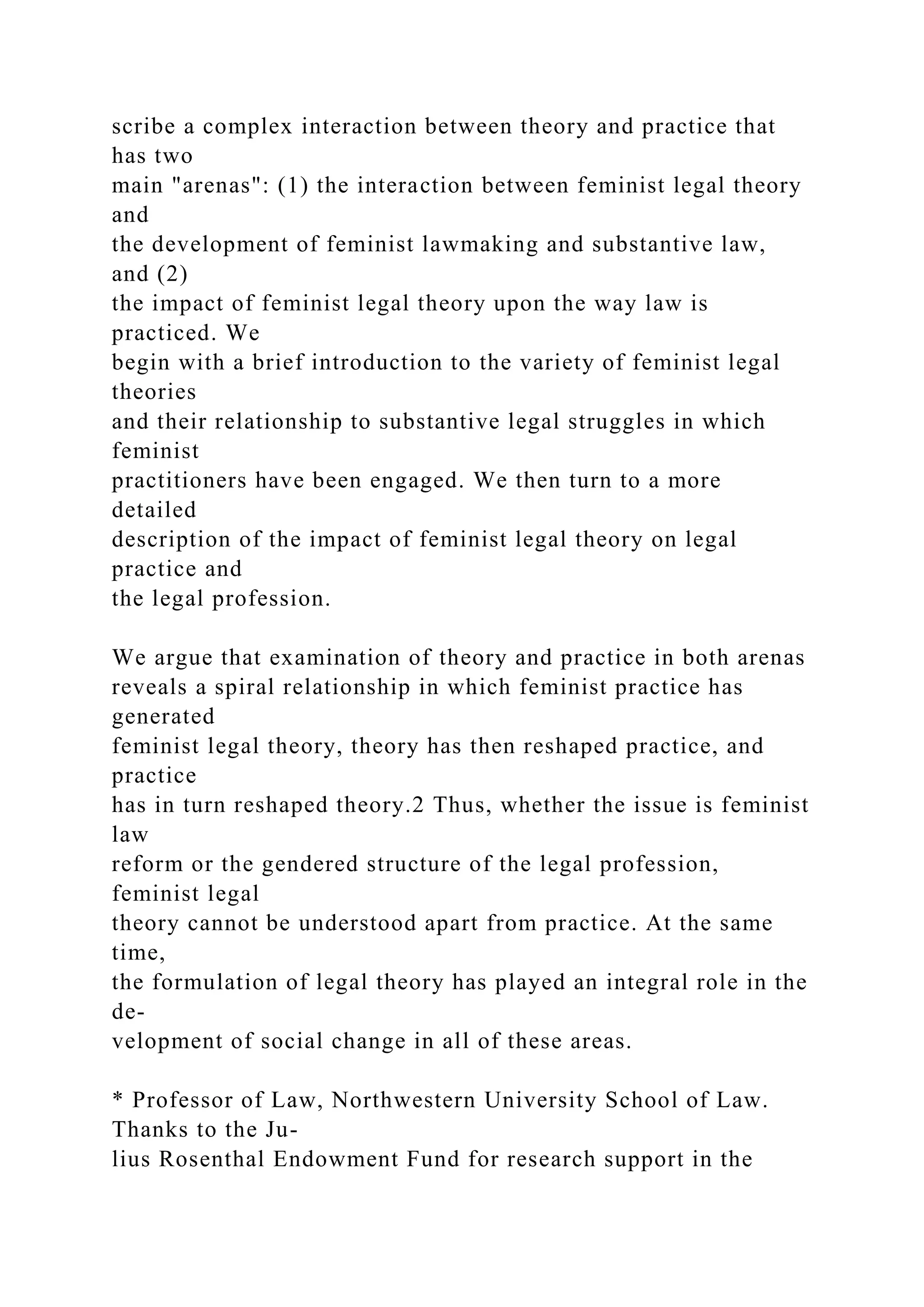
![summer of 1998 and to
Daniel Goldwin for his assistance with research for this essay.
** Professor of Law, Brooklyn Law School. Thanks to the
Brooklyn Law School
Faculty Research Program and to Joan Erskine and Alexandra
Derian for research
assistance.
1. "Feminist lawmaking" is the process by which "[w]omen have
shaped the law
by imagining the law differently[,]... developed theory from
practice, turned that new
theory into practice, and then brought it back to theory."
Elizabeth M. Schneider,
Feminist Lawmaking and Historical Consciousness: Bringing
the Past into tile Future,
2 Va. J. Soc. Pol'y & L. 1, 7 (1994) [hereinafter Schneider,
Feminist Lawmaking] (foot-
note omitted); see also Elizabeth M. Schneider, The Dialectic of
Rights and Politics:
Perspectives from the Women's Movement, 61 N.Y.U. L. Rev.
589, 604-10 (1986) [here-
inafter Schneider, Dialectic] (detailing the dialectical approach
to rights).
2. This relationship has been viewed as dialectical in the
lawmaking context. See
Schneider, Dialectic, supra note 1, at 604-05. Others have used
the phrase -theory-
practice spiral." See Phyllis Goldfarb, A Theory-Practice Spiral.
The Ethics of Femi-
nism and Clinical Education, 75 Minn. L. Rev. 1599, 1617
(1991).](https://image.slidesharecdn.com/twomodelsofthecriminalprocessherbertl-221102051712-61a17231/75/Two-Models-of-the-Criminal-ProcessHERBERT-L-PACKERSource-R-docx-30-2048.jpg)
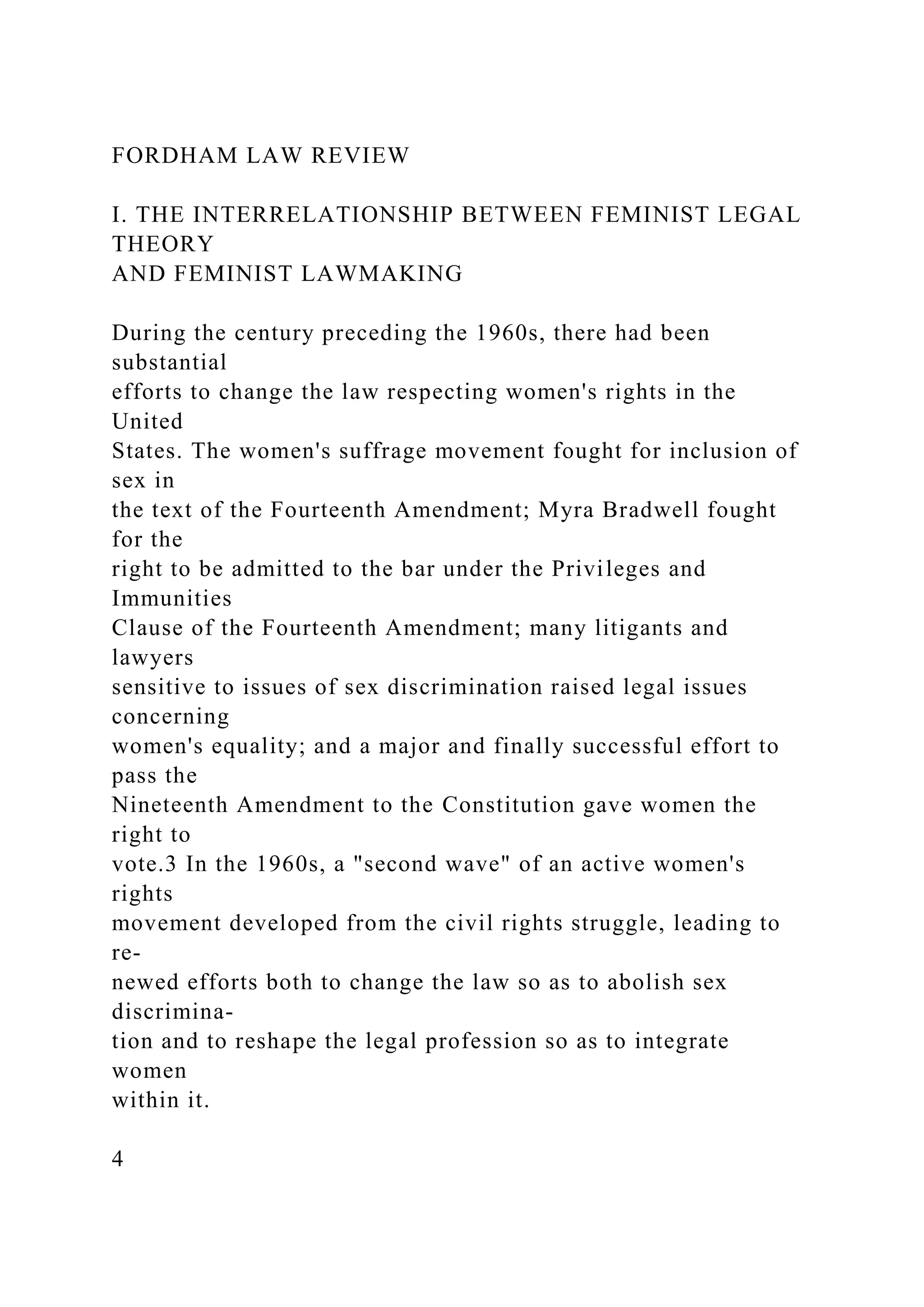
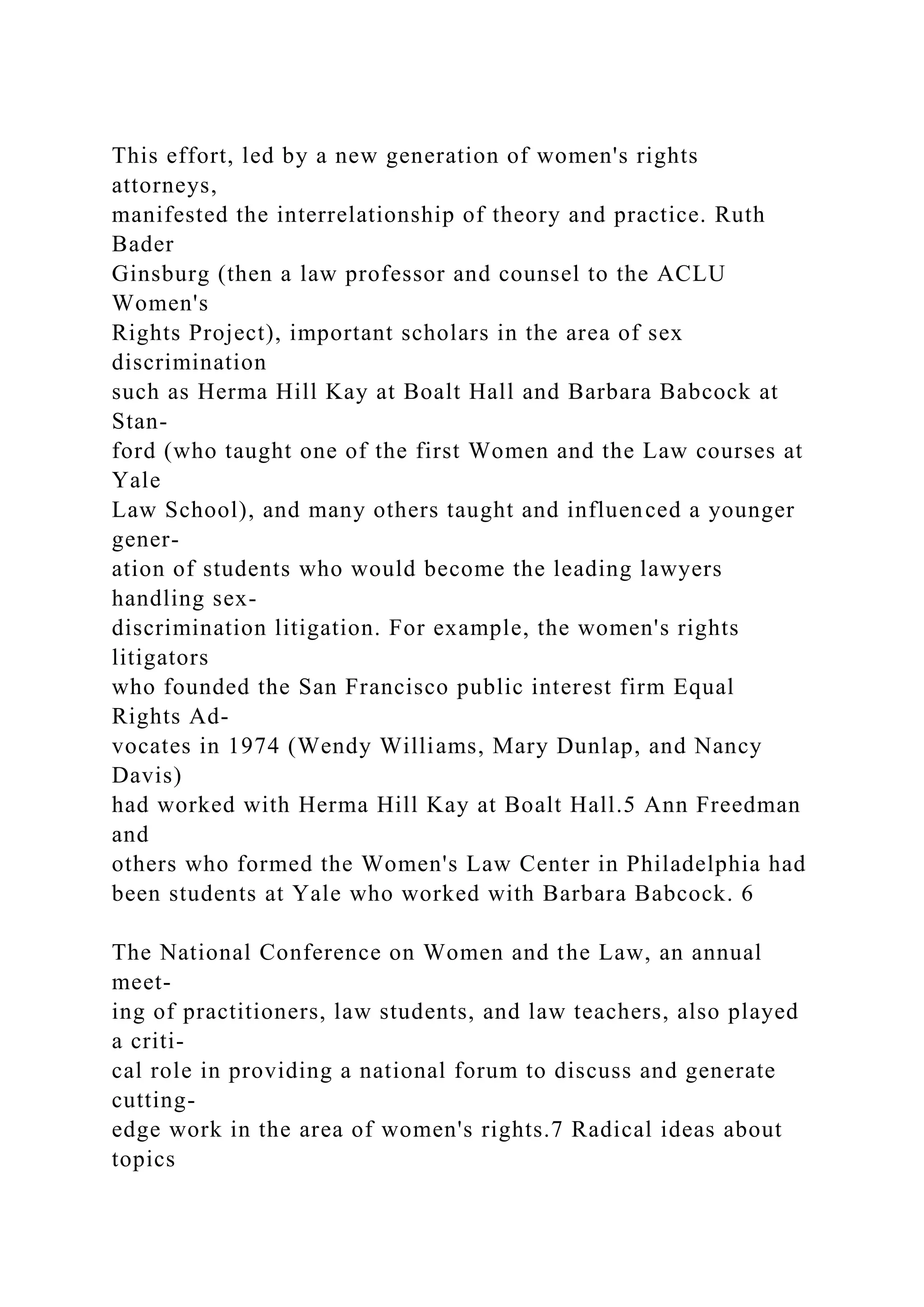
![3. For a brief description of these developments and citations to
further reading,
see Mary Becker et al., Feminist Jurisprudence: Taking Women
Seriously 1-14 (1994).
4. See id. at 17-30 (citing sources).
5. See Cynthia Fuchs Epstein, Women in Law 137-39 (2d ed.
1993) (describing
the founding of Equal Rights Advocates). For a recent
discussion of the evolution of
the work of Equal Rights Advocates, see Judy Scales-Trent,
Equal Rights Advocates:
Addressing the Legal Issues of Women of Color, 13 Berkeley
Women's L.J. 34, 39-66
(1997).
6. See Barbara Allen Babcock et al., Sex Discrimination and the
Law: Causes
and Remedies at v (1975).
7. See id.; Patricia A. Cain, The Future of Feminist Legal
Theory, 11 Wis. Wo-
men's L.J. 367, 371-81 (1997) (describing the importance of the
conference to the
development of feminist legal theory and her experience as a
participant, panelist,
and organizer); Schneider, Feminist Lawmaking, supra note 1,
at 1-6.
[Vol. 67
1998] FEMINIST LEGAL THEORY & LAWMAKING 251](https://image.slidesharecdn.com/twomodelsofthecriminalprocessherbertl-221102051712-61a17231/75/Two-Models-of-the-Criminal-ProcessHERBERT-L-PACKERSource-R-docx-33-2048.jpg)
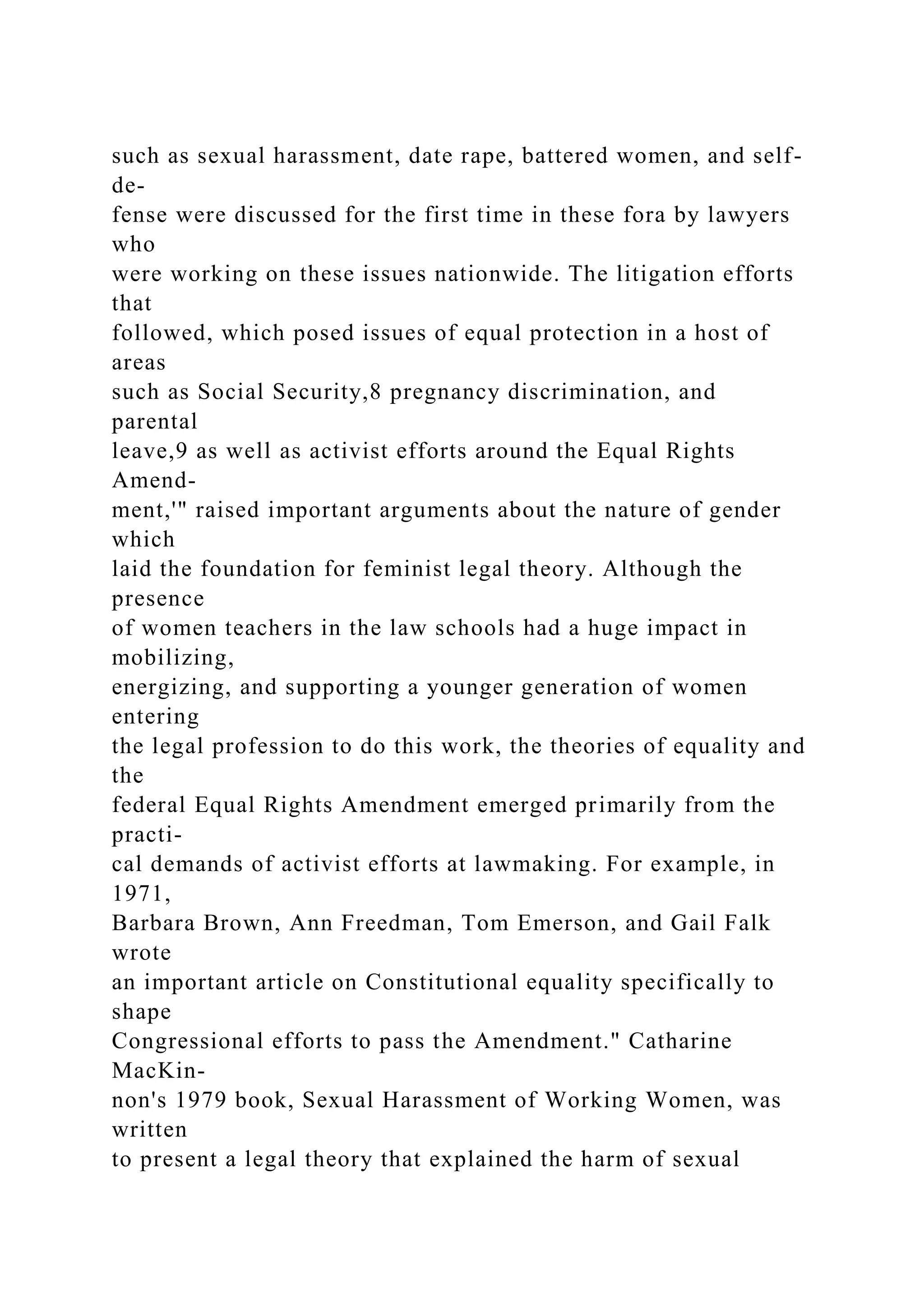
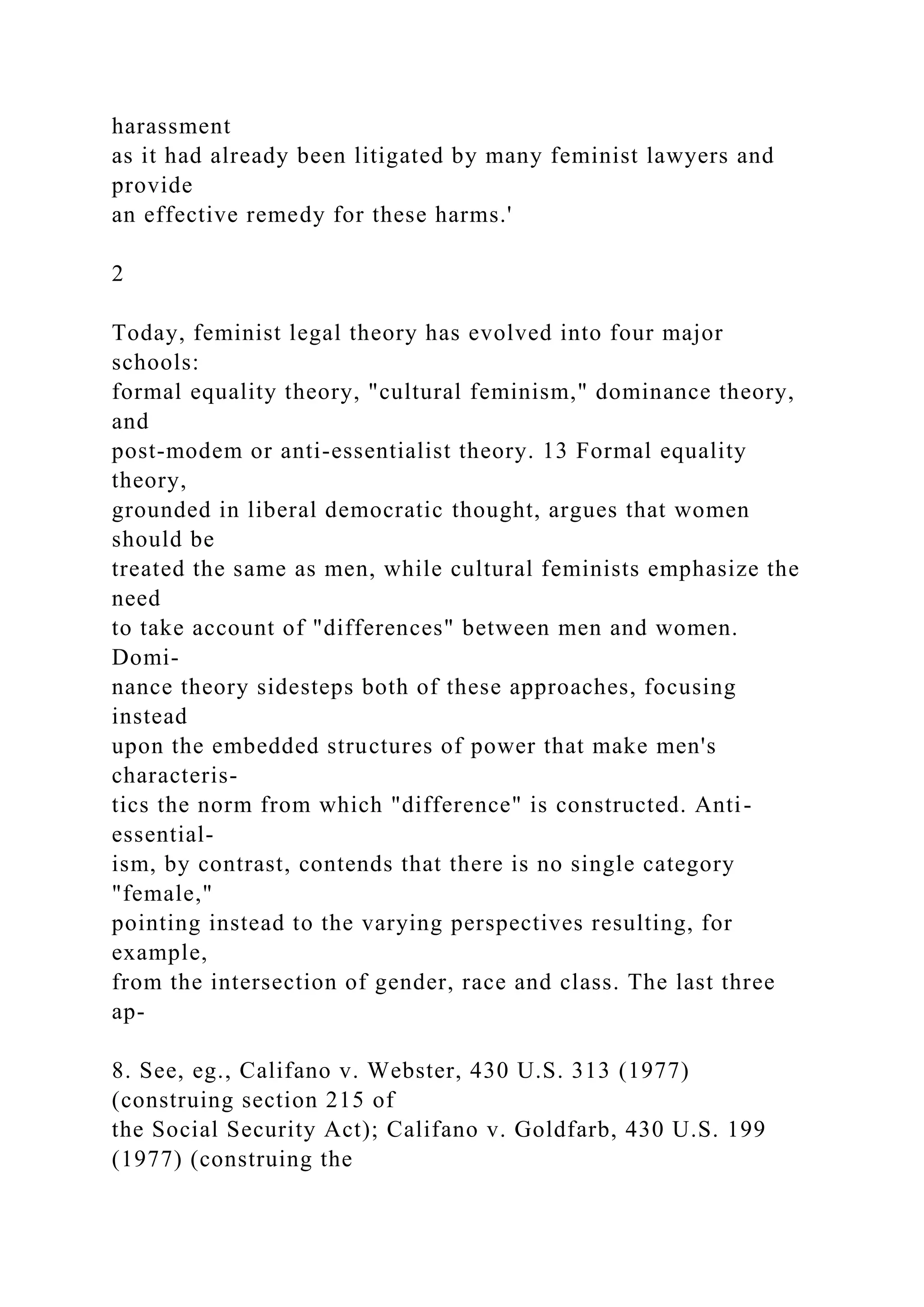

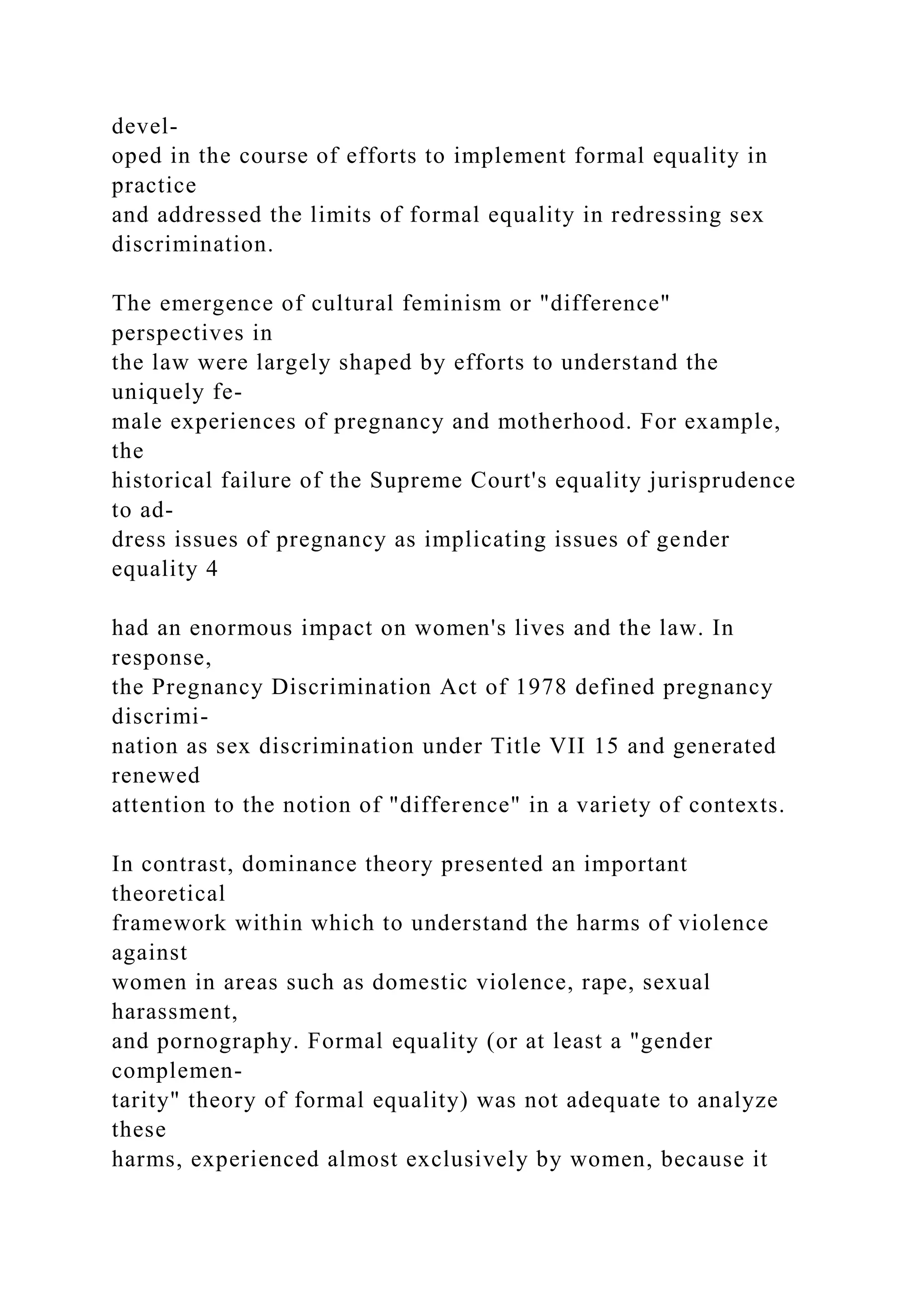
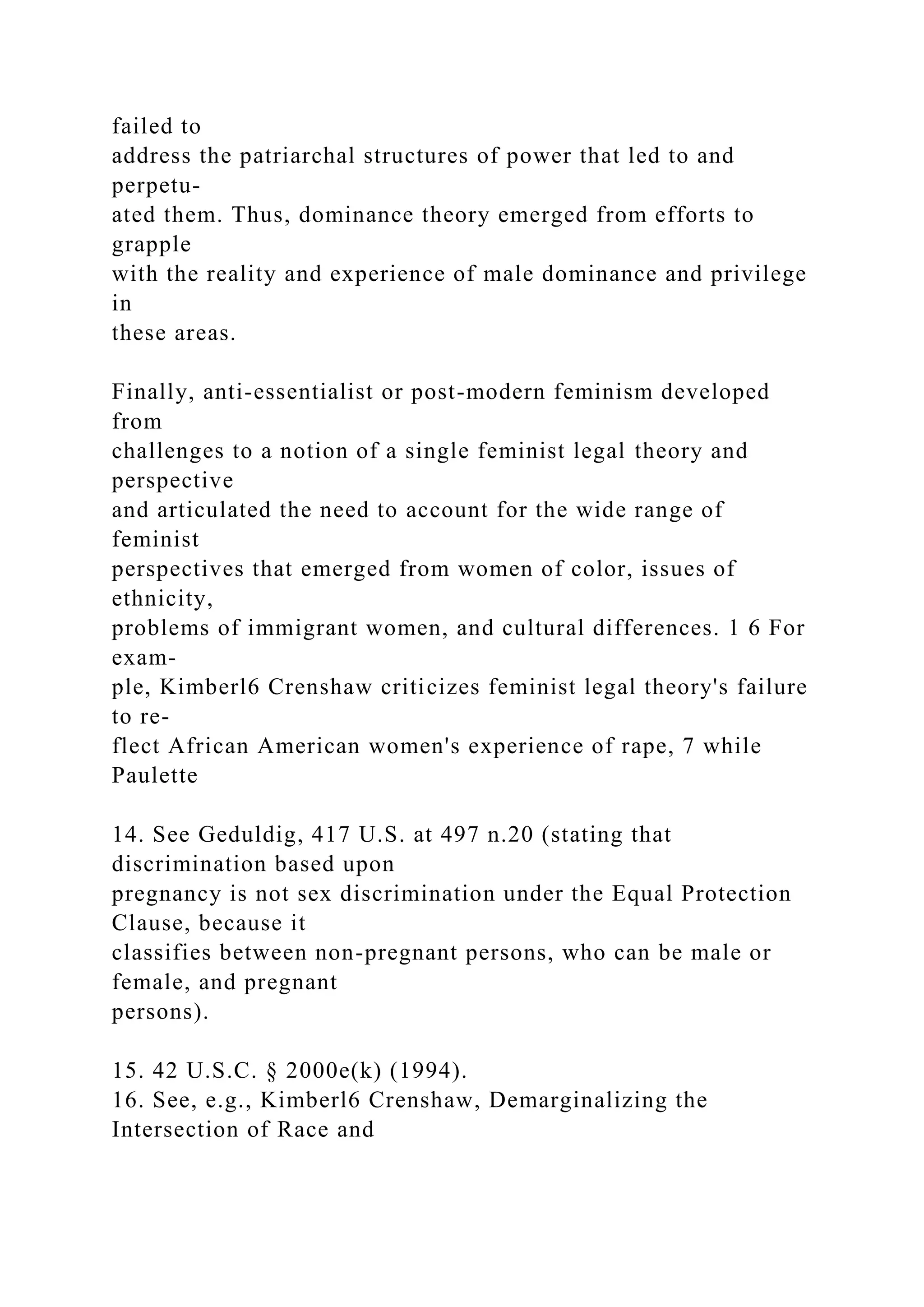
![Sex: A Black Feminist Critique of Antidiscrimination Doctrine,
Feminist Theory and
Antiracist Politics, 1989 U. Chi. Legal F. 139, 140 [hereinafter
Crenshaw, Demarginal-
izing the Intersection] (arguing that many of the experiences
that black women face
are not subsumed within the traditional boundaries of race or
gender discrimination);
Kimberl6 Crenshaw, Mapping the Margins: Identity Politics,
Intersectionality and Vio-
lence Against Women of Color, 43 Stan. L. Rev. 1241, 1242-44
(1991) (describing the
intersectional location of women of color and their
marginalization within dominant
resistance discourses); Angela P. Harris, Race and Essentialism
in Feminist Legal The-
ory, 42 Stan. L. Rev. 581, 585 (1990) (discussing the need for
multiple consciousness in
the feminist movement).
17. See Crenshaw, Demarginalizing the Intersection, supra note
16, at 157-60.
[Vol. 67
1998] FEMINIST LEGAL THEORY & LAWMAKING 253
Caldwell explains how employment discrimination law fails to
capture
discrimination that is motivated by both sex and race. 8 This
approach
has emphasized the importance of storytelling, both as a way to
bring
diverse experiences into the law and as a way to broaden the](https://image.slidesharecdn.com/twomodelsofthecriminalprocessherbertl-221102051712-61a17231/75/Two-Models-of-the-Criminal-ProcessHERBERT-L-PACKERSource-R-docx-39-2048.jpg)
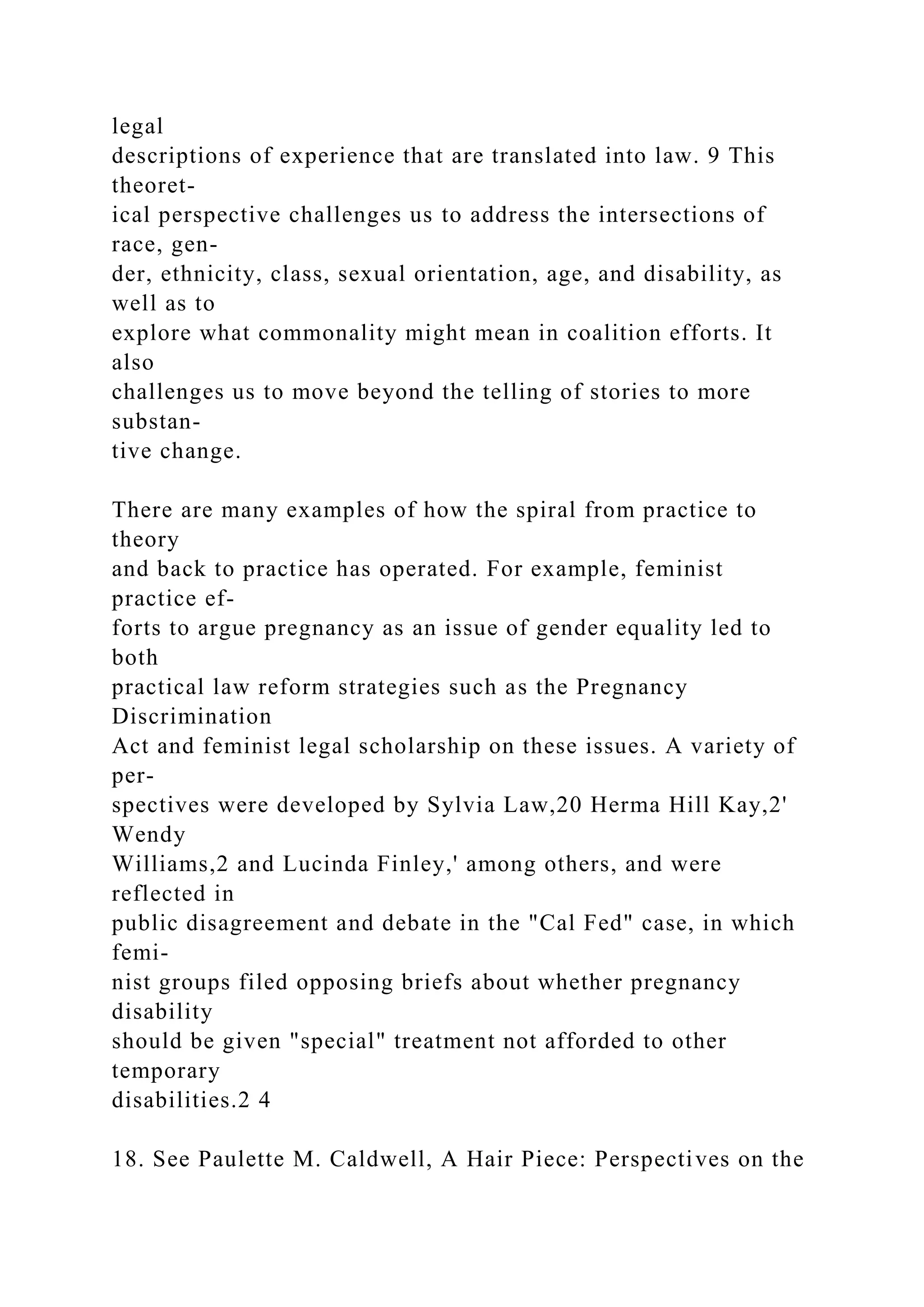

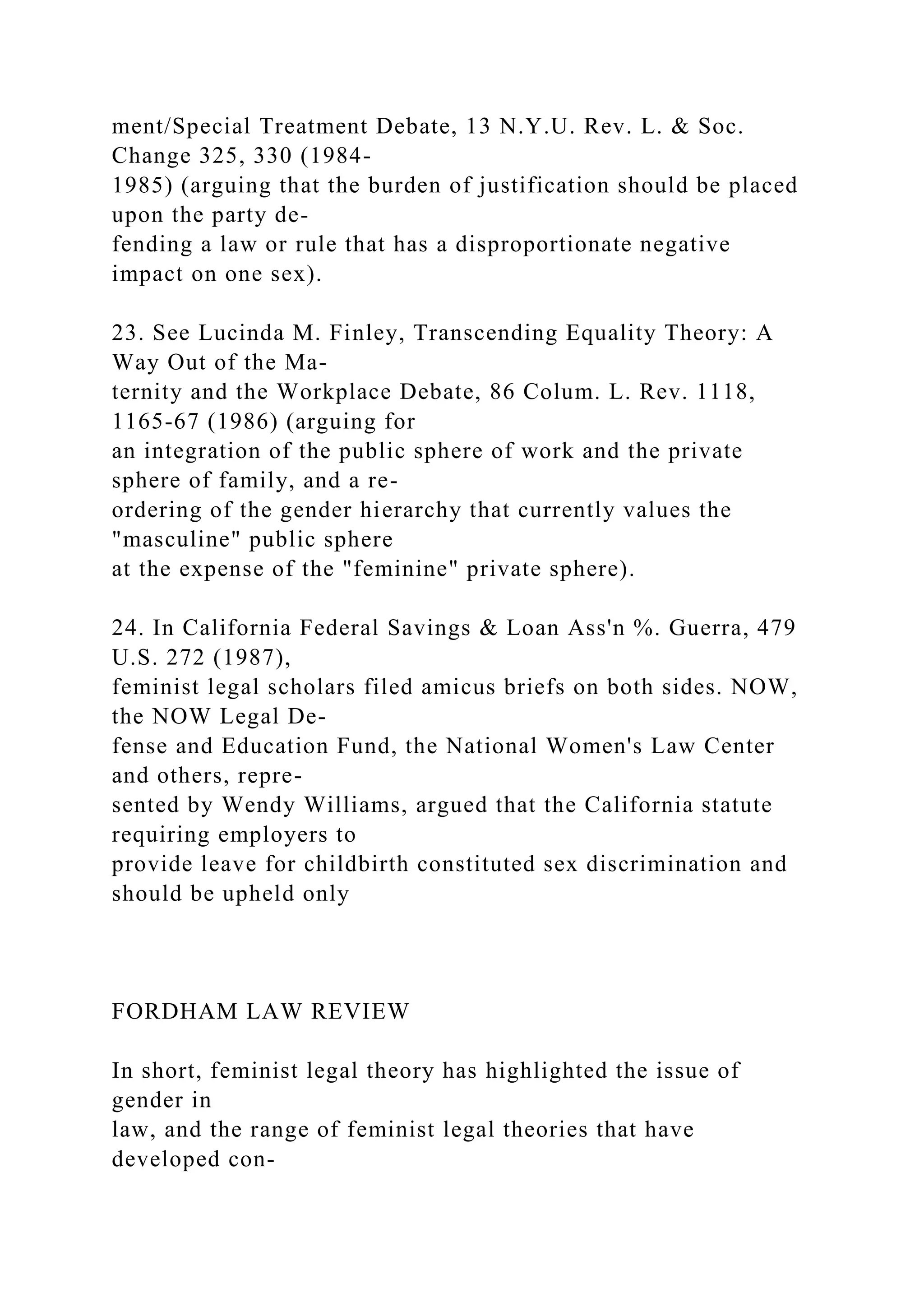
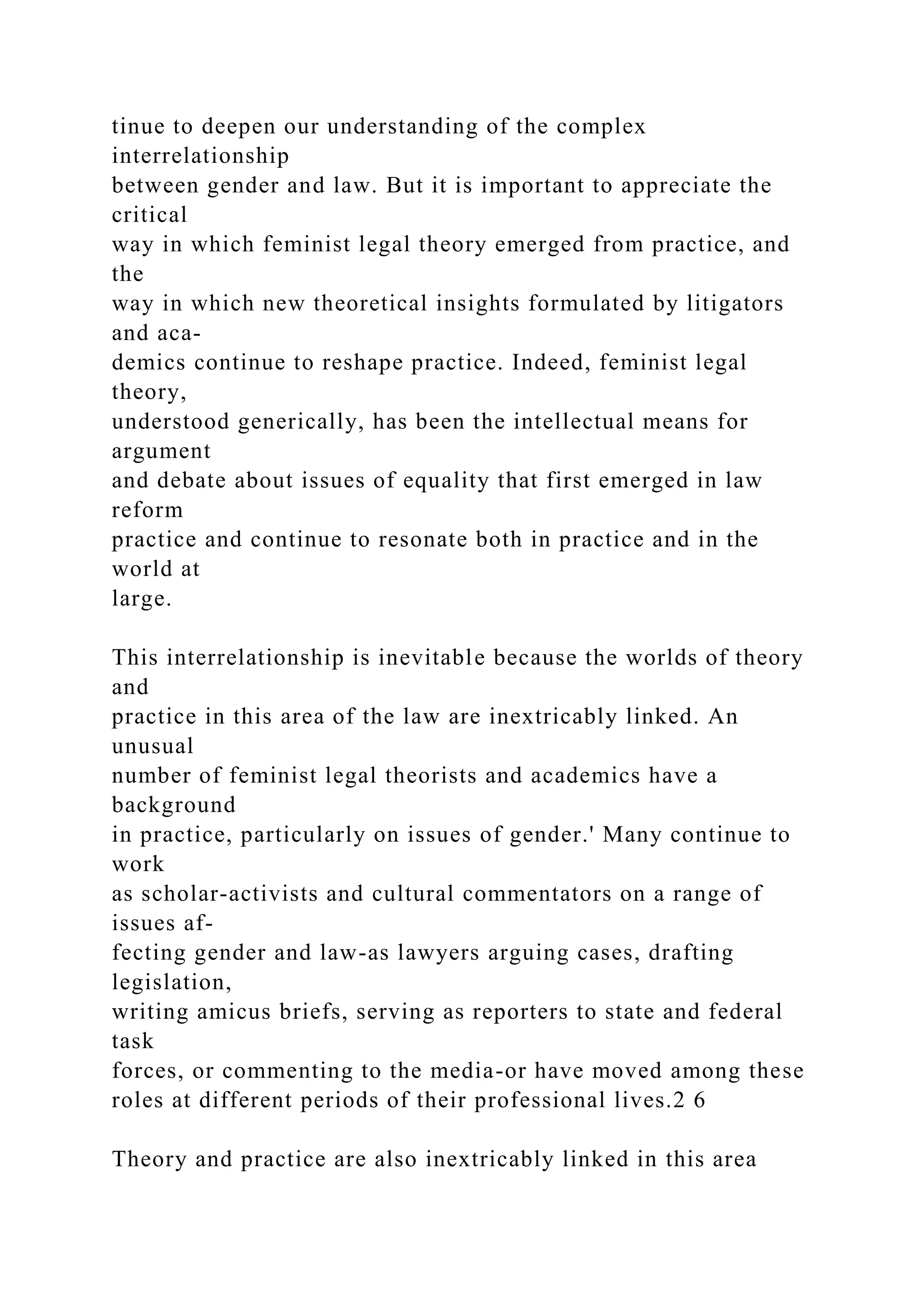

![Littleton, Judith Resnik, Deborah Rhode, Susan Deller Ross,
Nadine Taub, Wendy
Williams, and both authors of this article are among many who
have participated in
these different ways.
27. The Southern California Law Review, for example, held a
symposium on the
Hill-Thomas hearings, which produced, among other wonderful
pieces of scholarship,
Martha R. Mahoney's article, Exit: Power and the Idea of
Leaving in Love, Work, and
the Confirmation Hearings, 65 S. Cal. L. Rev. 1283 (1992). In
it, Mahoney attacks the
idea that if a woman does not leave a job or battering
relationship then the harass-
ment or violence against her either did not exist or could not
have been "so bad,"
arguing that this idea fails to recognize that women more
typically attempt to stop the
attacks and preserve what is rewarding about the job or
relationship (as well as to
avoid the even greater problems that leaving can pose). See id.
at 1300-04.
[Vol. 67
1998] FEMINIST LEGAL THEORY & LAWMAKING 255
mestic violence and intimate femicide to public attention and, in
turn,
generated feminist analysis.' Current debates concerning
President
Clinton, Paula Jones, and Monica Lewinsky again bring issues](https://image.slidesharecdn.com/twomodelsofthecriminalprocessherbertl-221102051712-61a17231/75/Two-Models-of-the-Criminal-ProcessHERBERT-L-PACKERSource-R-docx-45-2048.jpg)
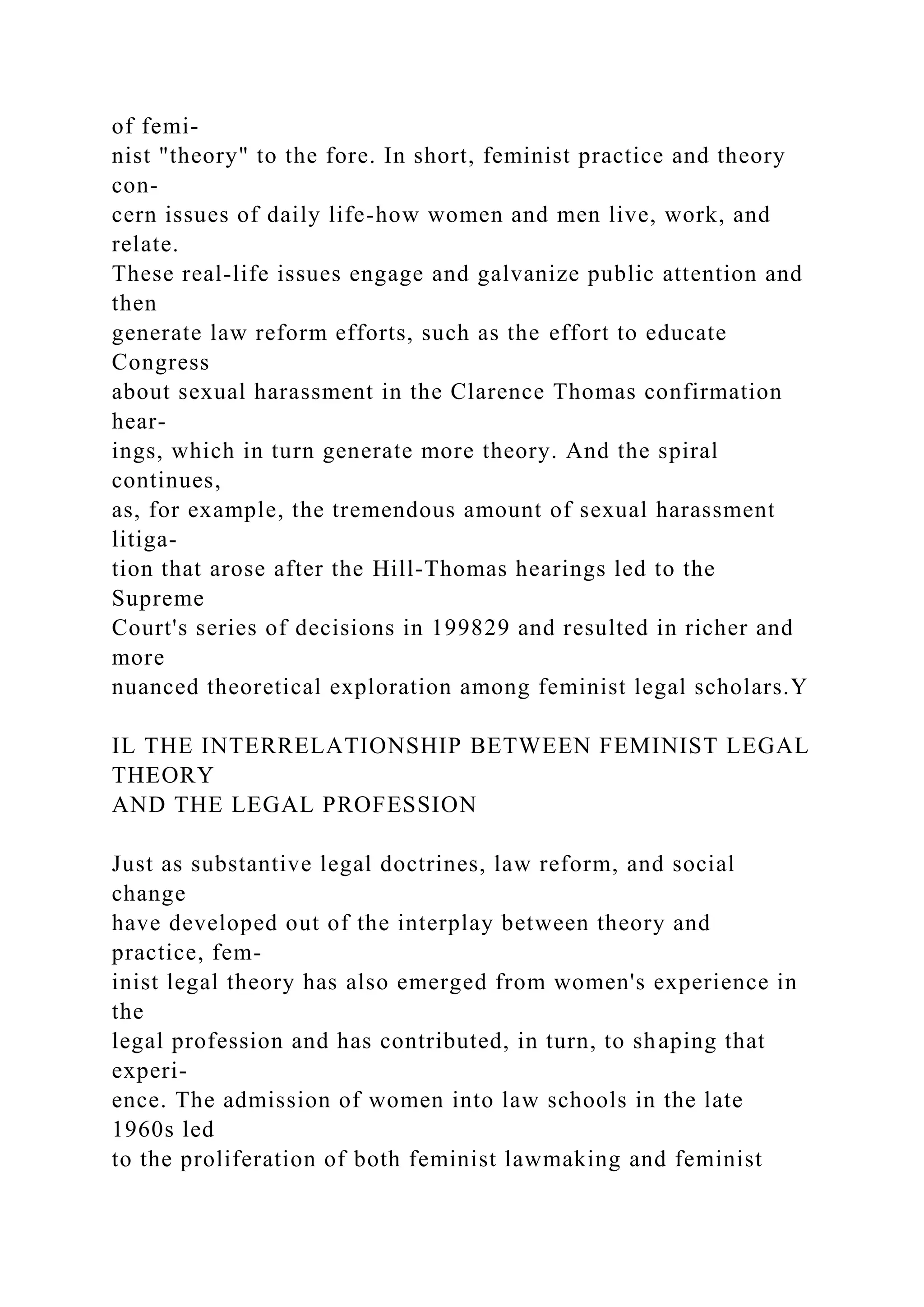
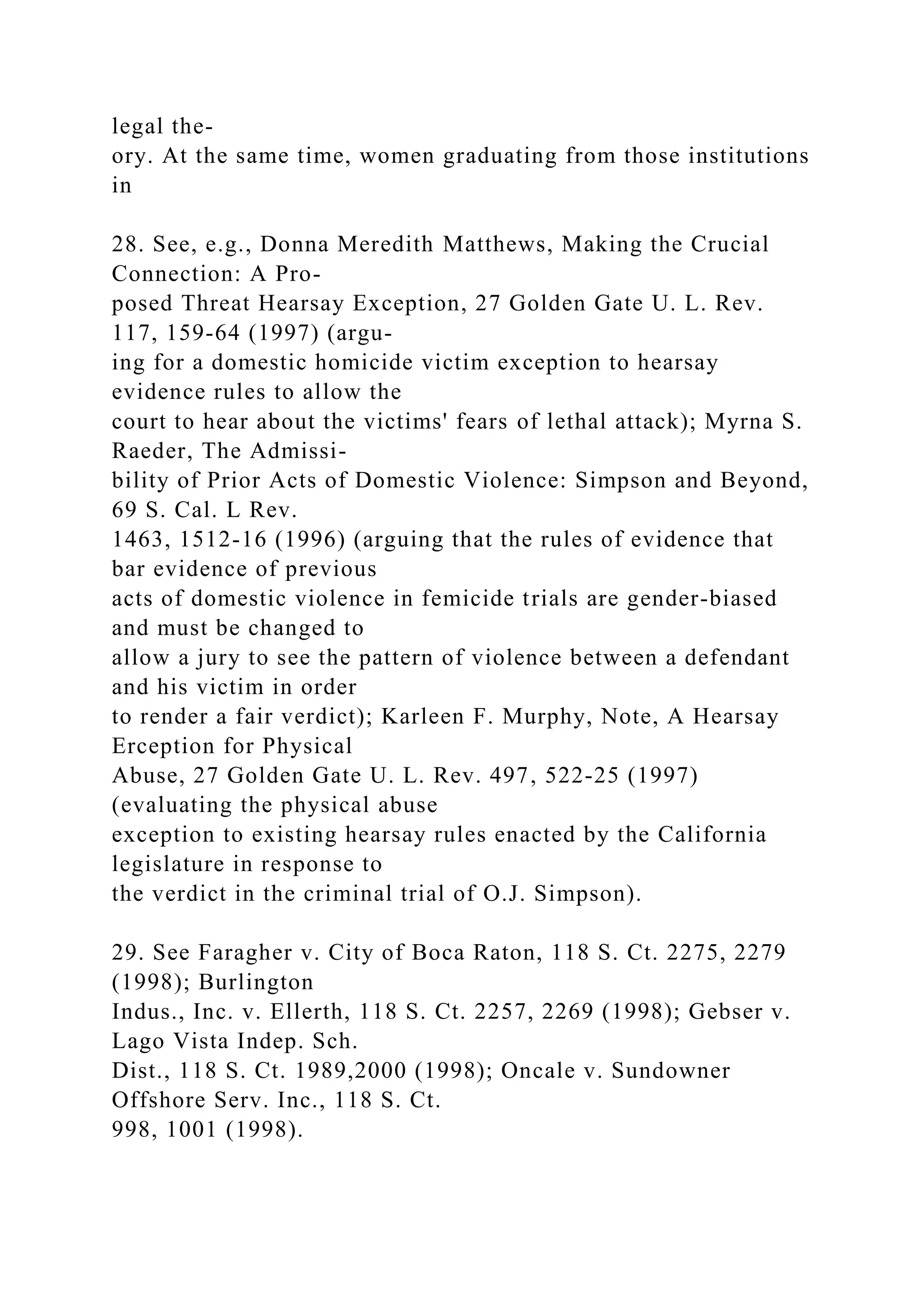
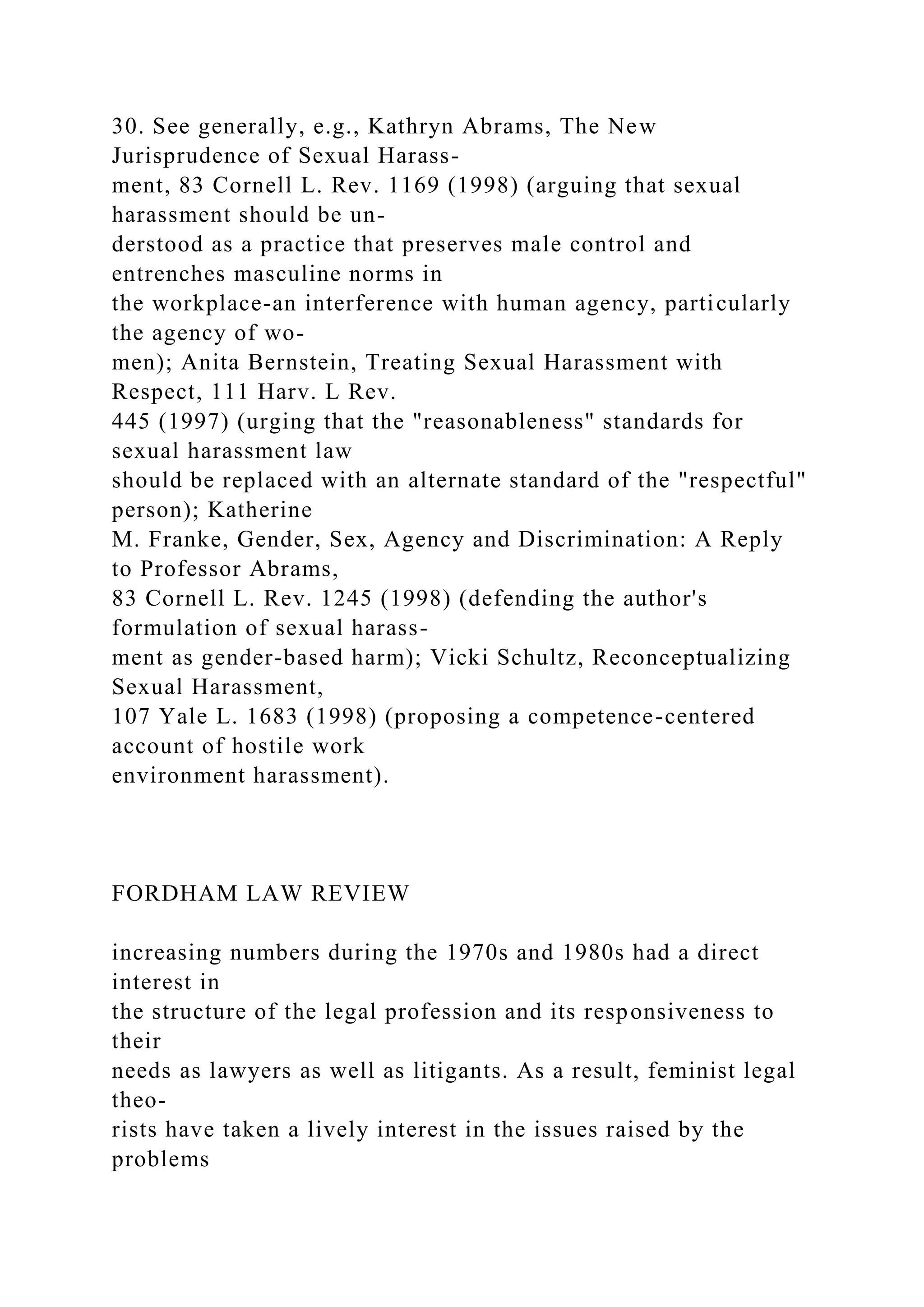
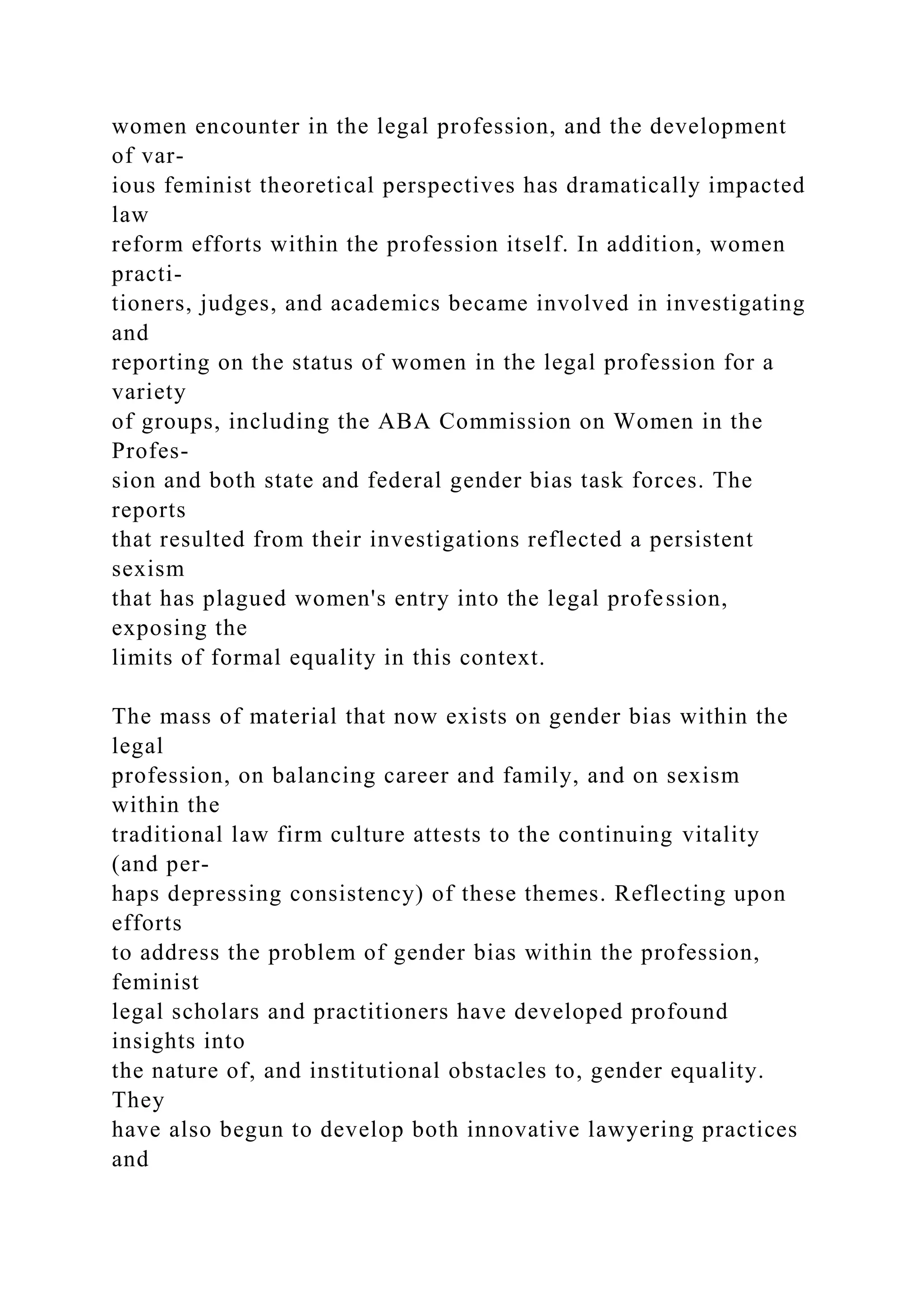
![theories about the legal profession, the status of women within
it, and
sources of change. Like the development of substantive legal
doc-
trines, theory in this context cannot be divorced from practice
and
from the real-life experiences of women.
A. Formal Equality as the Route into the Legal Profession
To paraphrase Catharine MacKinnon, women lawyers cannot
help
but have a certain affection for formal equality theory, because
it was
responsible for gaining them access to the legal profession on
the
same terms as men.3 1 With some exceptions, women were
largely ex-
cluded from legal education for much of the nineteenth and
twentieth
centuries. Harvard Law School admitted its first women
students only
in 1950, and a few other schools excluded women until the
1960s and
1970s.32 Even then, women law students faced other barriers,
as ad-
missions quotas restricted their numbers and hostility greeted
their
presence in the classroom.3 3 Federal anti-discrimination laws,
31. See Catharine A. MacKinnon, Difference and Dominance:
On Sex Discrimina-
tion, in Feminism Unmodified: Discourses on Life and Law 32,
35 (1987) ("I have to
confess a sincere affection for [formal equality theory] .... It has
gotten women some](https://image.slidesharecdn.com/twomodelsofthecriminalprocessherbertl-221102051712-61a17231/75/Two-Models-of-the-Criminal-ProcessHERBERT-L-PACKERSource-R-docx-50-2048.jpg)
![access to employment and education, the public pursuits,
including academic, profes-
sional, and blue-collar work .... " (citations omitted)).
32. See Cynthia Fuchs Epstein, Women in Law 50 (1981).
33. See id. at 63-67; Karen Berger Morello, The Invisible Bar:
The Woman Law-
yer in America: 1638 to the Present 103-07 (1986).
[Vol. 67
1998] FEMINIST LEGAL THEORY & LAWMAKING 257
grounded in notions of formal equality, were responsible for
shatter-
ing outright barriers to access to legal education. 34 In March
1971, the
Professional Women's Caucus filed a class action lawsuit
against every
law school in the country receiving federal funds, based in part
on
preliminary statistics provided by the Association of American
Law
Schools' Committee on Women in Legal Education." Thereafter,
the
number of women studying law increased from 8.5% of the total
in
1970 to 33.5% in 1980,36 and has hovered between 40% and
50% since
1986.37
Upon graduation from law school, women still faced barriers to
ob-](https://image.slidesharecdn.com/twomodelsofthecriminalprocessherbertl-221102051712-61a17231/75/Two-Models-of-the-Criminal-ProcessHERBERT-L-PACKERSource-R-docx-51-2048.jpg)

![positions at the top of the law firm hierarchy.4" Women's
continuing
role as the primary caretakers of children (and of elderly
persons and
households in general) appeared to be incompatible with the
structure
of high-powered legal work, with its requirements for very long
hours
worked away from home.
34. See Becker et al., supra note 3, at 825-26; Herma Hill Kay
& Martha S. West,
Sex-Based Discrimination: Text, Cases and Materials 1121-23
(4th ed. 1996).
35. See Judith Hole & Ellen Levine, Rebirth of Feminism 103
(1971).
36. See Epstein, supra note 32, at 53.
37. See Commission on Women in the Profession, American Bar
Ass'n, Unfin-
ished Business: Overcoming the Sisyphus Factor 7 (1995)
[hereinafter ABA 1995
Report].
38. See Epstein, supra note 32, at 83-95; Morello, supra note
33, at 194-217.
39. See Epstein, supra note 32, at 184-88; Morello, supra note
33, at 210-15.
40. See Commission on Women in the Profession, American Bar
Ass'n, Report to
the House of Delegates 5 (1988) [hereinafter ABA 1988
Report]; Mona Harrington,
Women Lawyers: Rewriting the Rules 37-38 (1994).](https://image.slidesharecdn.com/twomodelsofthecriminalprocessherbertl-221102051712-61a17231/75/Two-Models-of-the-Criminal-ProcessHERBERT-L-PACKERSource-R-docx-53-2048.jpg)
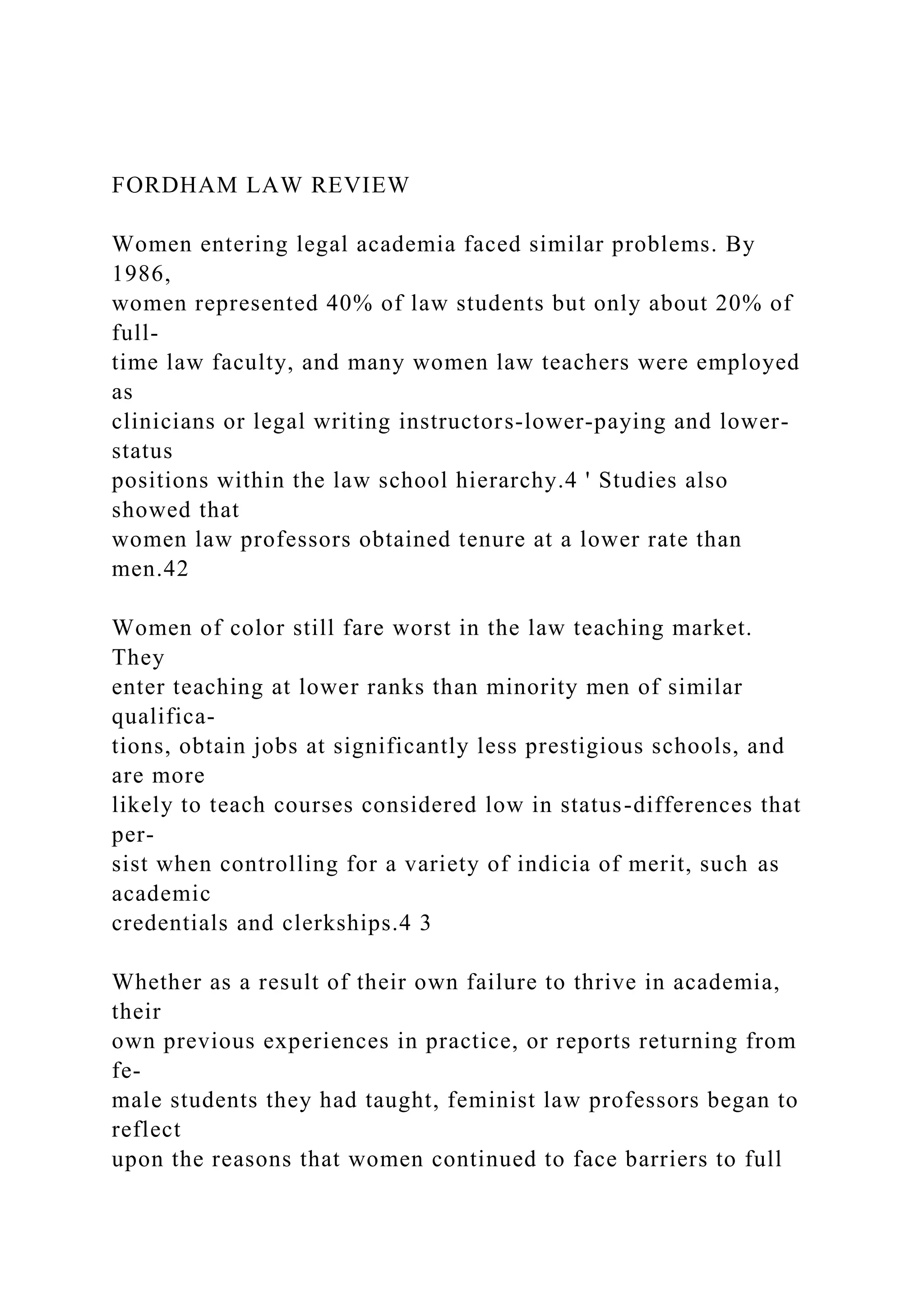
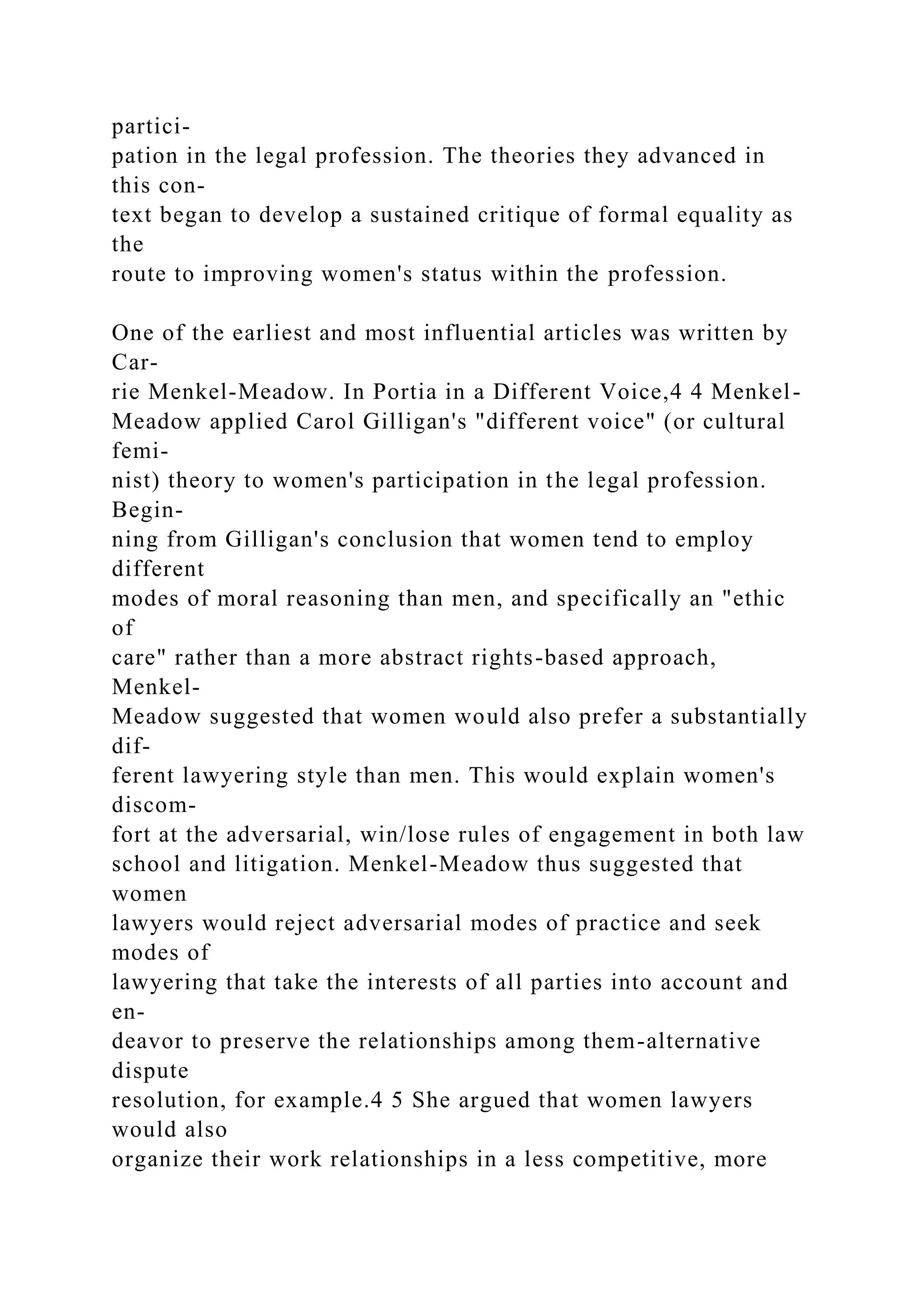
![collabo-
41. See Marina Angel, Women in Legal Education: What It's
Like to Be Part of a
Perpetual First Wave or the Case of the Disappearing Women,
61 Temp. L. Rev. 799,
803 (1988).
42. See Richard H. Chused, The Hiring and Retention of
Minorities and Women on
American Law School Faculties, 137 U. Pa. L. Rev. 537, 550
(1988).
43. See Deborah J. Merritt et al., Family, Place, and Career: The
Gender Paradox
in Law School Hiring, 1993 Wis. L. Rev. 395, 405-06.
44. Carrie Menkel-Meadow, Portia in a Different Voice:
Speculations on a Wo-
men's Lawyering Process, 1 Berkeley Women's L.J. 39 (1985)
[hereinafter Menkel-
Meadow, Portia in a Different Voice]; see Carrie Menkel-
Meadow, Portia Redux: An-
other Look at Gender, Feminism, and Legal Ethics, 2 Va. J. Soc.
Pol'y & L. 75 (1994).
45. See Menkel-Meadow, Portia in a Different Voice, supra note
44, at 50-55.
[Vol. 67
1998] FEMINIST LEGAL THEORY & LAWMAKING 259
rative, and egalitarian manner and would structure the](https://image.slidesharecdn.com/twomodelsofthecriminalprocessherbertl-221102051712-61a17231/75/Two-Models-of-the-Criminal-ProcessHERBERT-L-PACKERSource-R-docx-56-2048.jpg)
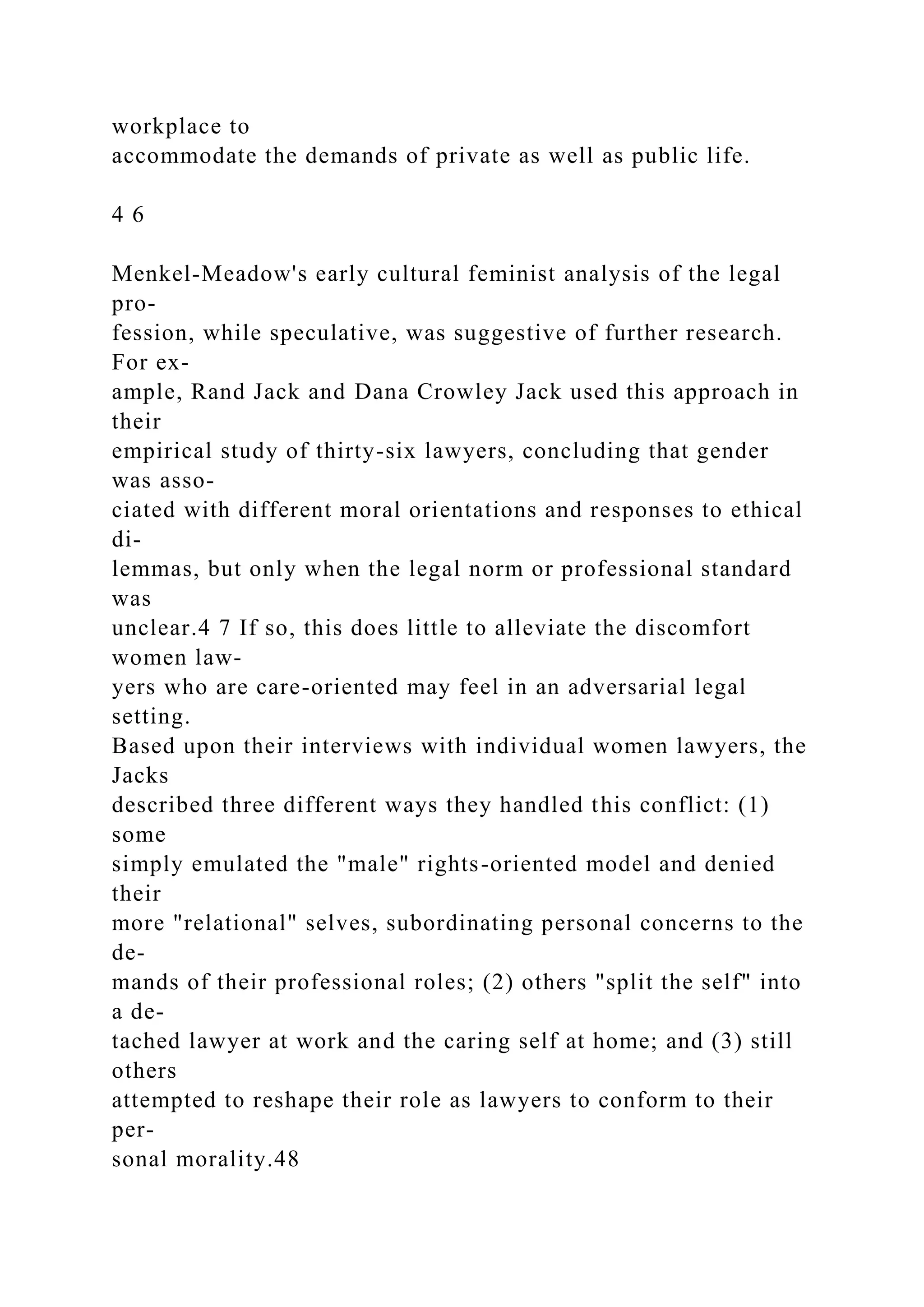
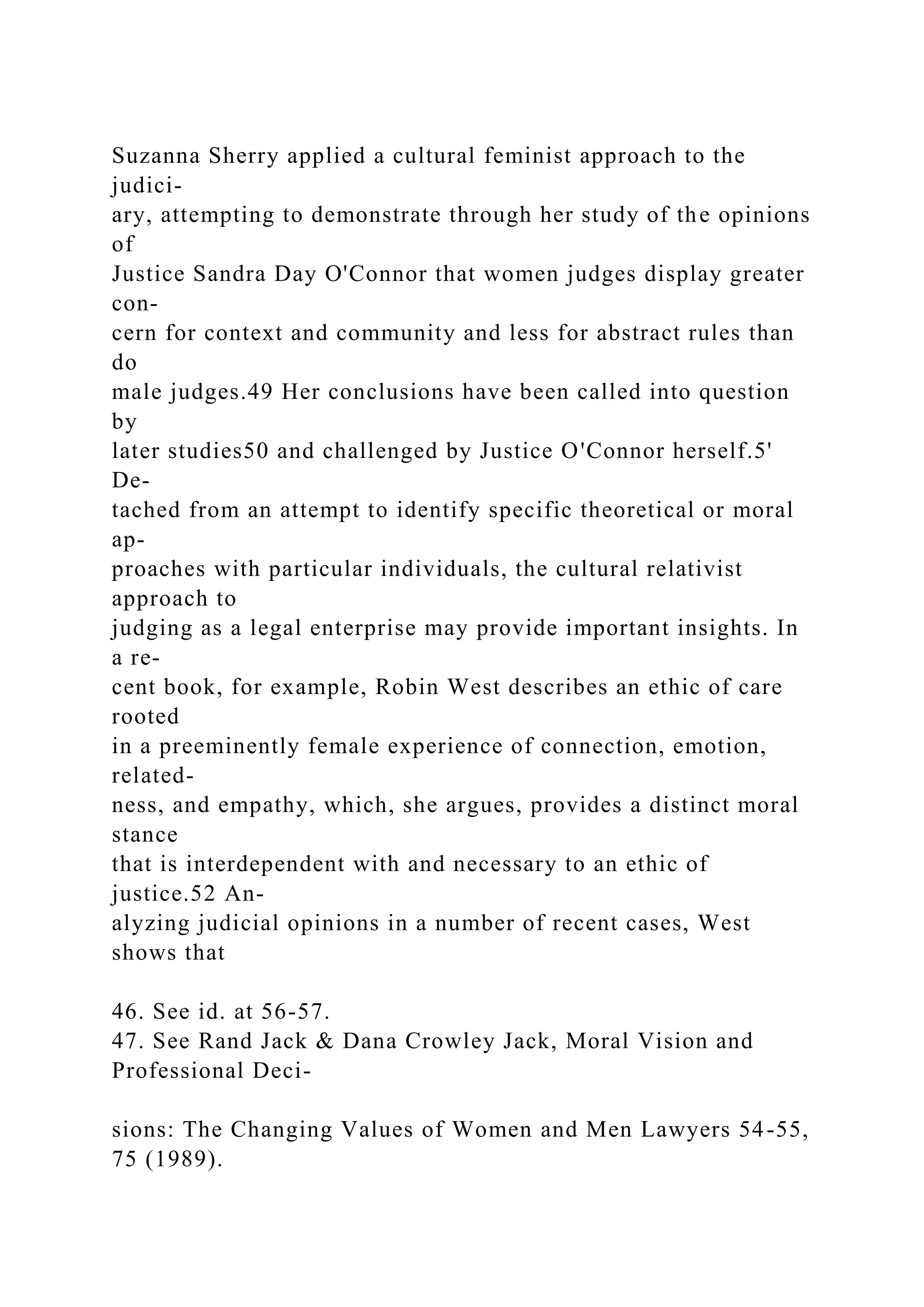
![48. See i. at 130-55.
49. See Suzanna Sherry, Civic Virtue and the Feminine Voice in
Constitutional Ad-
judication, 72 Va. L. Rev. 543, 592-613 (1986).
50. See, e.g., Sue Davis, The Voice of Sandra Day O'Connor, 77
Judicature 134,
138-39 (1993) (concluding that Justice O'Connor's record
"do[es] very little to support
the assertion that [her] decision making is distinct by virtue of
her gender"). A recent
article compared the decisions of Justices O'Connor and
Ginsburg and concluded that
the differences, driven primarily by ideology, between them
were more significant
than the similarities. See Michael E. Solimine & Susan E.
Wheatley, Rethinking Femi-
nist Judging, 70 Ind. LJ. 891, 900-05 (1995).
51. See Sandra Day O'Connor, Portia's Progress, 66 N.Y.U. L
Rev. 1546, 1558
(1991).
52. See Robin West, Caring for Justice 22-93 (1997).
FORDHAM LAW REVIEW
a judge who fails on either branch-justice or care-fails to render
a
genuinely just decision.53 Thus, the insights of cultural
relativism,
drawn from the experiences of women's lives, are "fed back"
into the](https://image.slidesharecdn.com/twomodelsofthecriminalprocessherbertl-221102051712-61a17231/75/Two-Models-of-the-Criminal-ProcessHERBERT-L-PACKERSource-R-docx-59-2048.jpg)
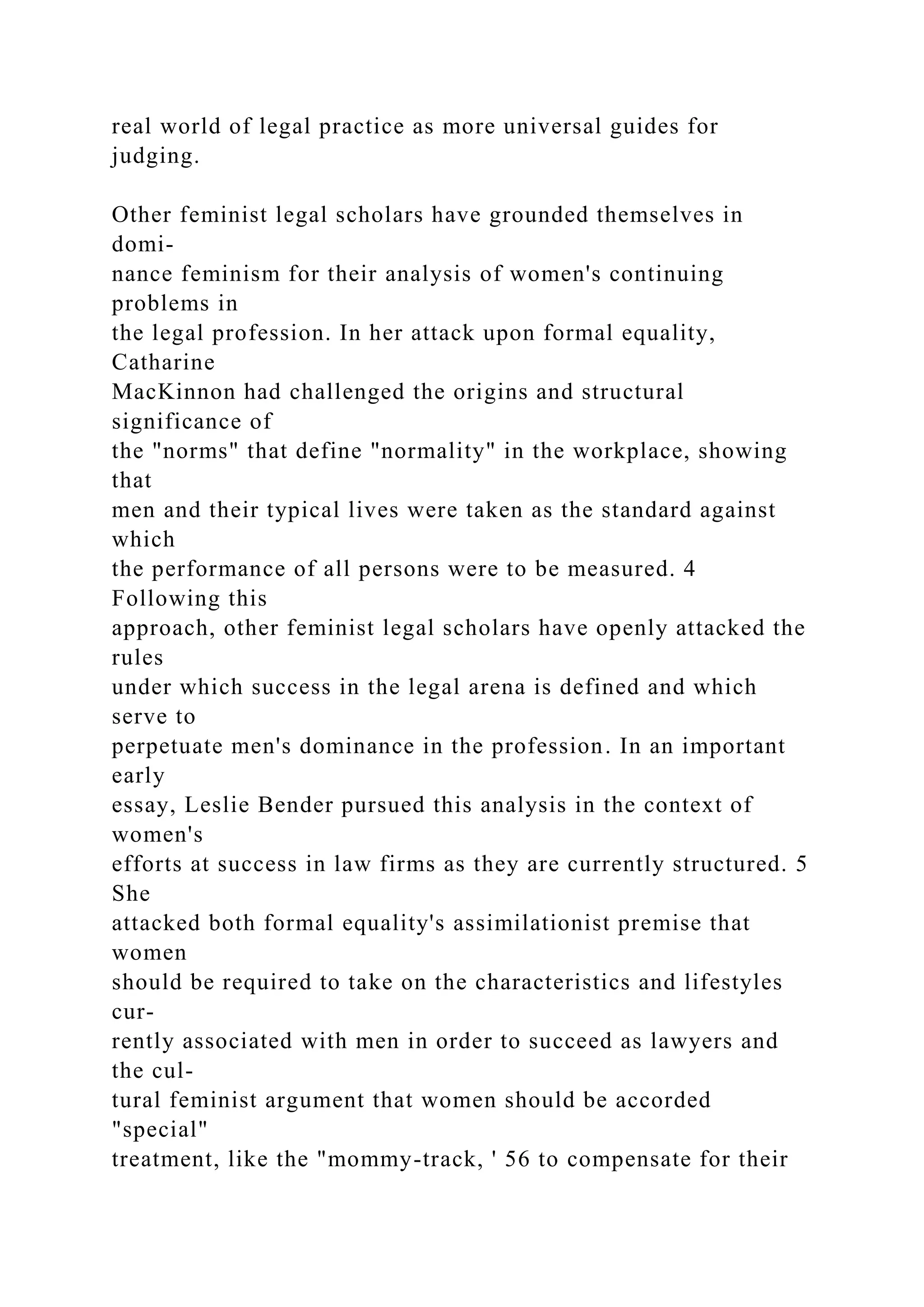
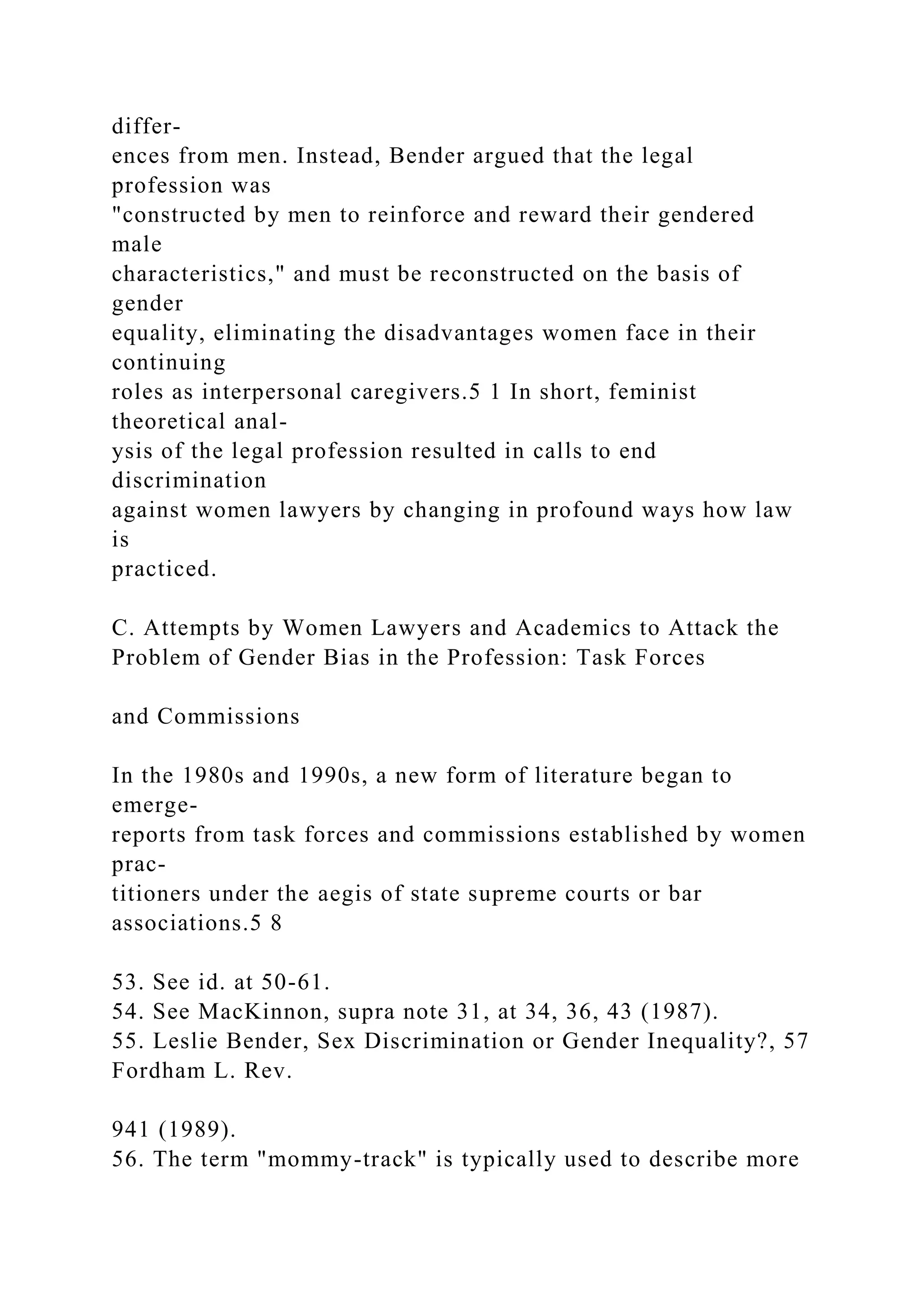
![flexible, often
part-time, working arrangements established for women with
small children. See id. at
943.
57. Id. at 949.
58. The first reports were published in the early 1980s by task
forces established
by the New Jersey and New York supreme courts, at the
instigation of women judges
and practitioners. See The First Year Report of the New Jersey
Supreme Court Task
[Vol. 67
1998] FEMINIST LEGAL THEORY & LAWMAKING 261
The gender bias task force movement provides the most striking
ex-
ample of this development, which compiled and described the
exper-
iences of women in the legal system both as lawyers and
litigants. The
material assembled by the task forces provided data about the
problems women lawyers continued to experience in the
profession,
and some included suggestions for change. In addition,
publication of
the reports was official recognition that discrimination against
women
in the legal profession continued to exist and thus legitimized
the](https://image.slidesharecdn.com/twomodelsofthecriminalprocessherbertl-221102051712-61a17231/75/Two-Models-of-the-Criminal-ProcessHERBERT-L-PACKERSource-R-docx-62-2048.jpg)
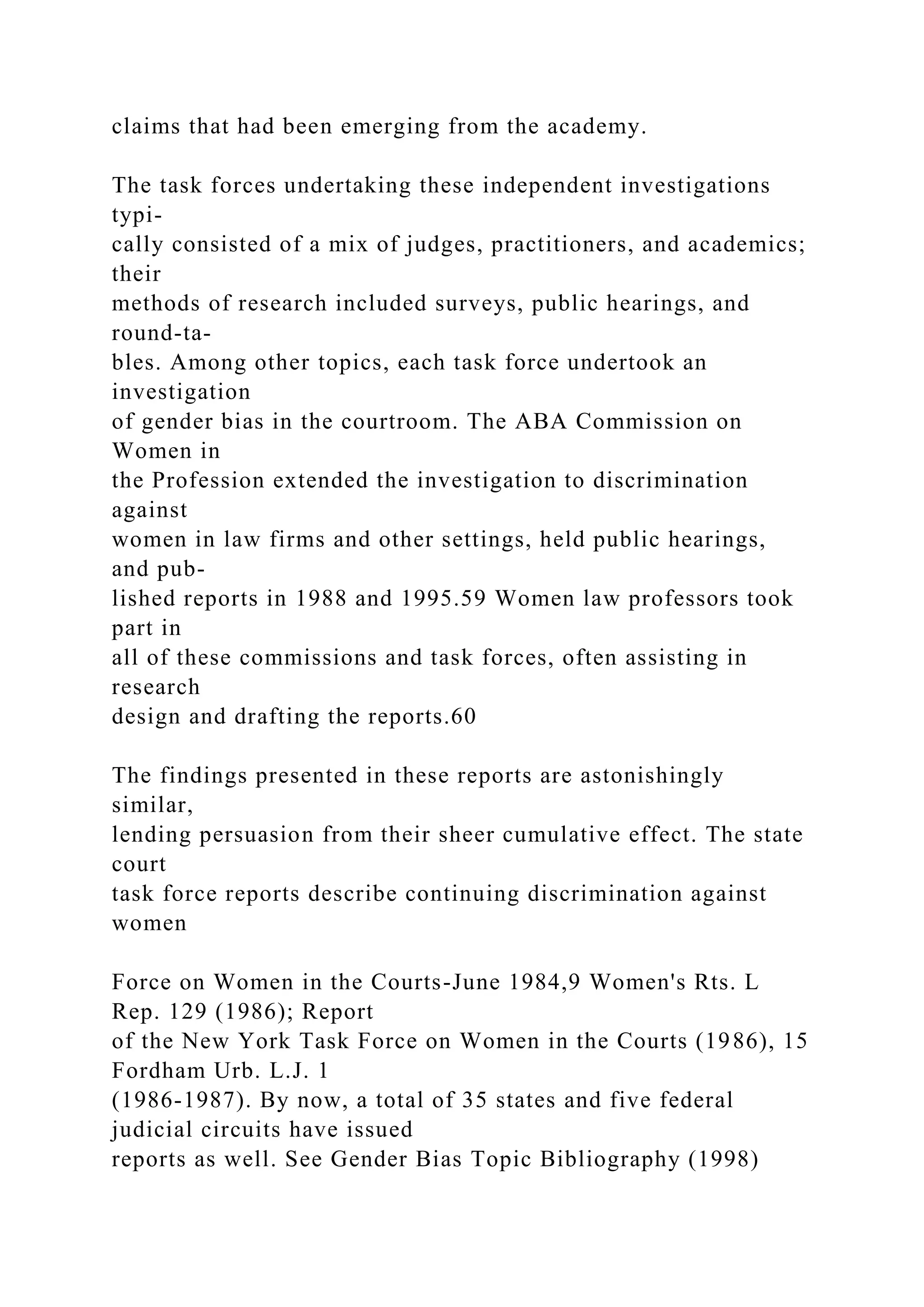
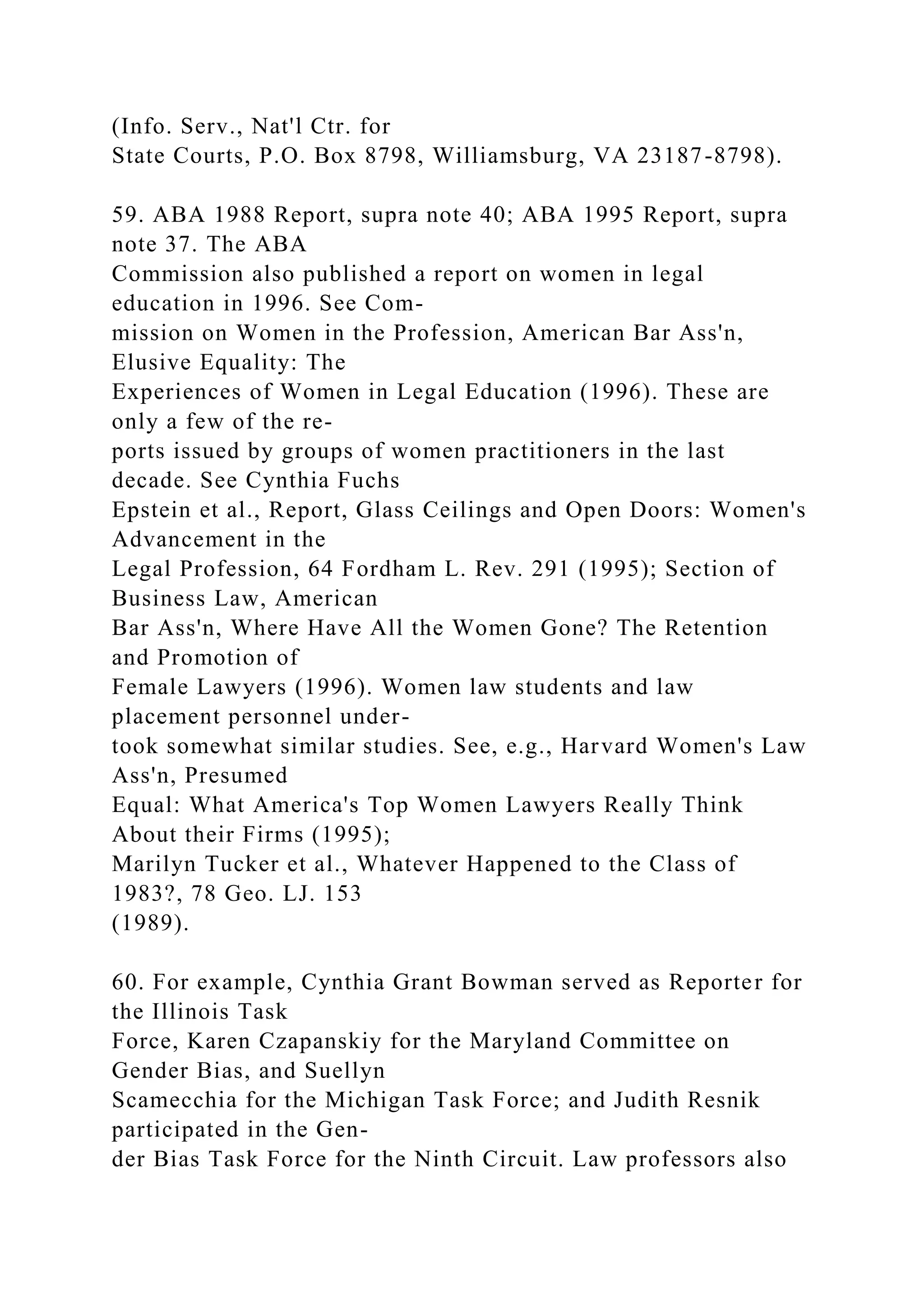
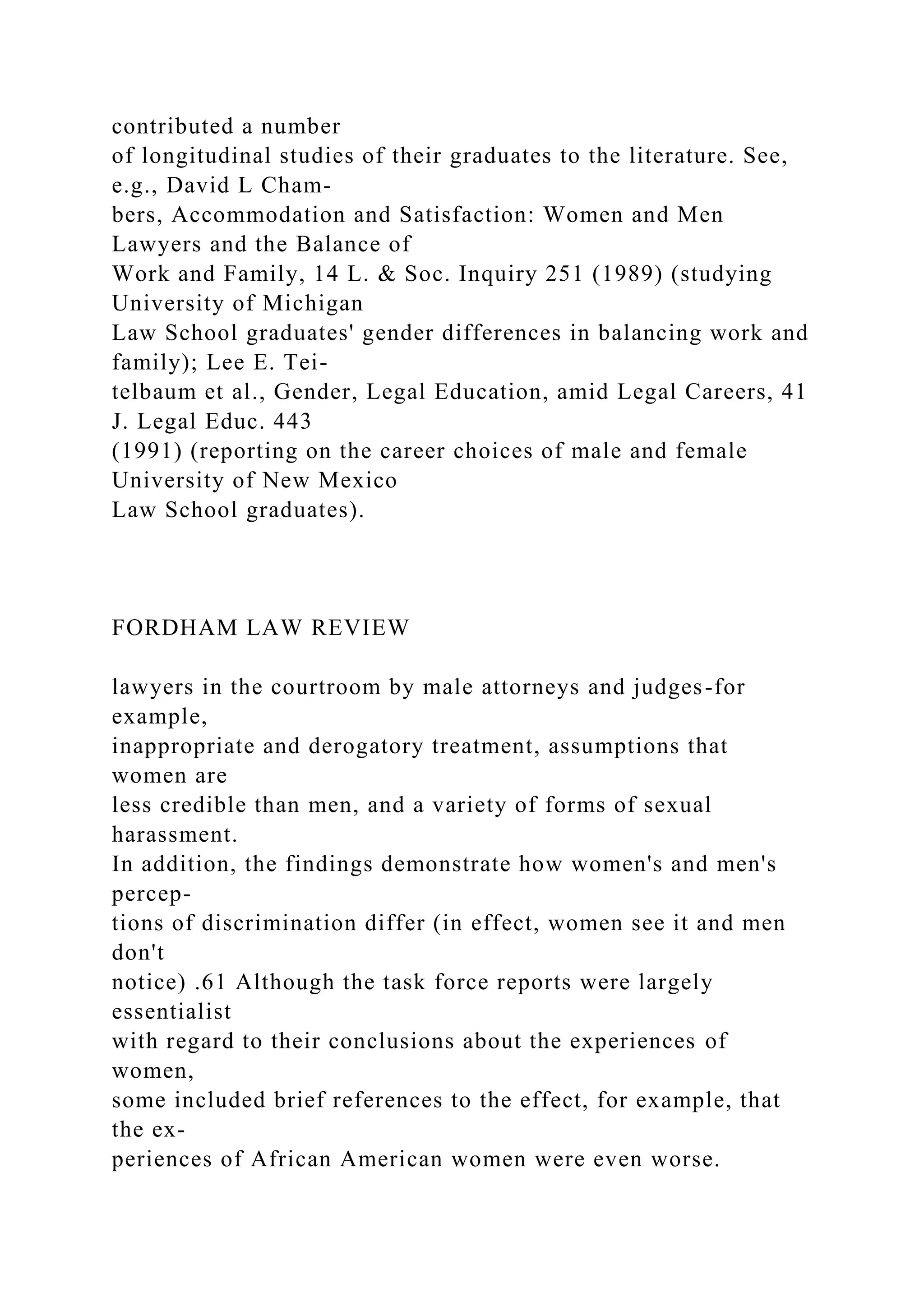
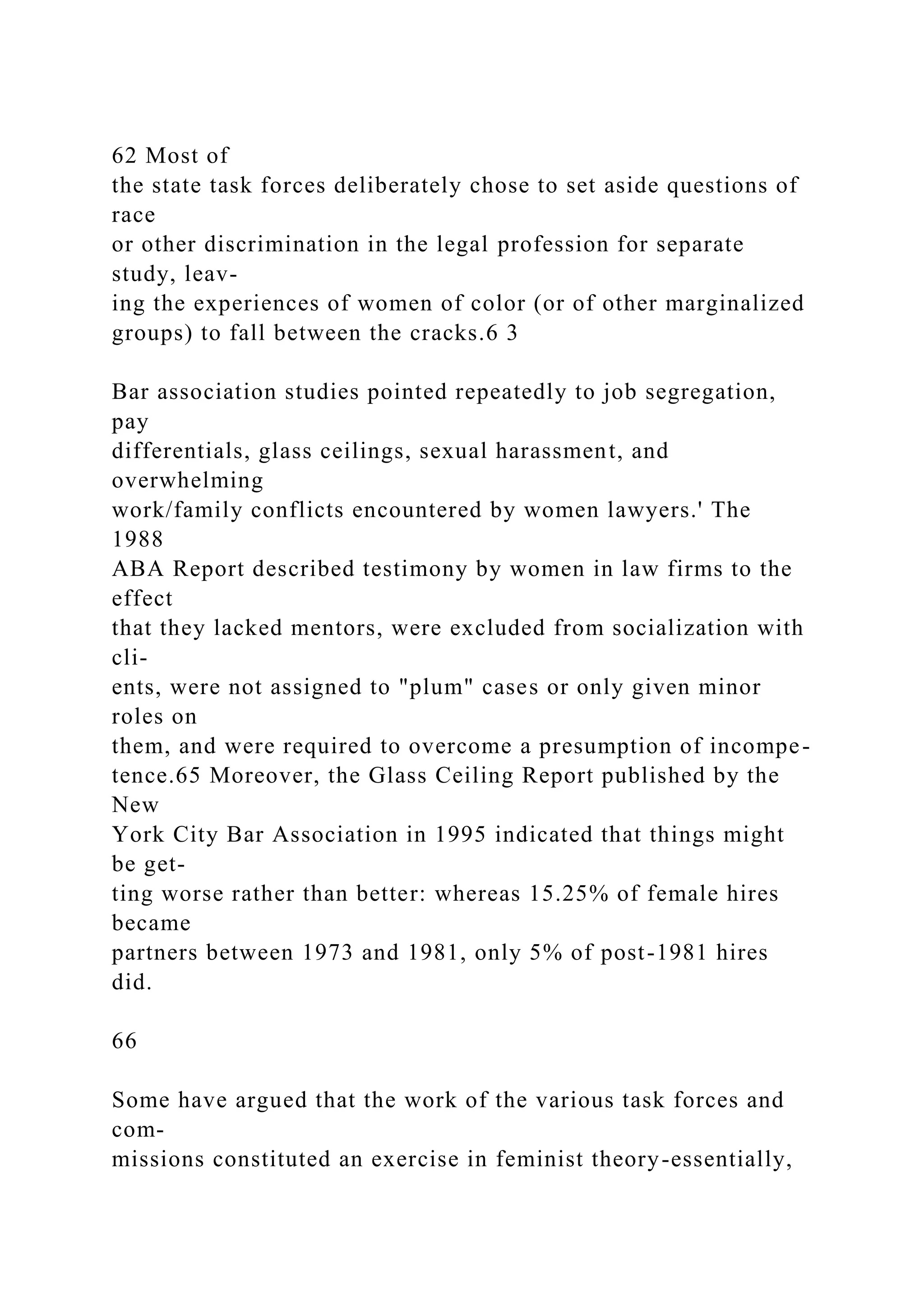
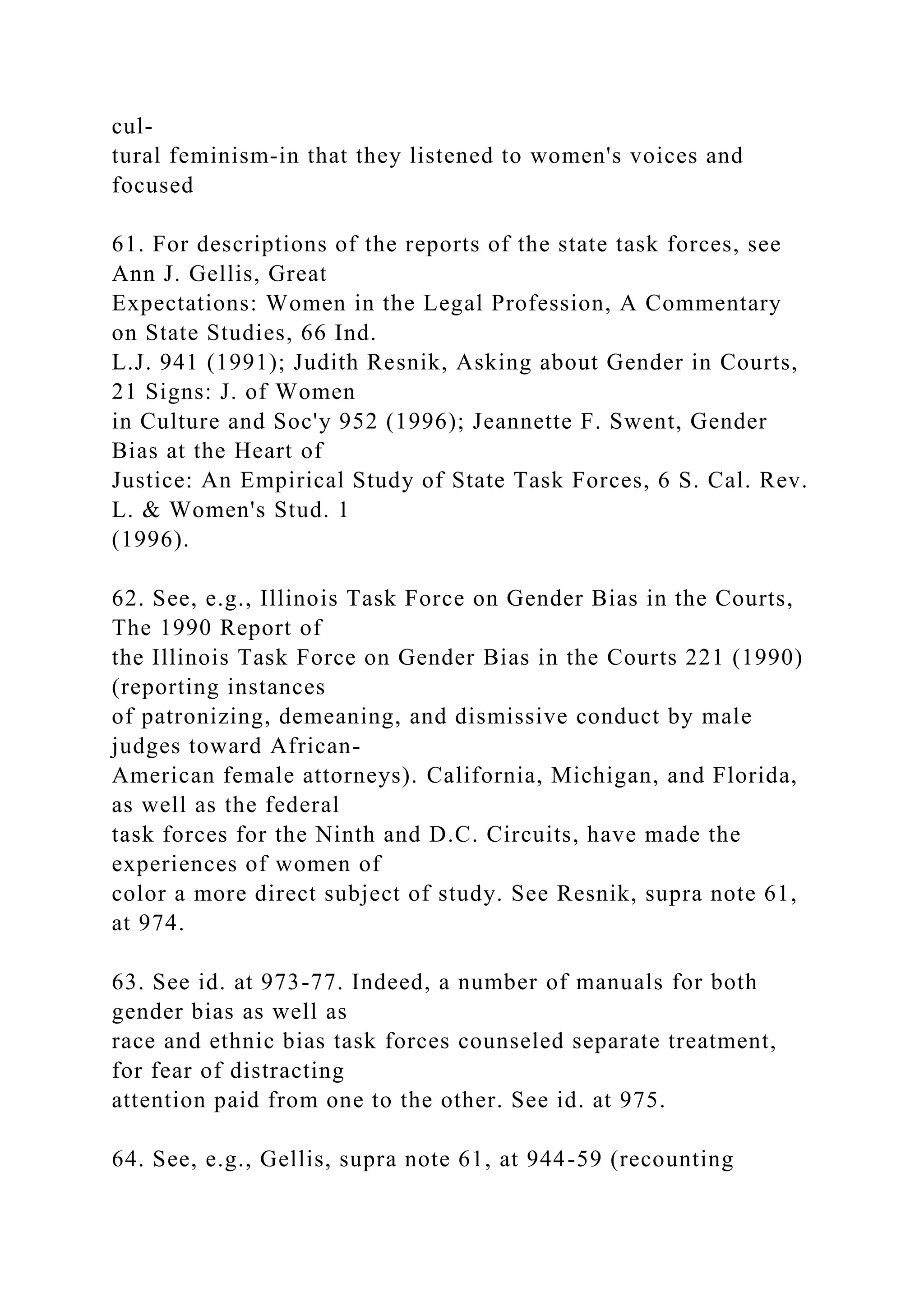
![dissimilarities between
men and women lawyers with respect to financial rewards,
opportunities for advance-
ment, firm dynamics, discrimination, and gender issues).
65. See ABA 1988 Report, supra note 40, at 11-12; see also
ABA 1995 Report,
supra note 37, at 10.
66. See Epstein et al., supra note 59, at 358-59.
[Vol. 67
1998] FEMINIST LEGAL THEORY & LAWMAKING 263
upon women's experiences as different from men's. 7 The
theoretical
grounding of the various studies carried out by the bench and
the bar,
however, was formal equality; this was perhaps inevitable,
given the
composition of the groups that authored them, which included
power-
ful "insiders."6 Thus, discrimination against women was
regarded
primarily as an aberration perpetrated against individuals, the
contin-
uation of outdated stereotypes, and an irrationality rather than a
structural problem requiring radical change in the profession.6 9
As a
result of this theoretical grounding, recommendations for
change
tended to be incremental, partial, and aimed at a particular
manifesta-](https://image.slidesharecdn.com/twomodelsofthecriminalprocessherbertl-221102051712-61a17231/75/Two-Models-of-the-Criminal-ProcessHERBERT-L-PACKERSource-R-docx-68-2048.jpg)
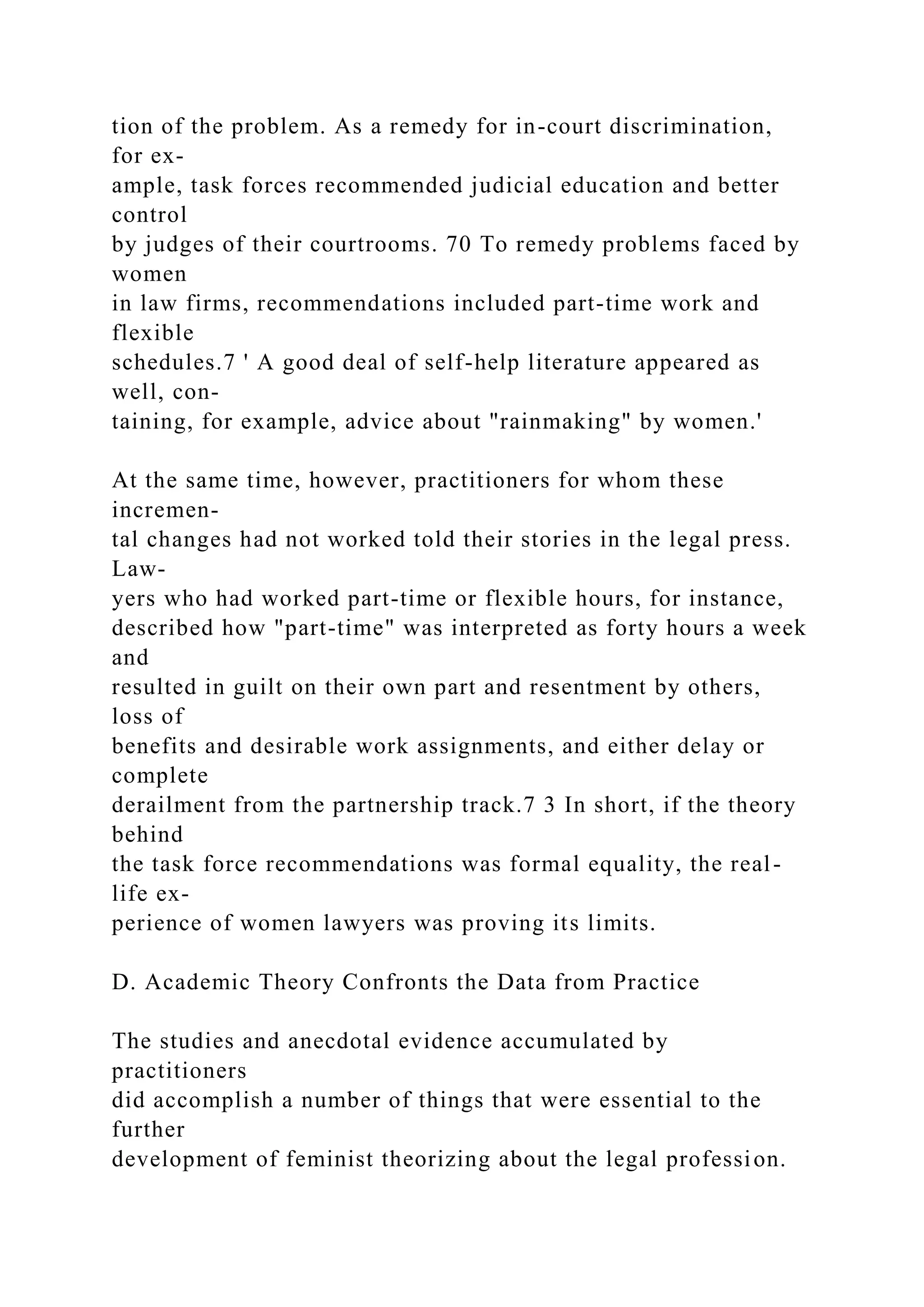
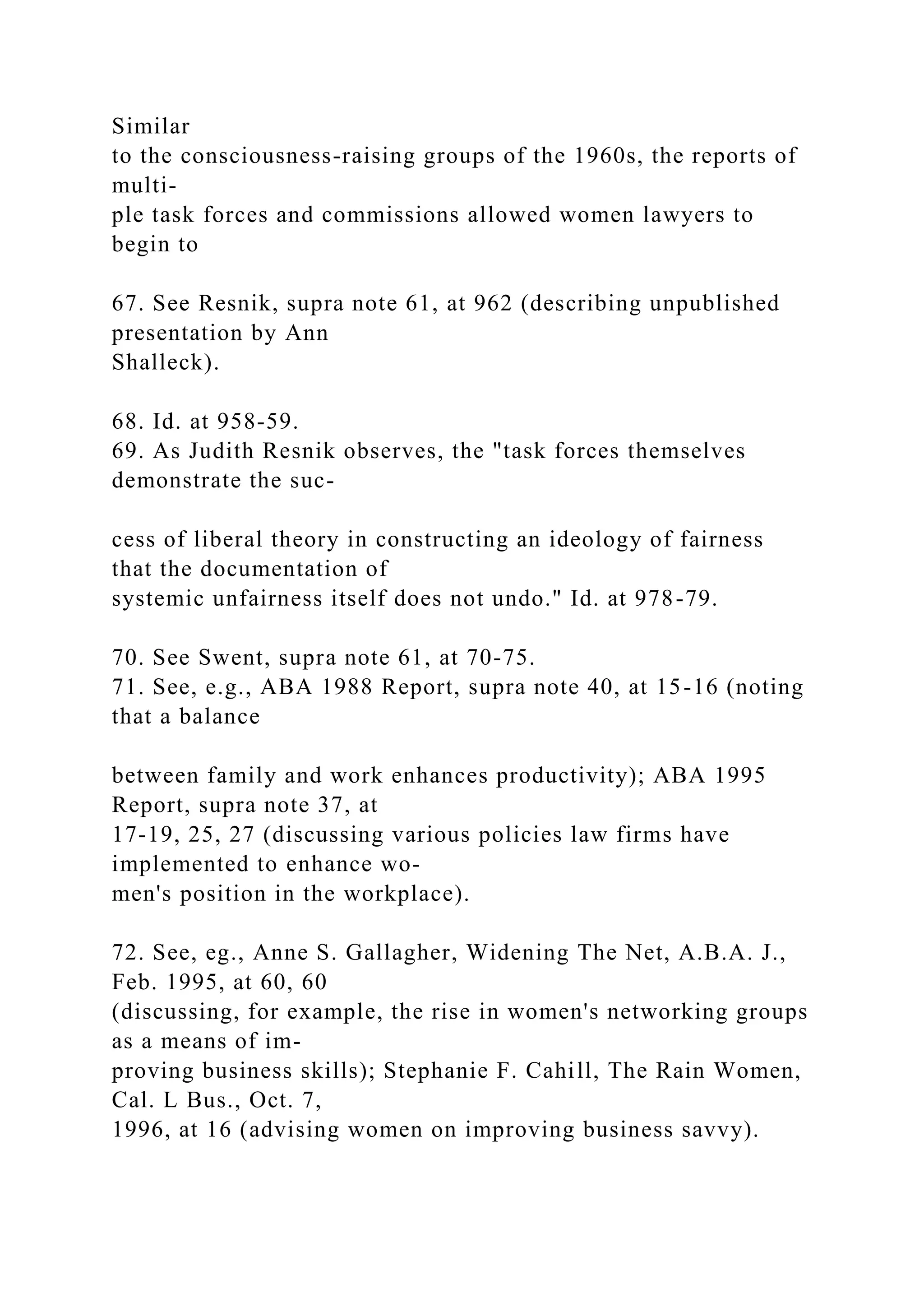
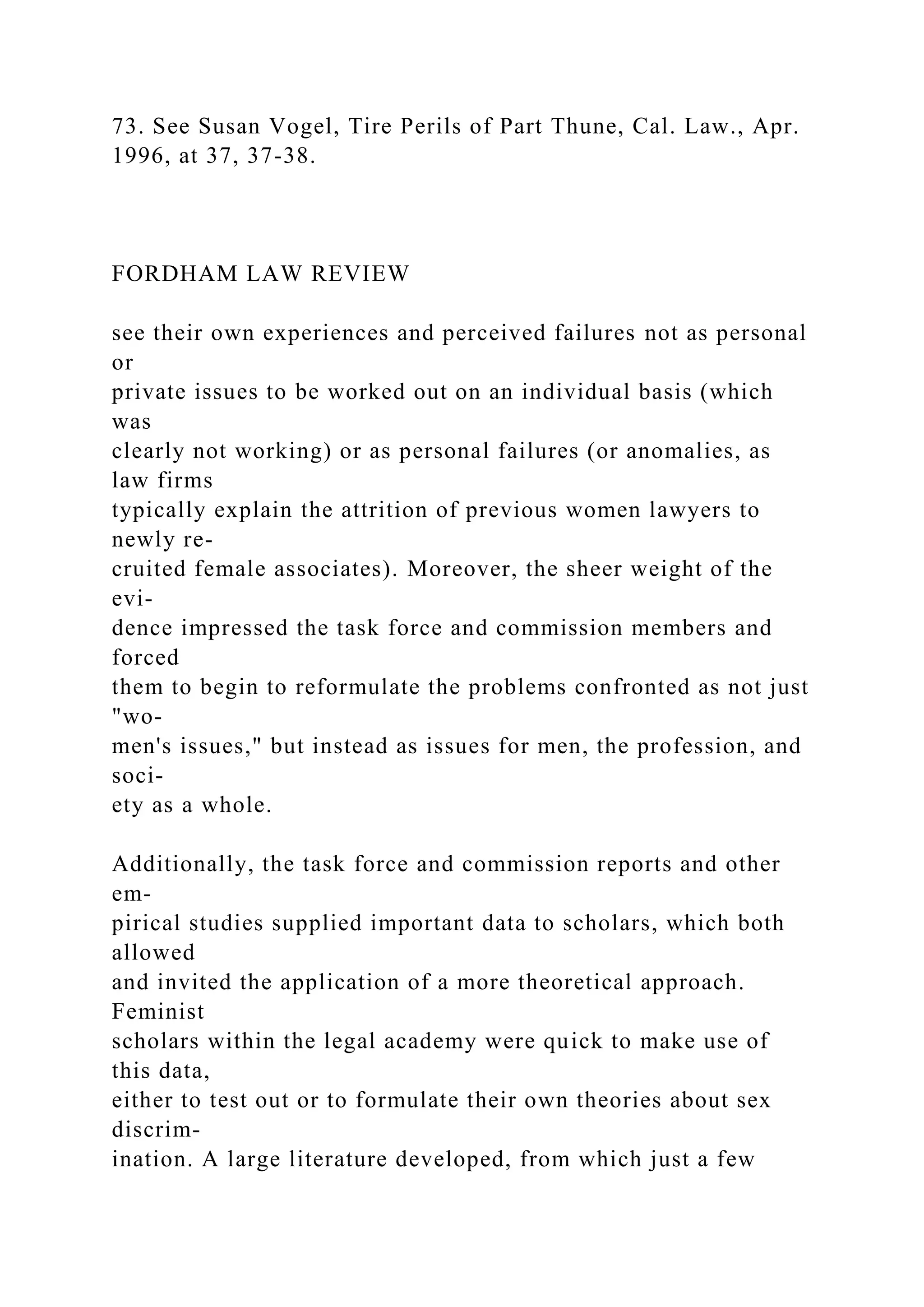
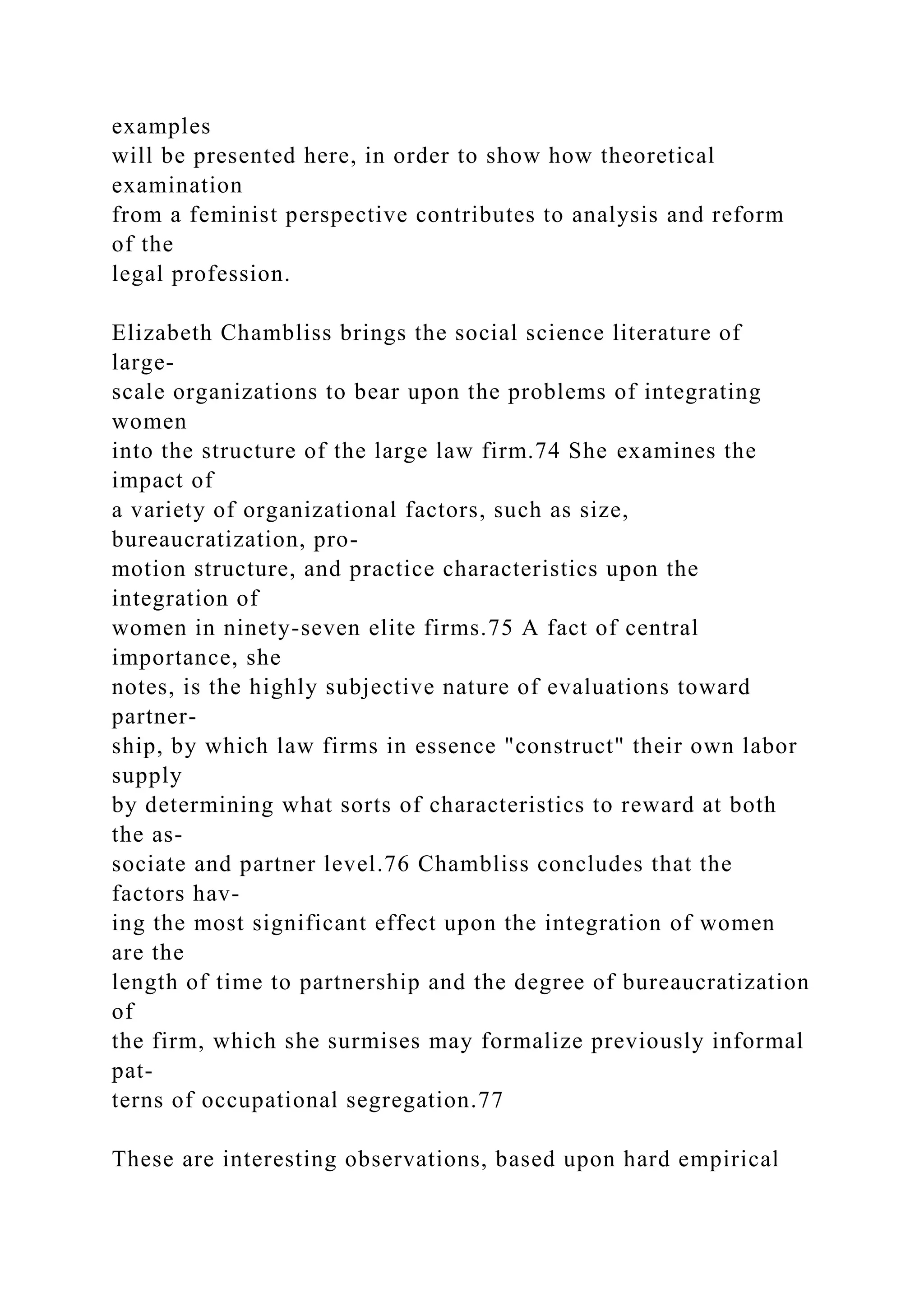
![data
that confirm the problems women have had succeeding in the
struc-
ture of large law firms. But what follows from this analysis?
Should
all law firms adopt longer partnership tracks? How is this to
happen?
Who or what will bring about the desired changes? Individual
law
74. See Elizabeth Chambliss, Organizational Determinants of
Law Firm Integra-
tion, 46 Am. U. L. Rev. 669 (1997) (discussing race as well as
gender integration).
75. See id. at 673-78.
76. See id. at 692-93; see also Commission on Women in the
Profession, American
Bar Ass'n, Fair Measure: Toward Effective Attorney
Evaluations 21-24 (1997) (rec-
ommending a process for "gender fair and effective
evaluation[s]," including valuing
multiple styles of work, structuring evaluation instruments and
interviews so both op-
erate more fairly, and including women in all phases and
aspects of the evaluation
process).
77. See Chambliss, supra note 74, at 728-30.
[Vol. 67
1998] FEMINIST LEGAL THEORY & LAWMAKING 265](https://image.slidesharecdn.com/twomodelsofthecriminalprocessherbertl-221102051712-61a17231/75/Two-Models-of-the-Criminal-ProcessHERBERT-L-PACKERSource-R-docx-73-2048.jpg)
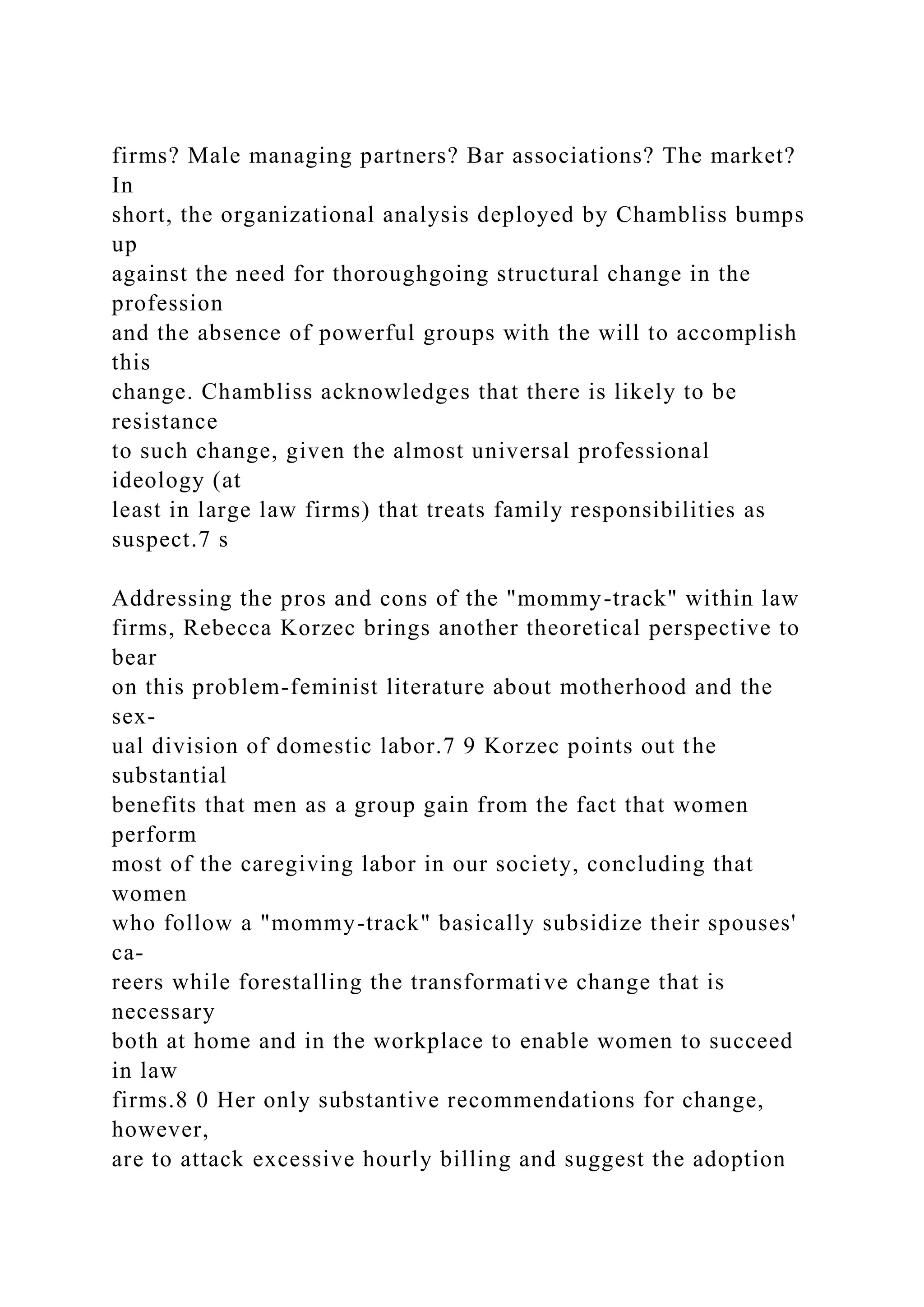
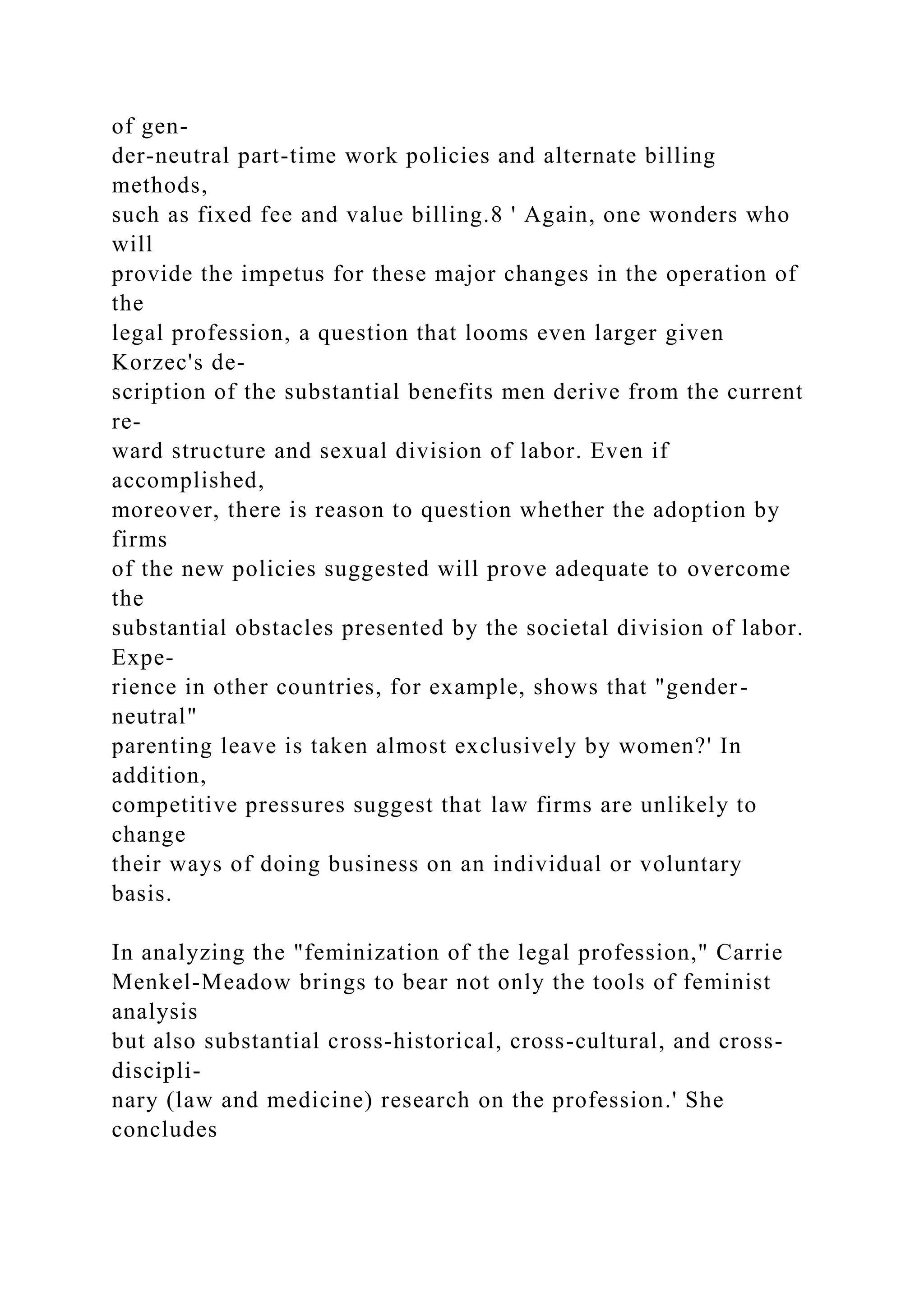
![78. See id. at 741.
79. See Rebecca Korzec, Working on the "Moininy-Track":
Motherhood and Wo-
men Lawyers, 8 Hastings Women's L.J. 117 (1997).
80. See id. at 124-27.
81. See id. at 136-37.
82. See Jennifer Schirmer, Maternity Leave Policies: An
International Survey:
Sweden, 11 Harv. Women's L.J. 185, 186 (1988) (reporting that
very few men in Swe-
den took advantage of a gender-neutral and very generous
parental leave policy).
83. See Carrie Menkel-Meadow, Exploring a Research Agenda
of the Feminization
of the Legal Profession: Theories of Gender and Social Change,
14 L & Soc. Inquiry
289 (1989) [hereinafter Menkel-Meadow, Exploring a Research
Agenda]; see also Car-
rie Menkel-Meadow, The Comparative Sociology of Women
Lawyers: The "Ferniniza-
tion" of the Legal Profession, 24 Osgoode Hall L.J. 897 (1986).
FORDHAM LAW REVIEW
that for change to occur, it is necessary to explode the dominant
para-
digms not only of the legal profession but also of research about
it. It
is a mistake, she believes, to concentrate research and writing
on large
law firms or to focus on the "mommy-track" and other](https://image.slidesharecdn.com/twomodelsofthecriminalprocessherbertl-221102051712-61a17231/75/Two-Models-of-the-Criminal-ProcessHERBERT-L-PACKERSource-R-docx-76-2048.jpg)
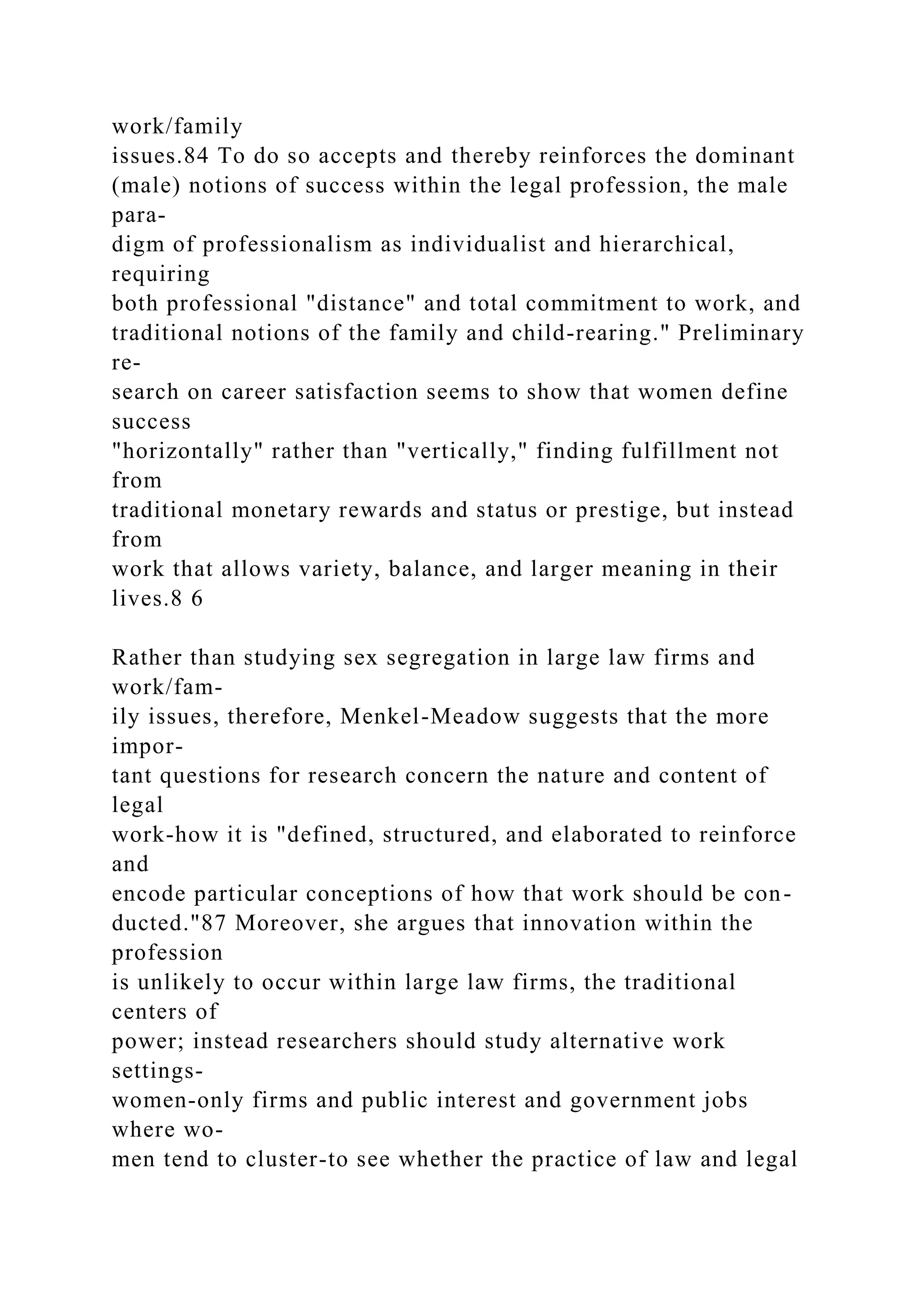

![[Vol. 67
1998] FEMINIST LEGAL THEORY & LAWMAKING 267
1. Women's Law Firms
In a book originally published in 1981, Cynthia Fuchs Epstein
de-
scribed the feminist law firms that were established in the
1970s.9 A
number of women's firms were established in New York City,
in-
tending to serve women, democratize attorney-client relations,
and es-
tablish egalitarian working communities. 0 Before the decade
had
ended, however, these firms had all closed their doors, despite
consid-
erable success in their legal work. The practices foundered for a
vari-
ety of reasons, according to Epstein, many of them economic.
The
feminist lawyers were ambivalent about making money, took
many
clients who couldn't pay fees, and had trouble attracting fee-
paying
business other than family law cases. 91 The egalitarian
structure of
their law offices led to stress and resentment among attorneys
and
staff alike; moreover, women lawyers establishing the firms
were all
young, creating a dilemma when they began to have children](https://image.slidesharecdn.com/twomodelsofthecriminalprocessherbertl-221102051712-61a17231/75/Two-Models-of-the-Criminal-ProcessHERBERT-L-PACKERSource-R-docx-79-2048.jpg)
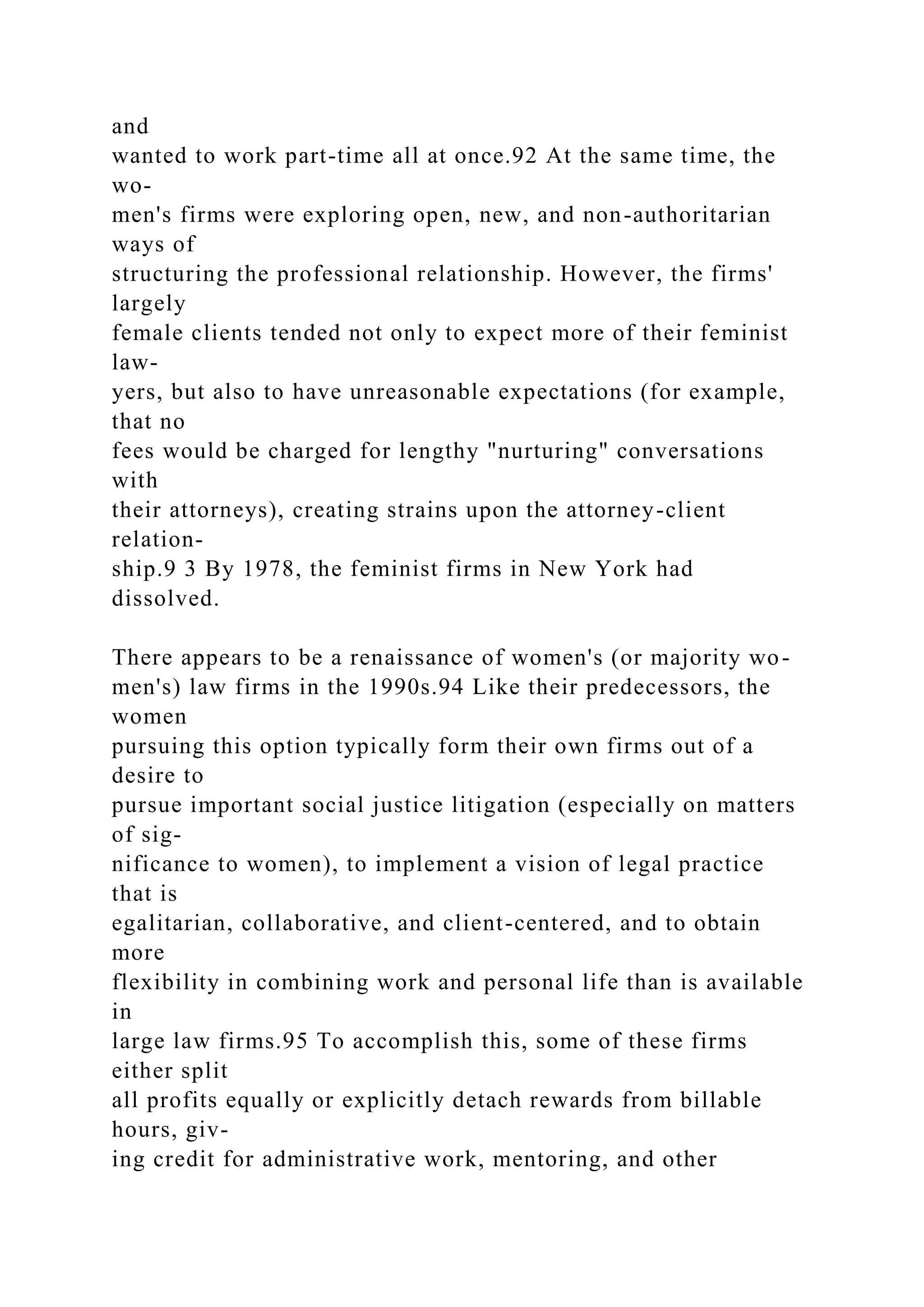
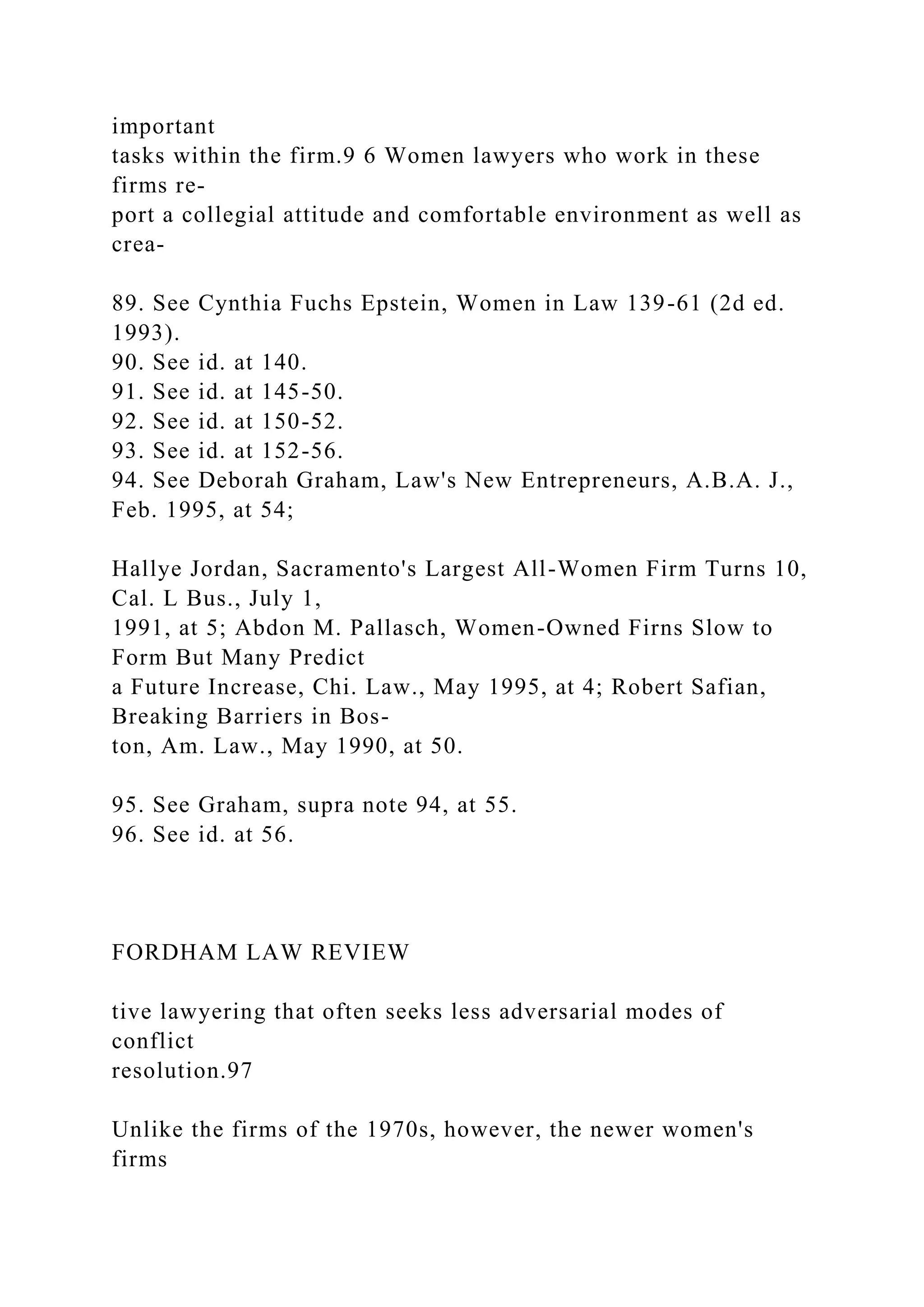
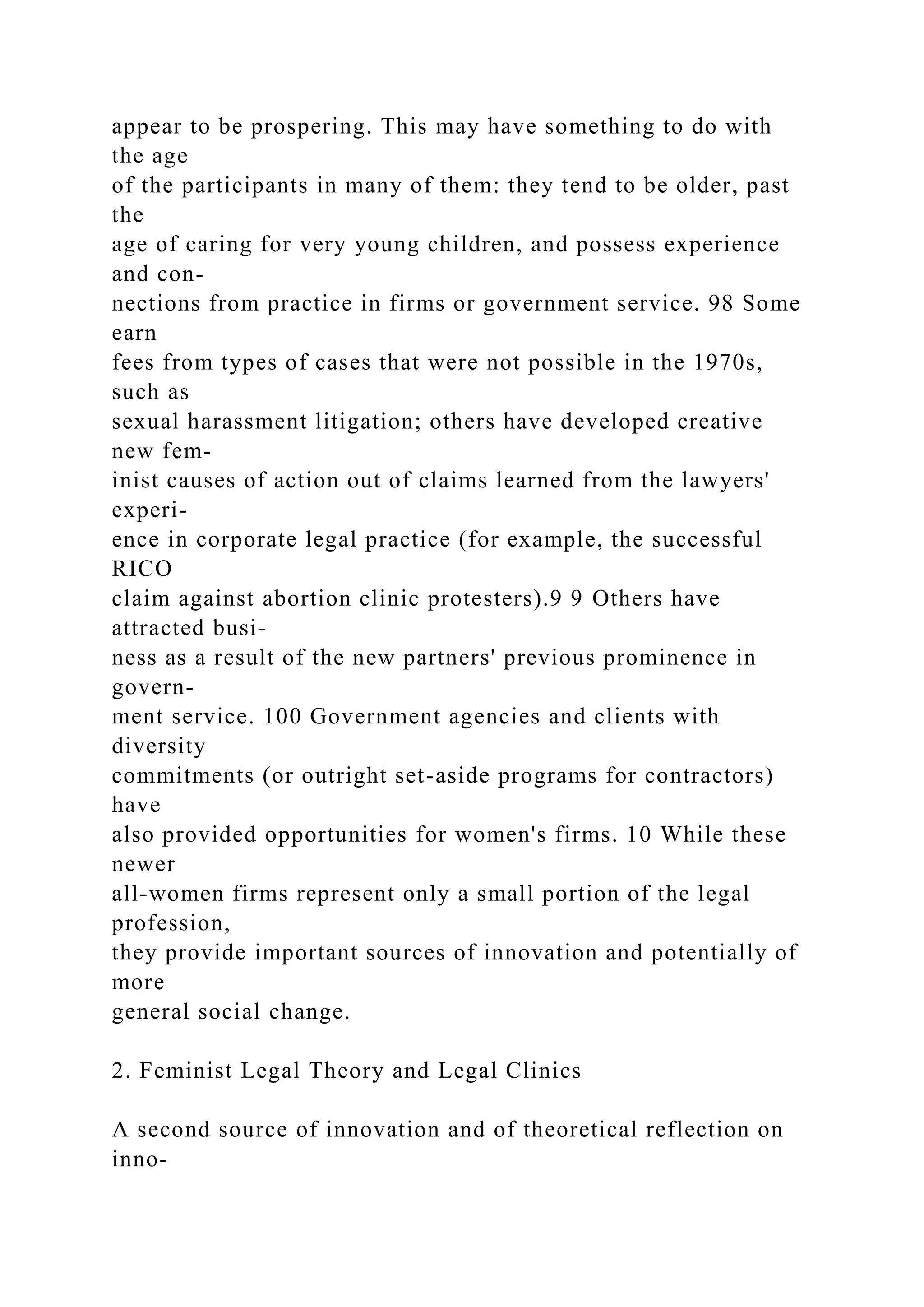
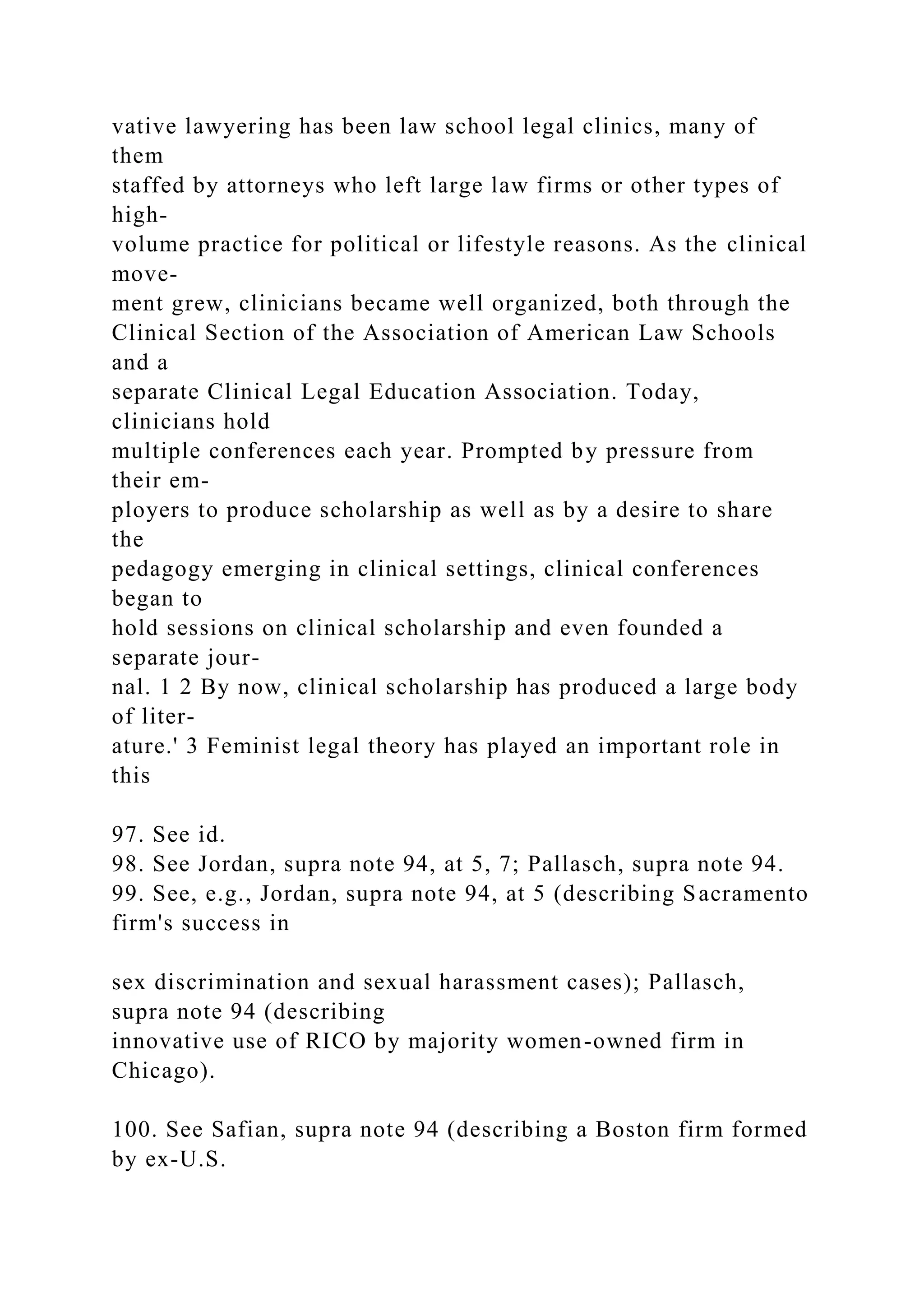
![Attorneys).
101. See Graham, supra note 94, at 56; Pallasch, supra note 94.
102. The Clinical Law Review: A Journal of Lawyering and
Legal Education is co-
sponsored by the Clinical Legal Education Association, the
Association of American
Law Schools, and New York University School of Law.
103. See generally, e.g., Anthony V. Alfieri, Reconstructive
Poverty Law Practice:
Learning Lessons of Client Narrative, 100 Yale L.J. 2107
(1991) (discussing the notion
of poverty law advocacy as a medium of story telling); Clark D.
Cunningham, A Tale
[Vol. 67
1998] FEMINIST LEGAL THEORY & LAWMAKING 269
scholarship throughout the 1990s, undoubtedly because so many
clini-
cians are women."° Indeed, a sizable group of feminist legal
scholars
has emerged from the ranks of clinicians or former clinicians-
includ-
ing both authors of this article.
Some of the earliest scholarship about feminist lawyering
focused
on whether to use feminist arguments and methods in the
practice of
litigation, as was done, for example, in the "Voices Brief' filed](https://image.slidesharecdn.com/twomodelsofthecriminalprocessherbertl-221102051712-61a17231/75/Two-Models-of-the-Criminal-ProcessHERBERT-L-PACKERSource-R-docx-84-2048.jpg)
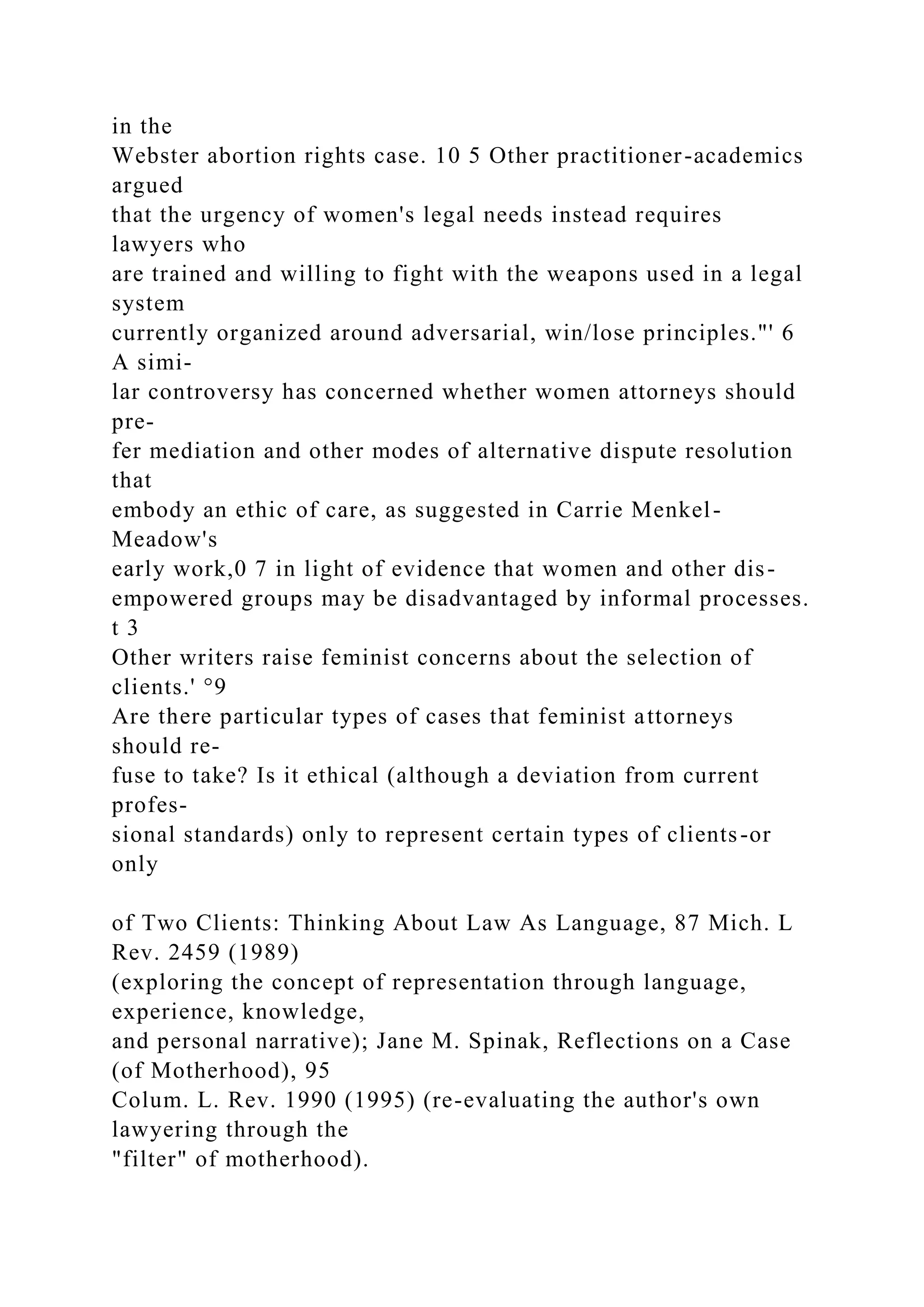
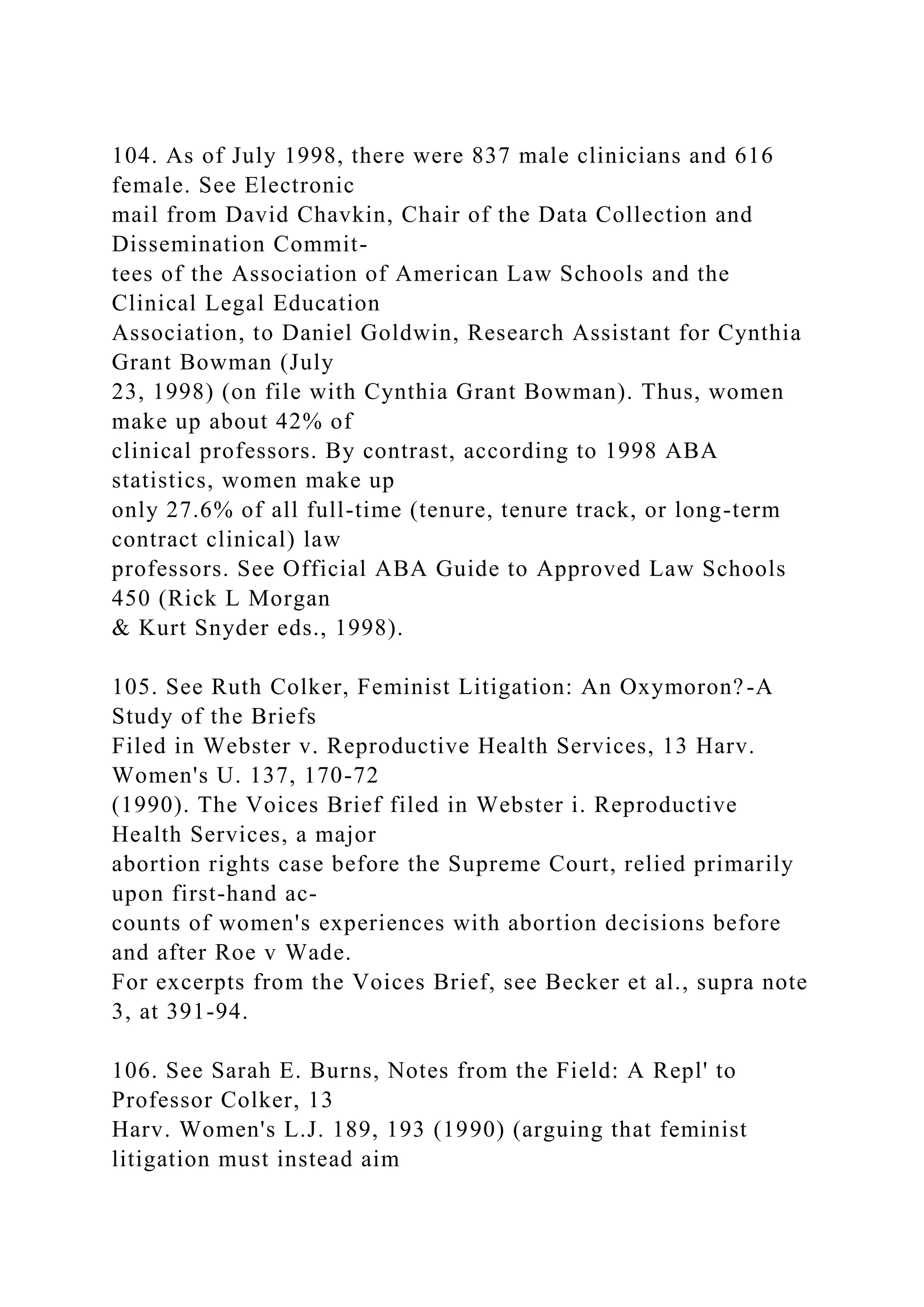
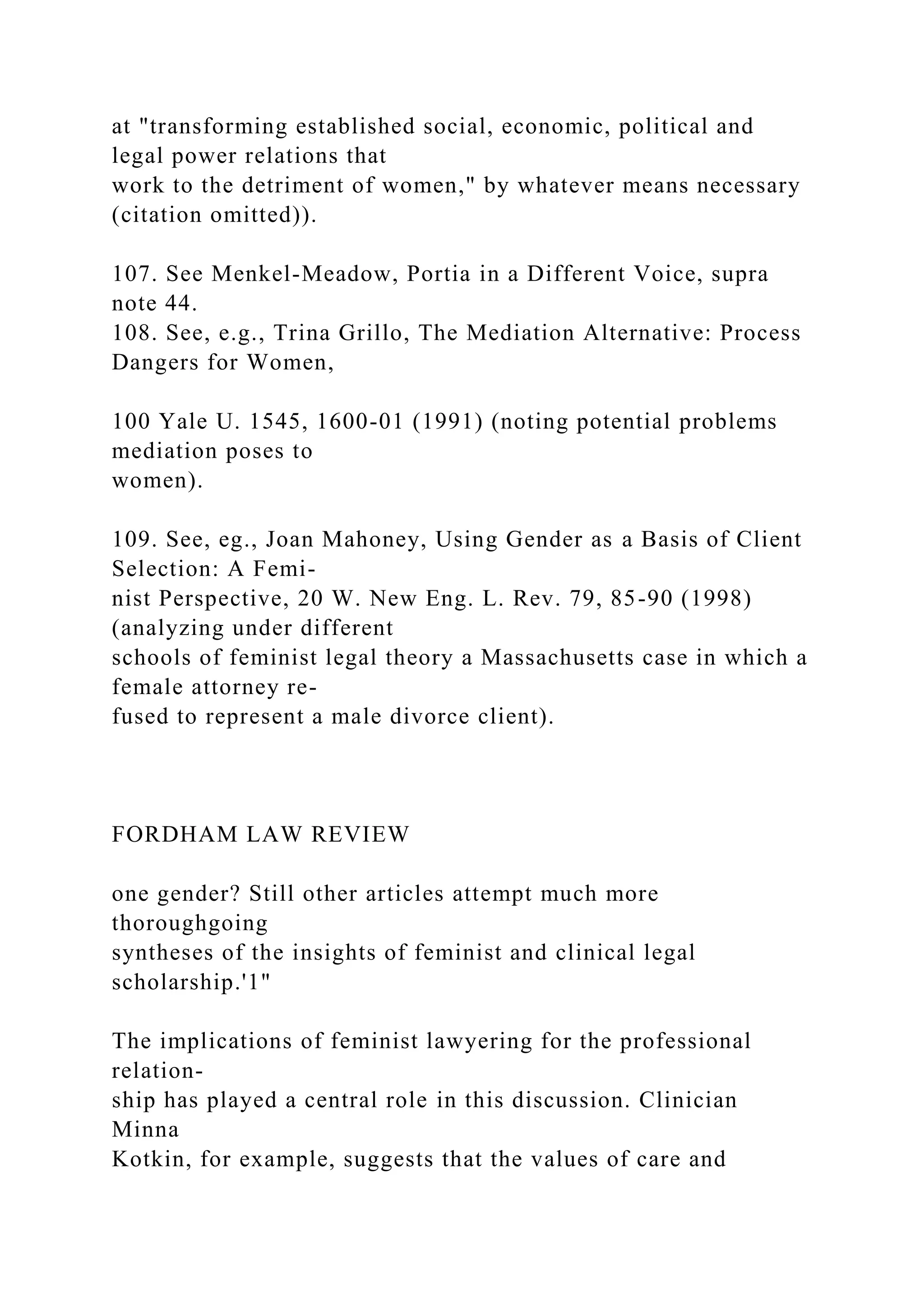
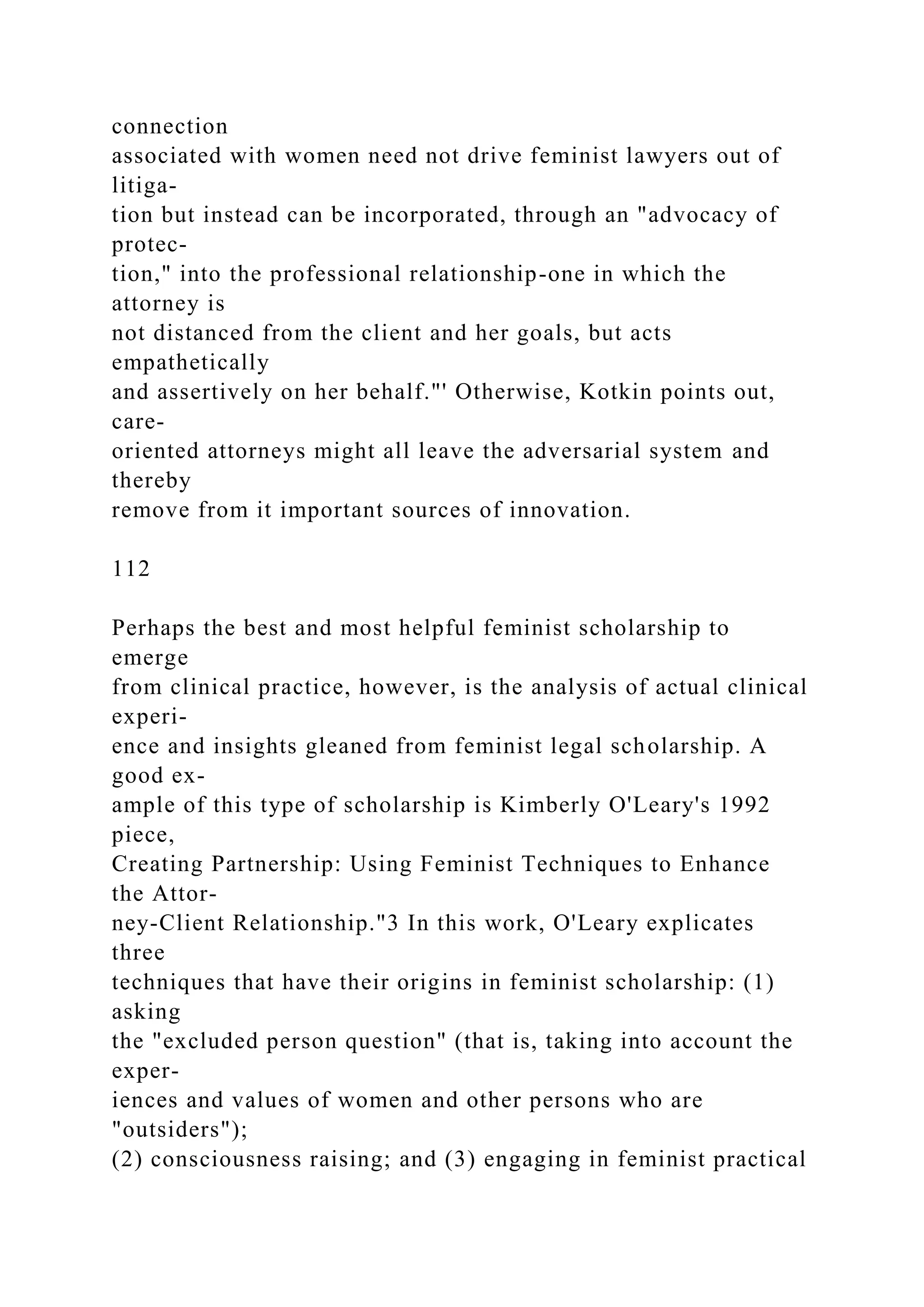

![Interest: The Advo-
cacy of Protection, 8 St. Thomas L. Rev. 157, 169-73 (1995).
112. See id. at 171-72.
113. 16 Legal Stud. F. 207 (1992).
114. Id. at 212. These techniques were described originally in
Katharine T. Bart-
lett, Feminist Legal Methods, 103 Harv. L. Rev. 829 (1990).
115. See O'Leary, supra note 113, at 207-09, 221-22. The client
wanted custody or
visitation with a child she had not seen for more than four
years, but only succeeded
in preventing the child's adoption by the father's wife and
obtaining brief supervised
[Vol. 67
1998] FEMINIST LEGAL THEORY & LAWMAKING 271
have enabled O'Leary to counsel her client more realistically
that
those goals could not ultimately be fulfilled by the legal
system." 6
O'Leary's article reflects an amalgam of theory and practice-
start-
ing from frustrations that arose out of practice, applying
feminist the-
ory, reflecting upon the results, and then drawing conclusions
about
the attorney-client relationship, the appropriate professional
distance,](https://image.slidesharecdn.com/twomodelsofthecriminalprocessherbertl-221102051712-61a17231/75/Two-Models-of-the-Criminal-ProcessHERBERT-L-PACKERSource-R-docx-90-2048.jpg)
